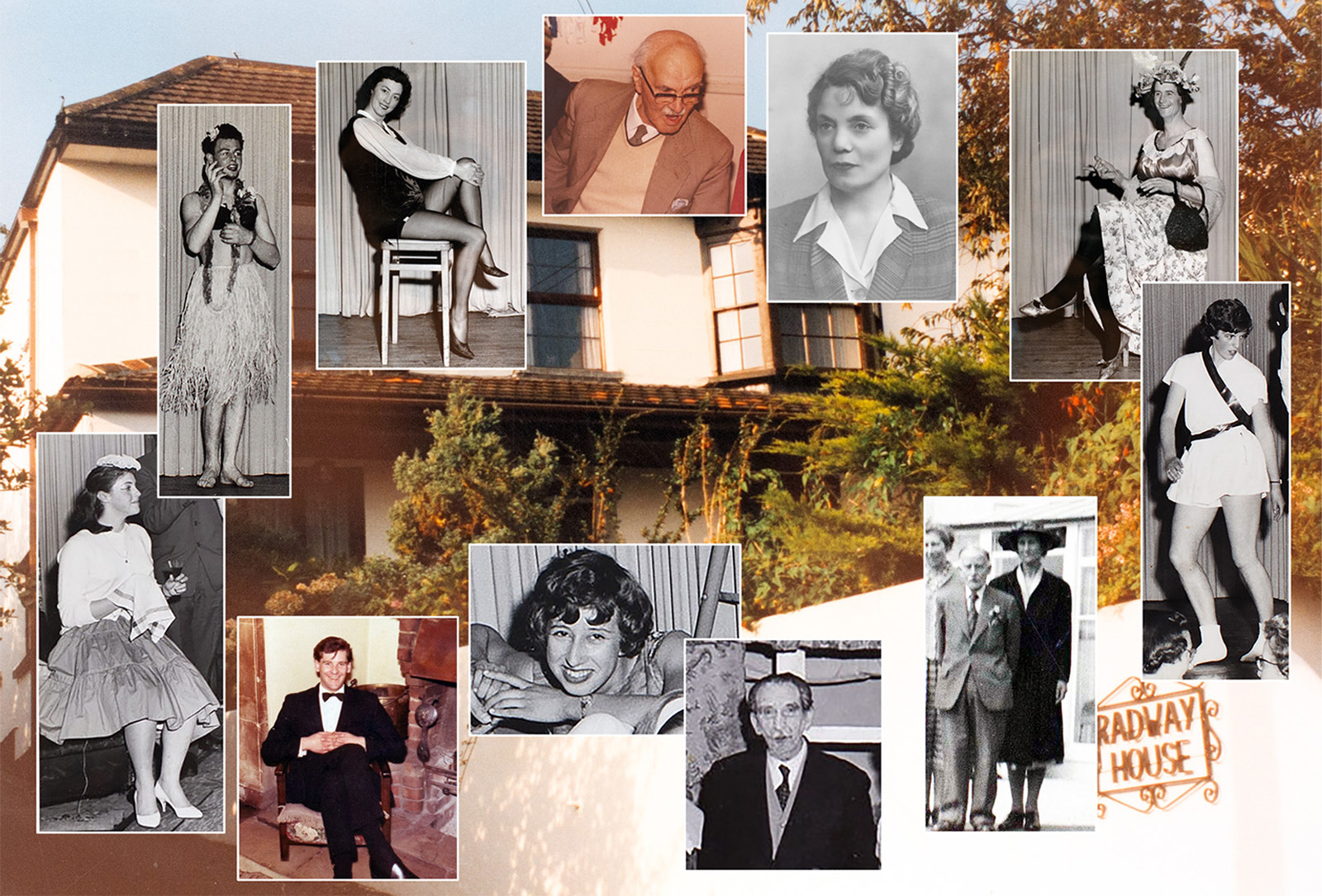
Poster Bishopsteignton Players where it all began
In September 1959 a meeting of those interested in starting a village drama group was held at Radway House, Radway street, courtesy of Colonel and Mrs Rooth. Those attending this meeting (clockwise from top in the above picture) were: Bob Caldwell, Jane Caldwell, Edward Perkin, Diana Maraga, Colonel and Mrs Rooth, Jim Hately, Wendy Cowling, Colin Back, Liz Watkinson, Ray Watkinson and Sheila Robinson. A committee in 1960 was set up to form and develop a drama group, of which discussions lead to Sheila Robbins, becoming chair and supported by Bob Caldwell and Captain Hately. Bishopsteignton Players was ‘Born’.
Bishopsteignton has always been a very enthusiastic village when it comes to putting on entertainments and raising money for causes, and back in the 1960s there was loads of energy and interest around for doing just that.
The Bishopsteignton Players were initially all adults, but there were teenagers and children who wanted to get involved too, so the ideal vehicle was a pantomime. The pantos were rehearsed and performed at the village hall, and they raised funds for the village, or a cause that the village chose. Then came ‘Sheila’s Superstars’, doing entertainments that raised the £100 needed to pay for the band at the annual carnival.
This is The Players story in the 1960s.
1961
By May 1961 it was reported in a local newspaper that they had only been in existence for six months and had already put on five productions. We believe the first productions included; ‘The Camel’s Back’, ‘Orange Blossom’, and ‘Ladies in Retirement’.
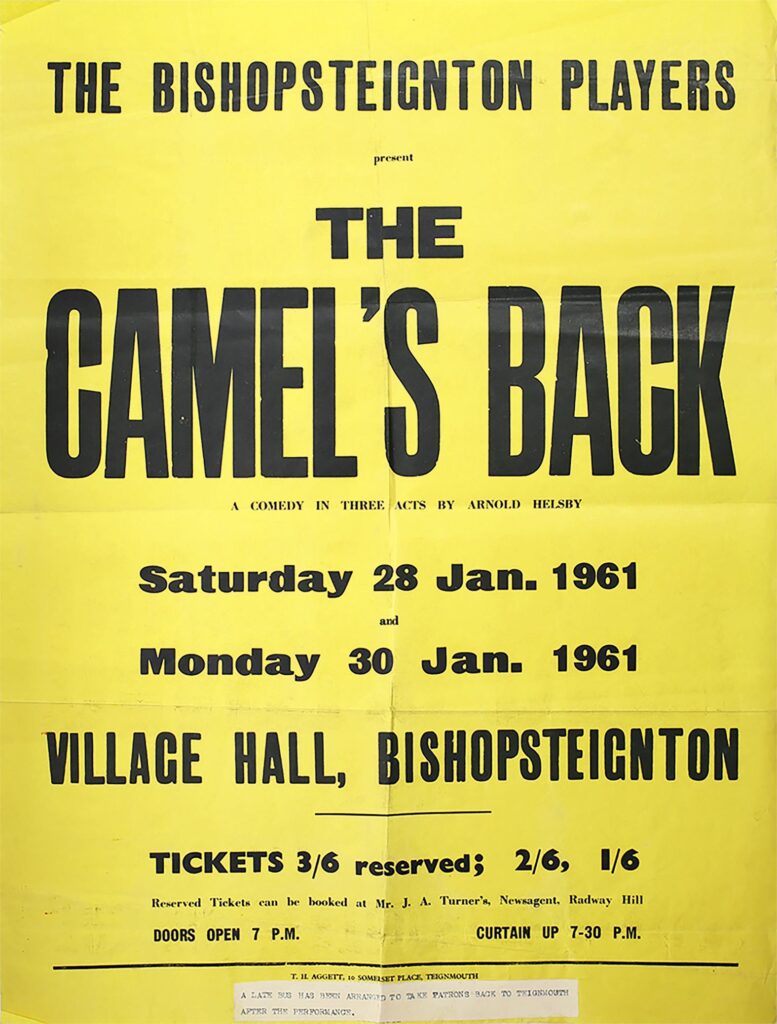
Poster for the play ‘The Camel’s Back’ performed by Bishopsteignton Players.
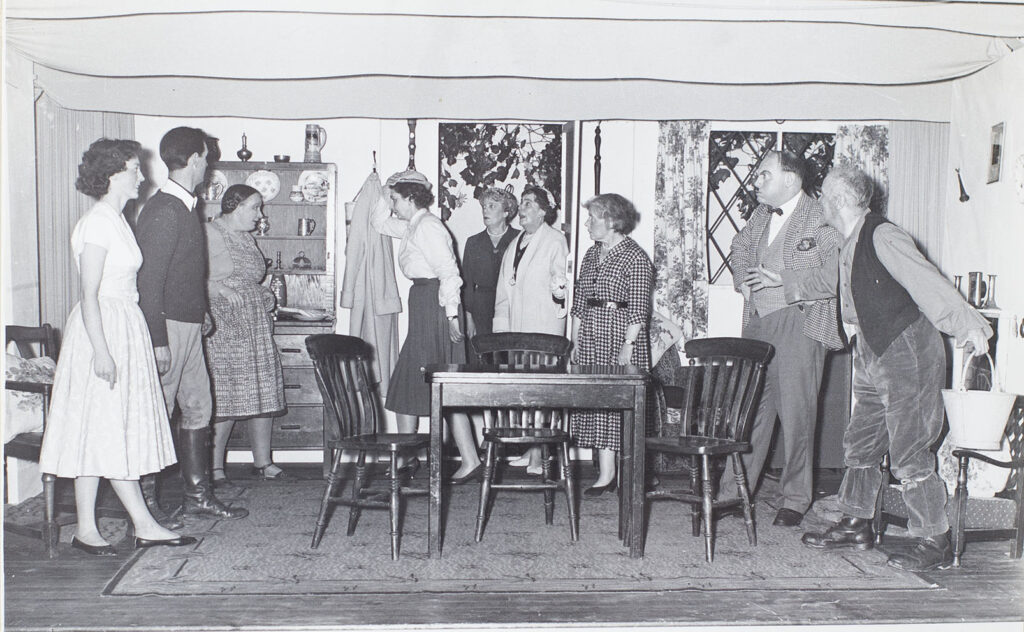
Bishopsteignton Players in a scene from the 1960s play ‘The Camel’s Back’.
‘Orange Blossom’ by Philip Johnson, produced by Bob Caldwell was probably an evening entertainment put on in 1961 by the Players, as a fund raising event at the Village Hall. It was followed by an Easter Bonnet dance.
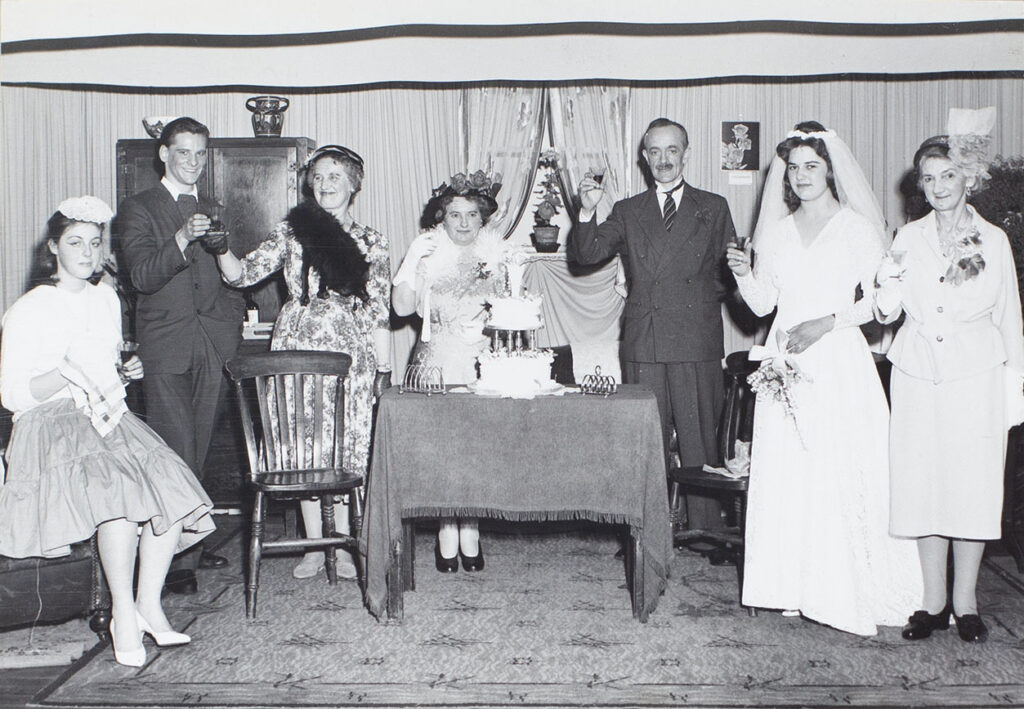
Cast of the play ‘Orange Blossom’ performed by Bishopsteignton Players.
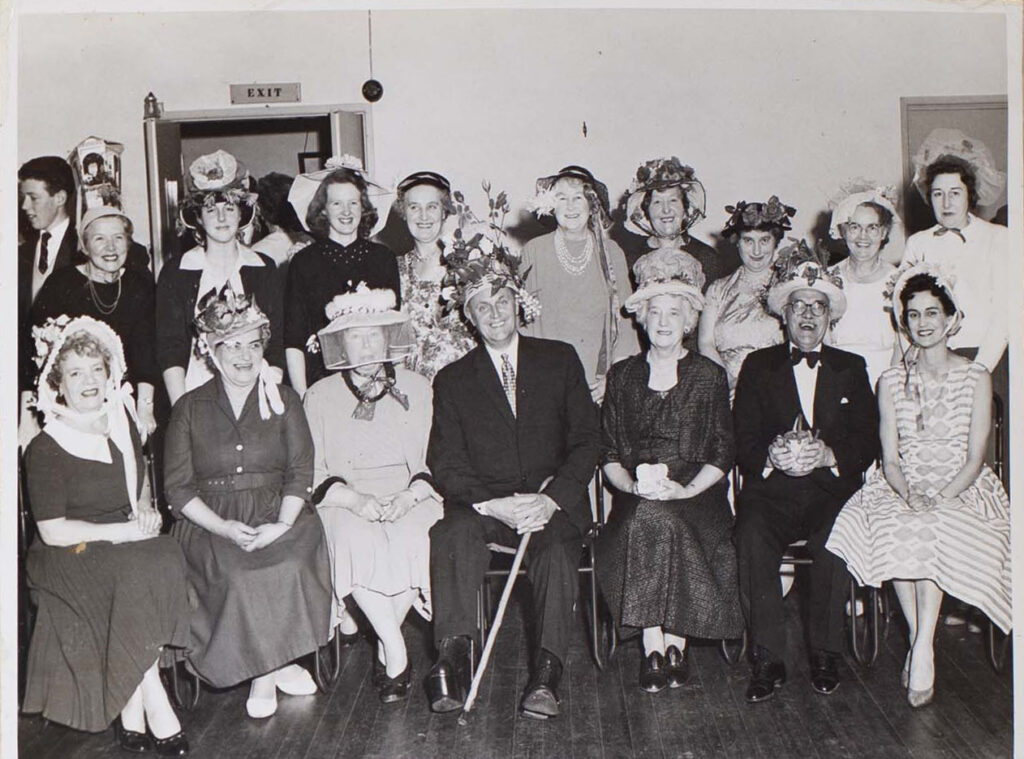
Bishopsteignton Players wearing Easter Bonnets.
The cast included Mararet Agutter, Colin Back, Bessie Martin, Daisy Painter, Henrietta Pote, John Turner, Liz Watkinson. The Stage Manager was Mathew Shadbolt, Prompter, Sheila Robbins, and Wardrobe Mistress, Mrs Gopsill.
In May 1961 the Players presented ‘Ladies in Retirement’ by Edward Percy and Reginald Denham.
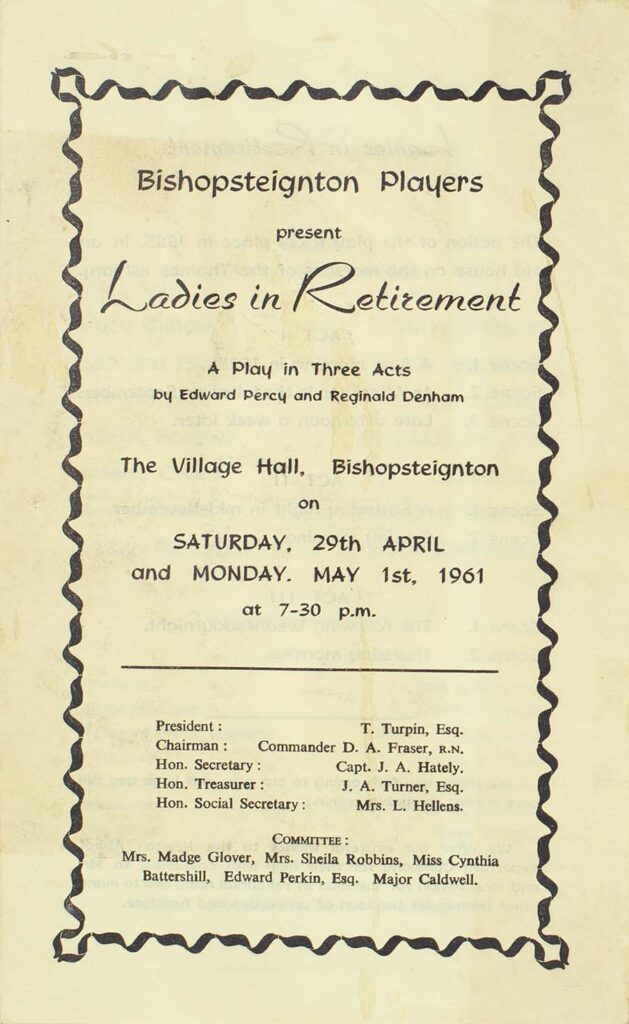
‘Ladies in Retirement’ Programme presented by Bishopsteignton Players.
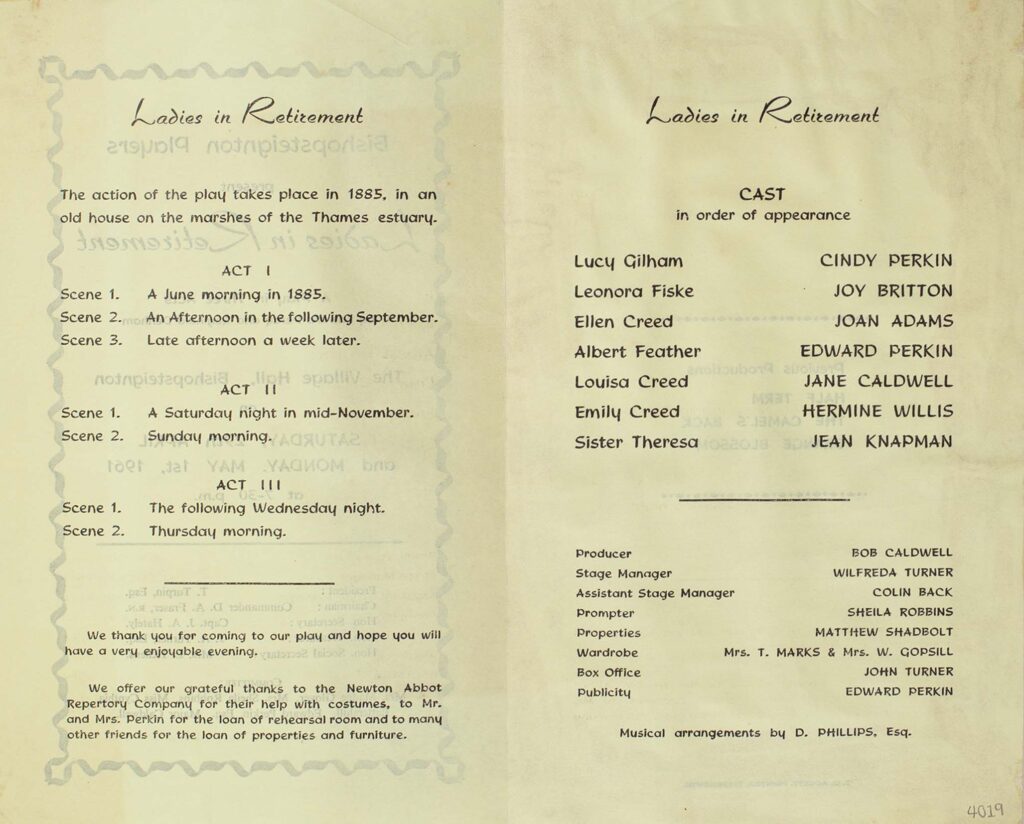
Programme for the play ‘Ladies in Retirement’ presented by Bishopsteignton Players.
Cast included; Joan Adams, Joy Britton, Jane Caldwell, Hermine Willis, Edward Perkin, Cindy Perkin and Jean Knapman as Sister Theresa.
A large and appreciative audience watched two nights of this, the company’s fifth production in their six months of existence. Bob Caldwell produced the three act play by Edward Percy and Reginald Denham, set in 1885, which captured the atmosphere of an isolated house on the Thames marshes. Set, costumes and lighting were all mentioned with praise in the local press review, and the cast was described as ‘all round excellent’. Led by Joan Adams as Ellen Creed, a woman with a secret, and Joy Britton as Leonora Fiske, a retired actress reliving her youthful conquests. Ellen’s two sisters. Louisa and Emily were played with aplomb by Jane Caldwell and Hermine Willis.
The Stage Manager was Wilfreda Turner, Asst, Colin Back, Prompt, Sheila Robbins, Props, Mathew Shadbolt, Wardrobe, Mrs Marks and Mrs Gopsill, Box Office, John Turner, Lighting, Jack Pugh, Musical arrangements, Mr D Phillps.
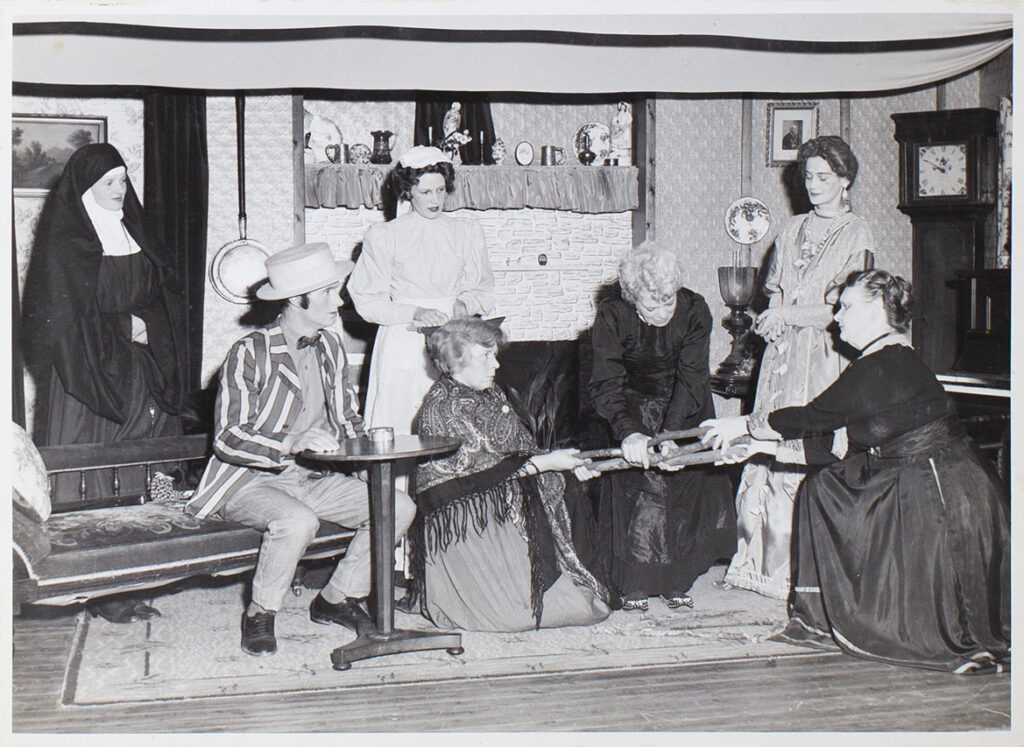
Cast in the play ‘Ladies in Retirement’ presented by Bishopsteignton Players 1961.
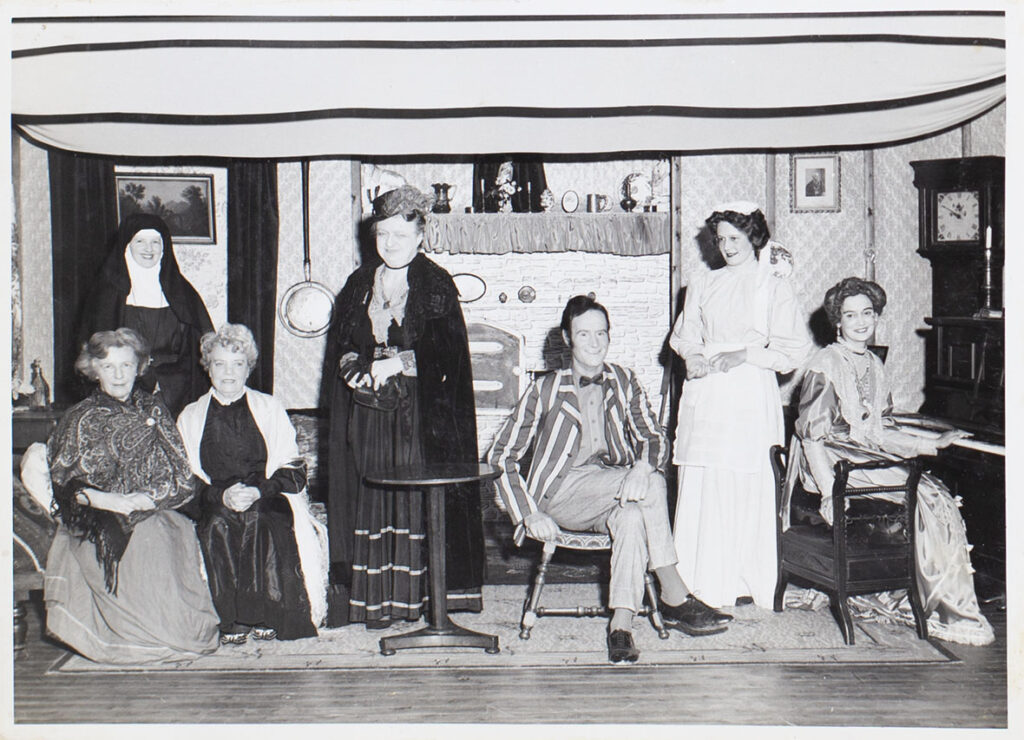
Cast in a sceme form the play ‘Ladies in Retirement’, performed by Bishopsteignton Players 1961.
‘Out Patients’, a one act play by Margaret Wood, was performed in October 1961. This was possibly another in house entertainment for the players to raise funds and encourage people to join, as it was followed by a ‘Wild West’ dance.
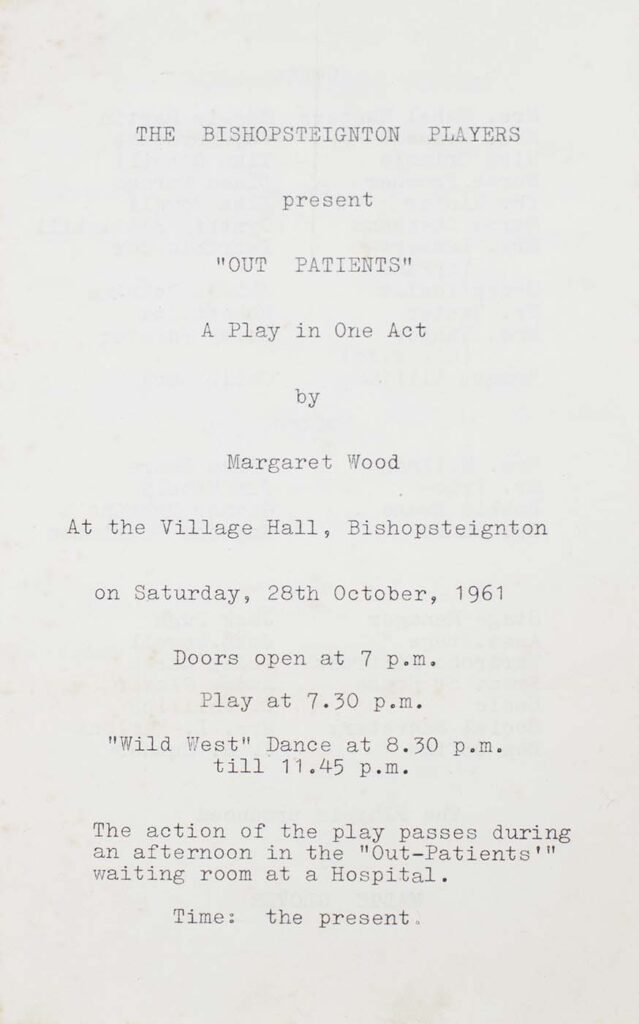
‘Out Patients’ Programme performed by Bishopsteignton Players.
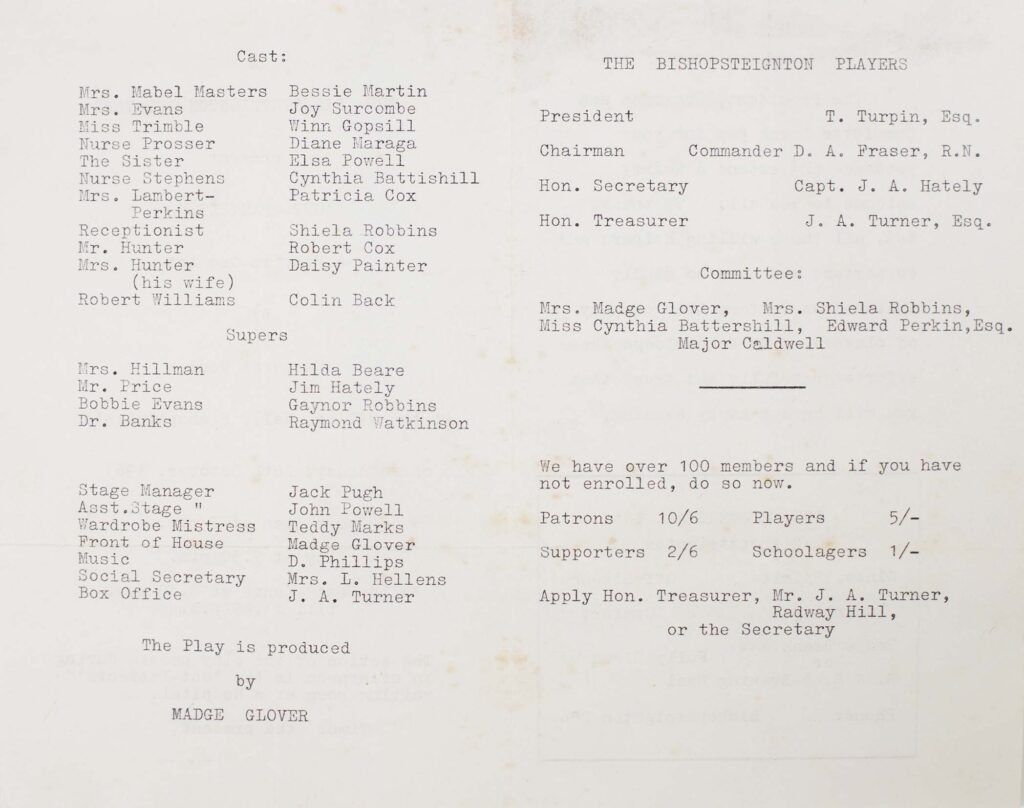
Out Patients Programme performed by Bishopsteignton Players.
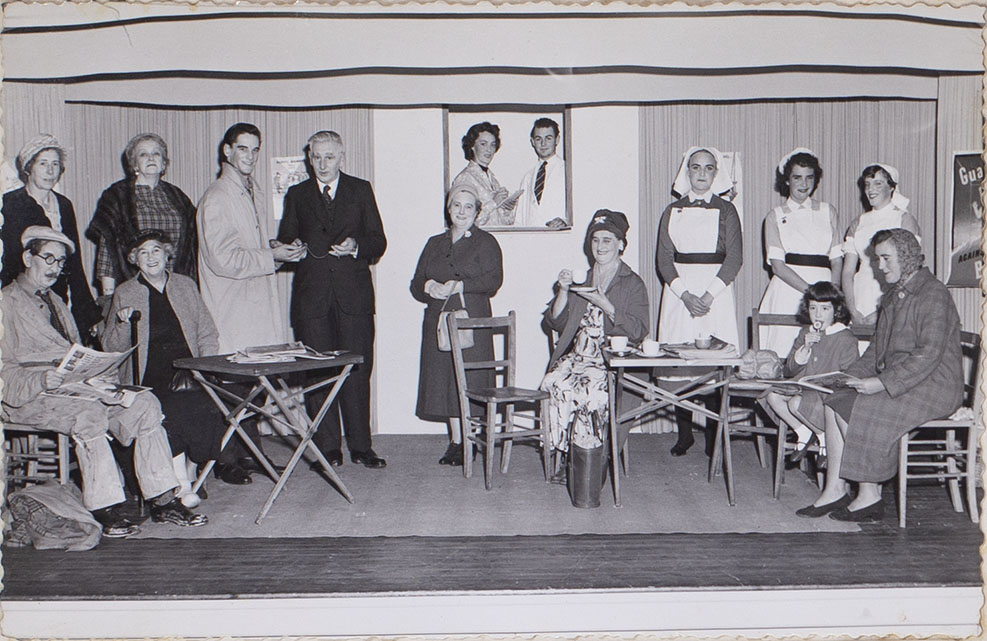
Cast in the play ‘Out Patients’ presented by the Bishopsteignton Players.
To finish the season for 1961 the Players presented ‘The Blue Goose’, a three act comedy by Peter Backmore, in December.
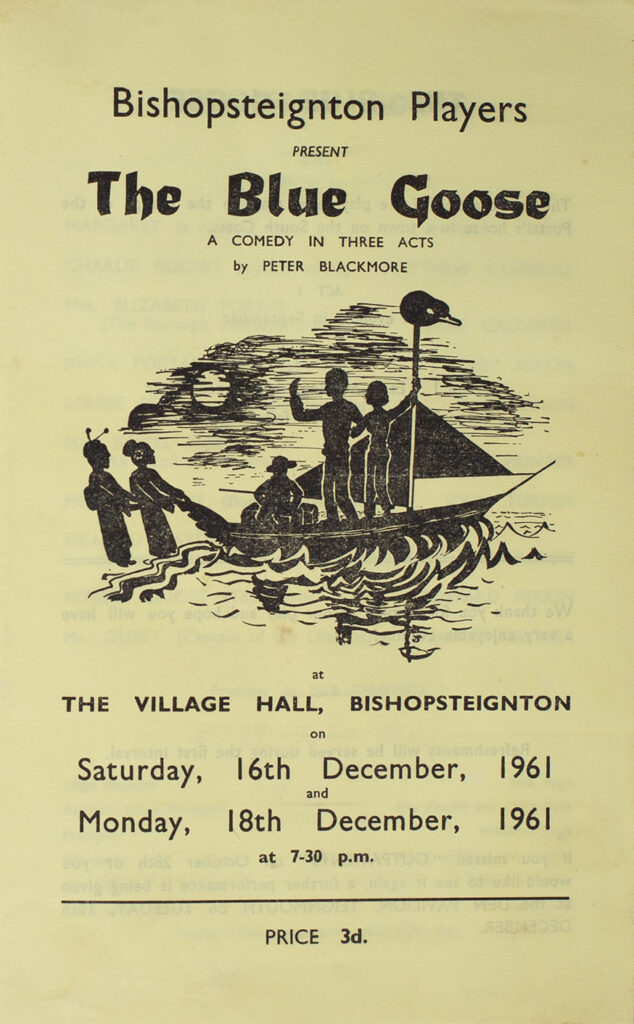
Programme for the play ‘Blue Goose’ presented by the Bishopsteignton Players.
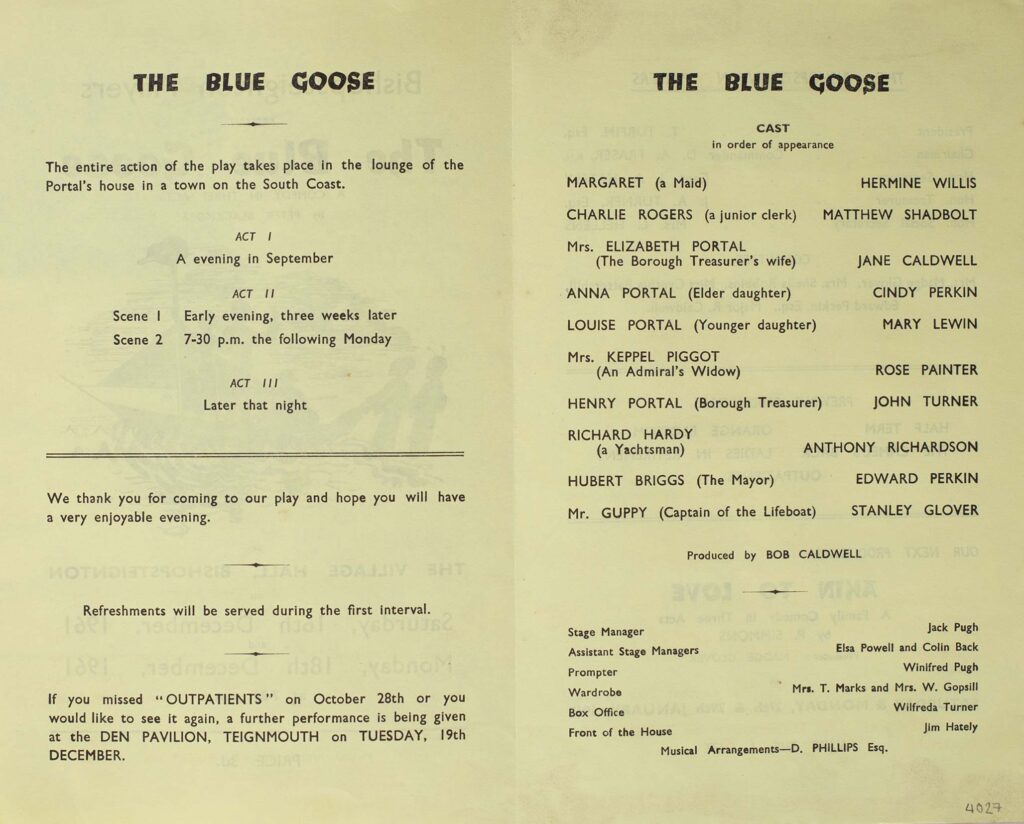
Programme for the play ‘The Blue Goose’ presented by Bishopsteignton Players.
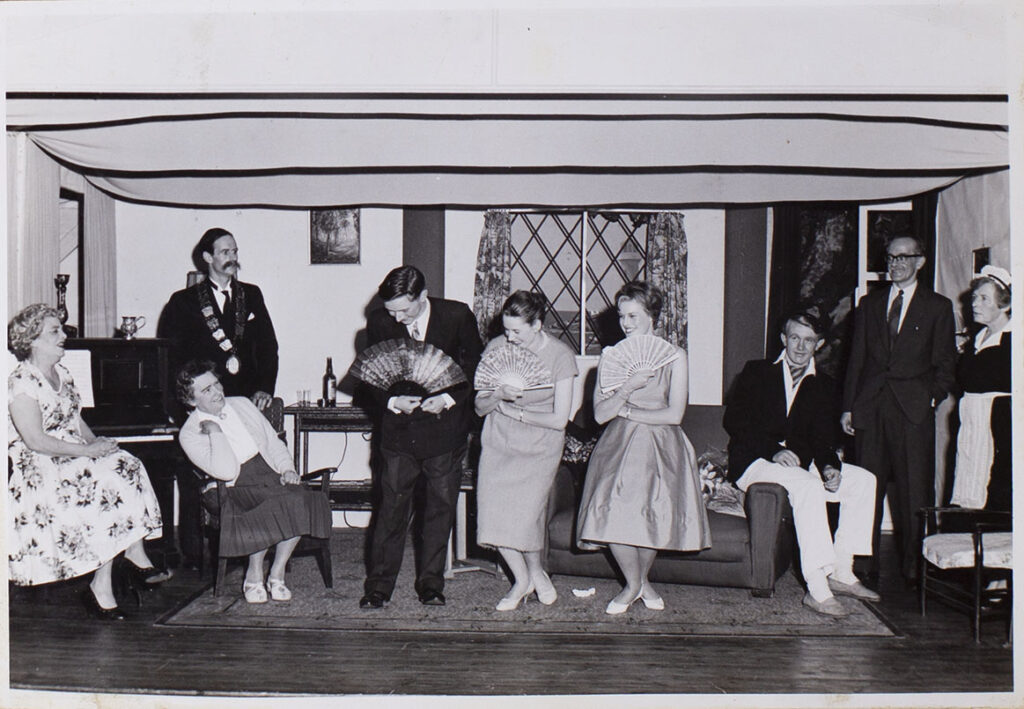
Cast in a scene from the play ‘The Blue Goose’ presented by Bishopsteignton Players in 1961.
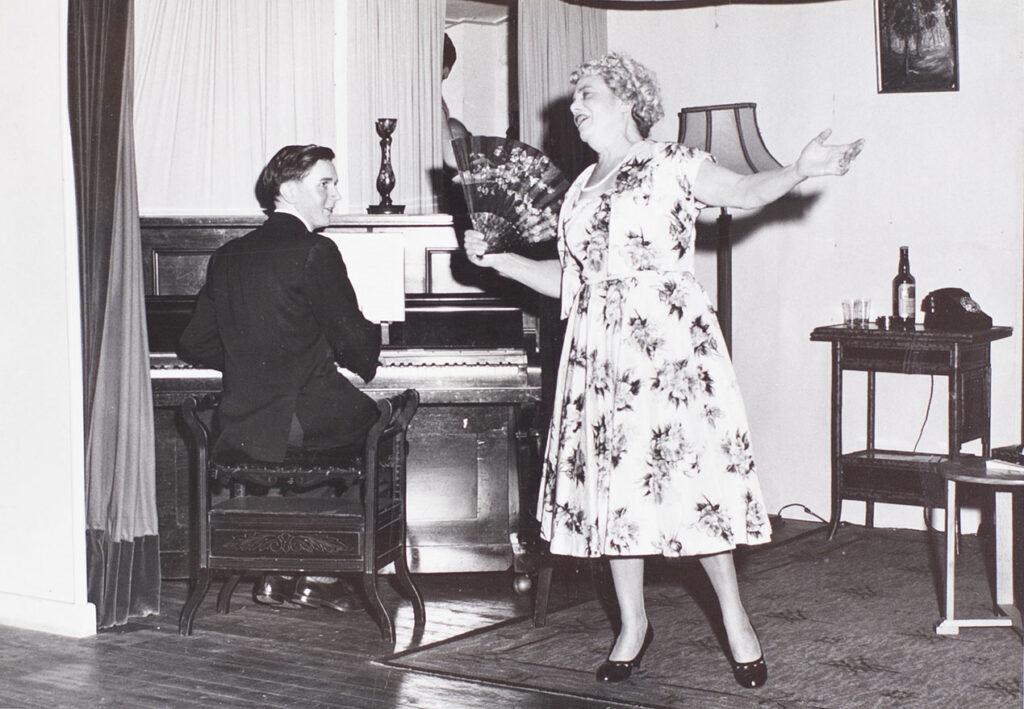
Mathew Shadbolt and Jane Caldwell in The Blue Goose 1961.
Described in the press review as ‘a presentation which sustained a combination of humour and excitement.’ The plot revolved around the life of Louise Portal, played by Mary Lewin, a young woman dominated by her mother whose only interest is in playing in Gilbert and Sullivan operas and her sister Anna, played by Cindy Perkin, whose main concern is to further the social standing of her fiancé, a small-town mayor, played by Edward Perkin.
Jane Caldwell played the opera obsessed Mrs Elizabeth Portal and Richard Hardy, an adventurous yachtsman and owner of the Blue Goose, the eponymous boat, with whom Louisa elopes, was played with ‘fire and enthusiasm’ by Anthony Richardson. One of the most admirable scenes of the play is when the Blue Goose drifts away in a storm with only Louisa on board, involving the calling out of the lifeboat during a performance of The Mikado in which the lifeboat crew were taking part. Sound effects came in for special mention for the maroons booming through the howling of the wind during the storm.
Other parts were played by Mathew Shadbolt as a junior clerk, Rose Painter as Mrs Keppel Piggot, the admiral’s widow, a performance described as ‘a gem’, John Turner as Henry Portal and Hermine Willis as the morose maid, Margaret. The play was produced by Bob Caldwell.
1962
1962 started with the performance of ‘Akin To Love’ and was described as a family comedy.
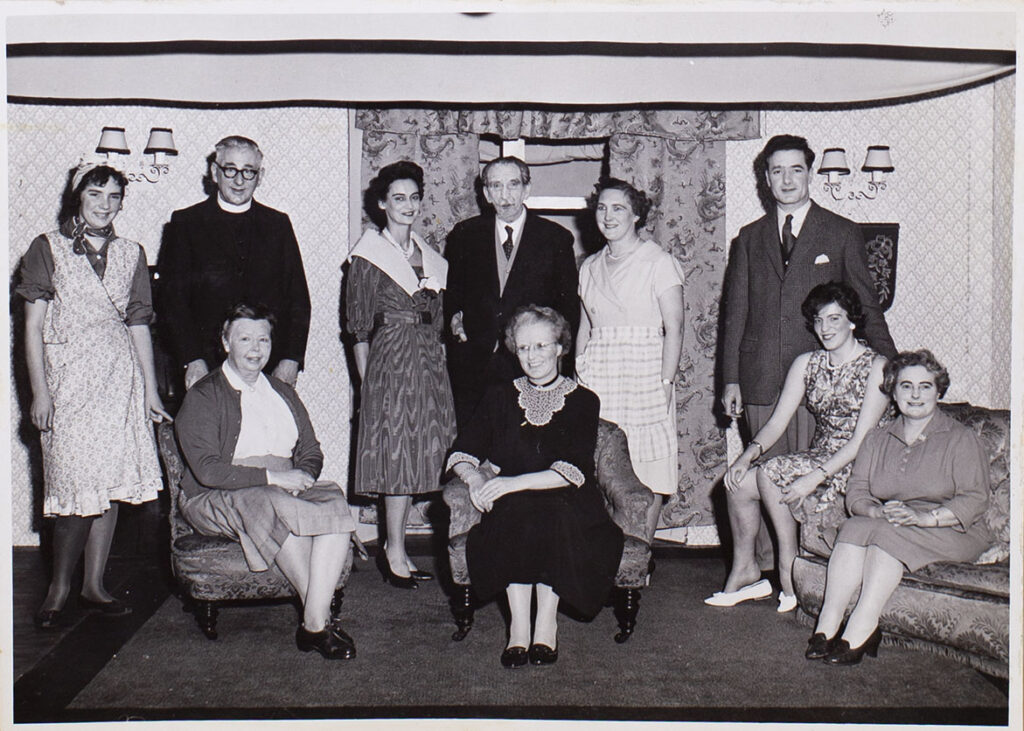
Photograph of cast members in a scene from the play ‘Akin to Love’ presented by the Bishopsteignton Players 1961/1962.`
It was noted in a newspaper article that Cynthia Batterhill playing Florrie, was delightful as the talkative maid. The character Elizabeth Allen played by Joy Surcombe was convincing as someone who is ‘tied to the apron strings of her elderly parents’ but craved for love and the opportunity to get out into the world. Joy Britton who joined the cast at short notice gave a refined and sophisticated performance as the ‘man eating’ woman, Prudence Bennett.
Diane Moraga was lively in her role as Sally, with both Joy Surcombe and Joy Brown ‘keeping up the pace’ of energy. Jim Hately and Dorothy Hewson, playing Tom and Maud Allen interpreted their roles with enthusiasm. Louise Hellens was convincing as Bertla Todd and Arthur Lynch played Timothy Todd the schoolmaster excellently. The play was produced by Madge Glover, with Fred Cowling as stage manager and Jack Pugh undertaking the lighting duties. Many others ensured that this play was successful and included: Bessie Martin, Teddy Marks, Wyn Gopsill, Raymond Watkinson, Colin Back, Wendy Cowling, John and Wilfreda Turner, Bob Caldwell and D Phillips.
Bishopsteignton Players continued to produce plays during this year with two performances of Jane Steps Out by Kenneth Horne; one in March and the other performed in August.
Two performances of ‘Jane Steps Out’ were performed by the Players in 1962.
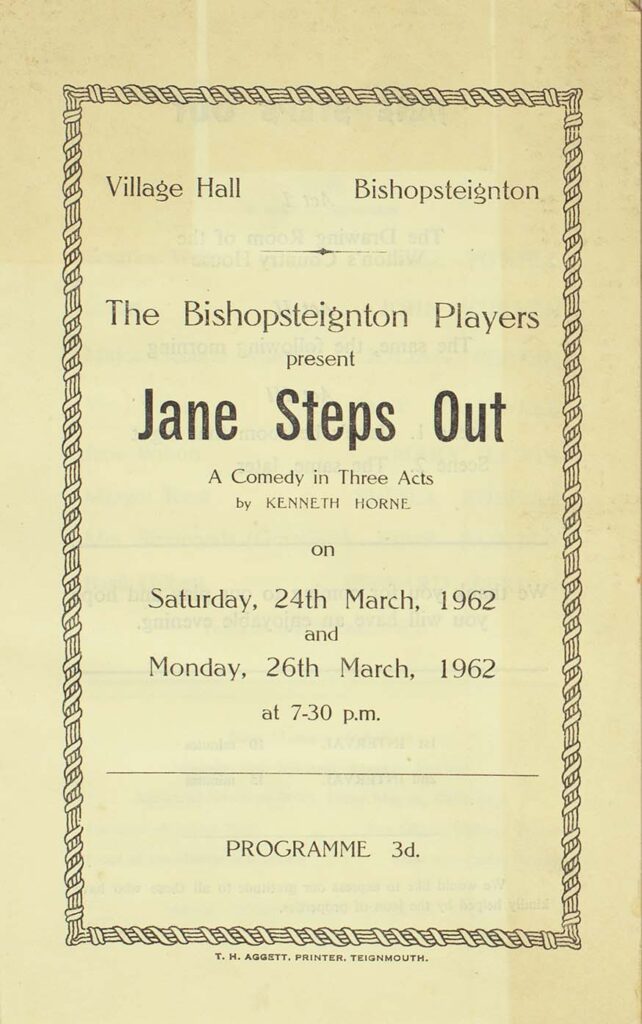
Programme for the March 1962 Players play ‘Jane Steps Out’.
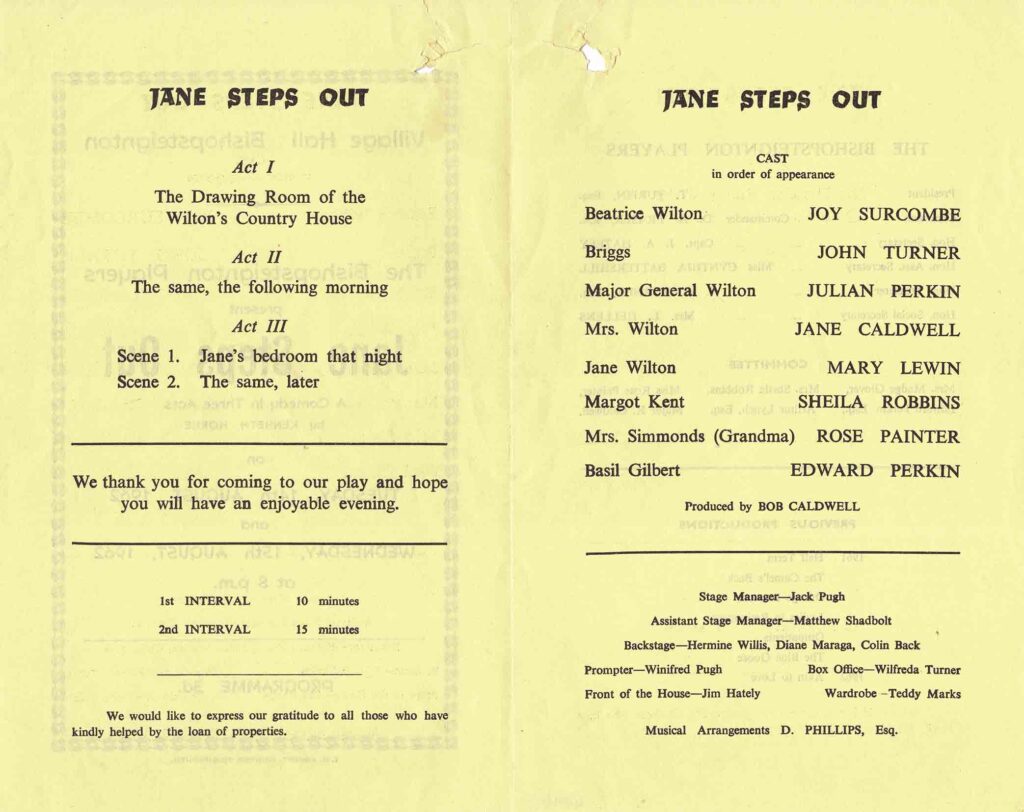
Programme for the March 1962 Players play ‘Jane Steps Out’.
A newspaper article about this play performed in March was given the title ‘Fine Performance by Bishopsteignton Players’ and then started with the description ‘Spring has come a little late this year – at any rate as far as the temperature is concerned there was nothing chilly about the atmosphere in the Village Hall at Bishopsteignton last weekend’. The cast of Bishopsteignton Players presenting Kenneth Horne’s comedy added another success to their impressive list.
It was also mentioned that together with the excellence of the actors and actresses the general presentation and staging was a tribute to the producer, Bob Caldwell and the stage managers Jack Pugh and Matthew Shadbolt. It was also a triumph for Mary Lewin who played Jane, emerging from the unattractive daughter to a beauty, with warmth and softness.
Edward Perkin played the ‘straight laced’ Basil who found Jane’s charms irresistible and Rose Painter’s role as Grandma was very successful. Else Powell who played Beatrice, the man hunting role, put lots of life into her performance, as did Sheila Robbins who played Beatrice’s friend Margot Kent.
Major General and Mrs Wilton were played by Julian Perkin and Jane Caldwell, who were the parents of Beatrice and Jane, along with John Turner who, in a brief performance, was truly believable in the role of Briggs.
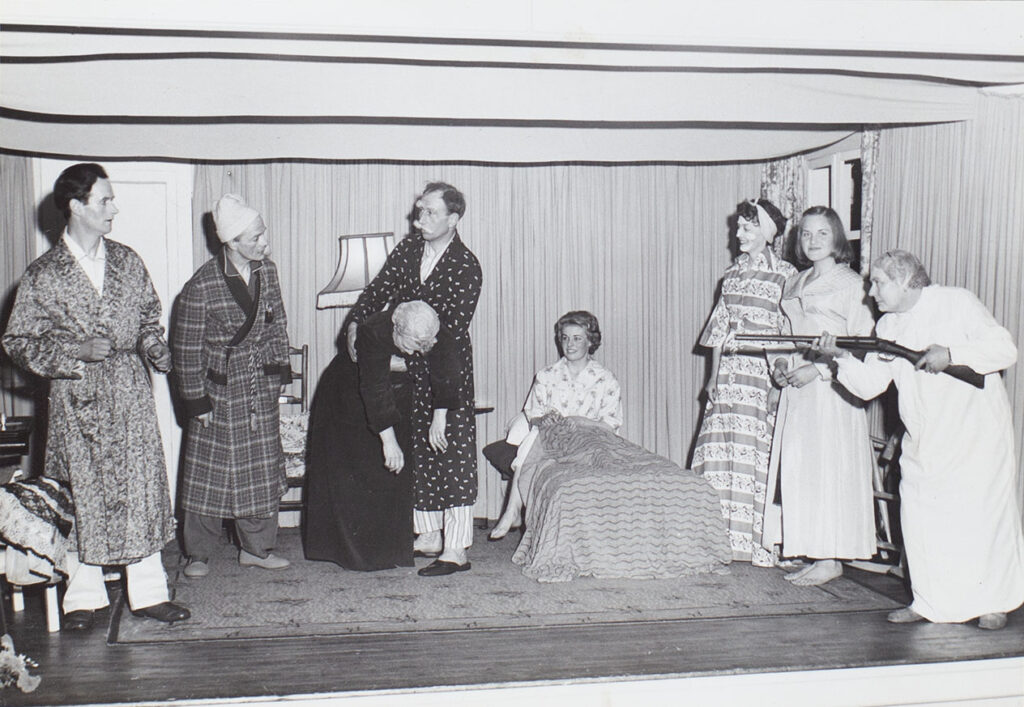
Cast in a scene form the play ‘Jane Steps Out’ 1962.
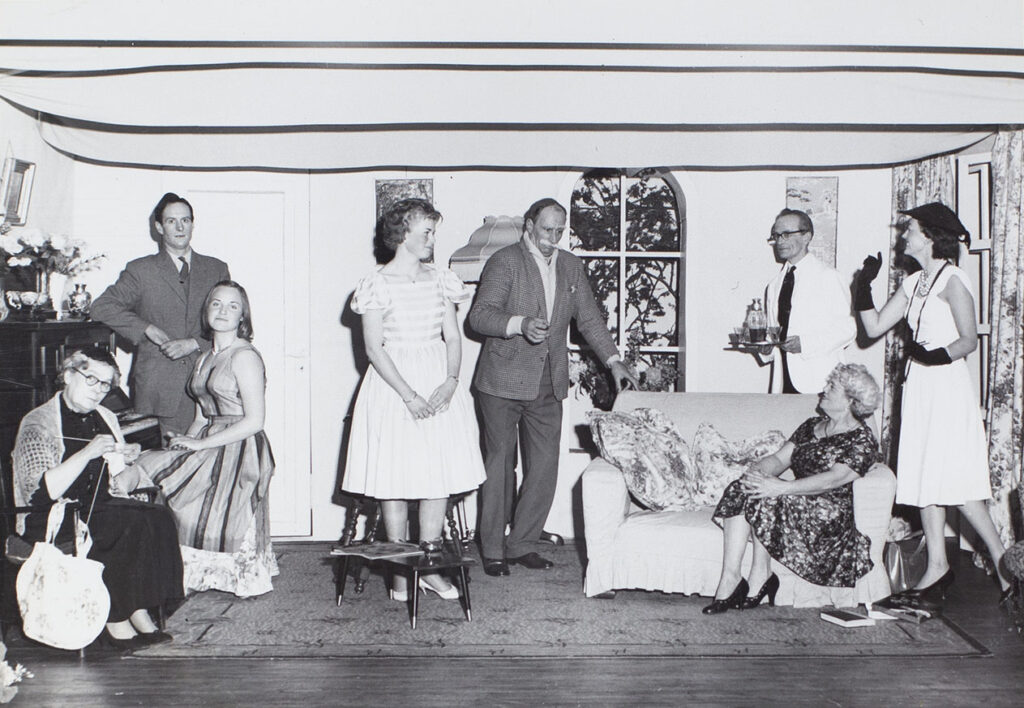
Cast in a scene form the the Players play ‘Jane steps Out’.
The photographs below show scenes from the play ‘Ring O’ Roses’ performed May 1962, which divided the productions of ‘Jane Steps Out’.
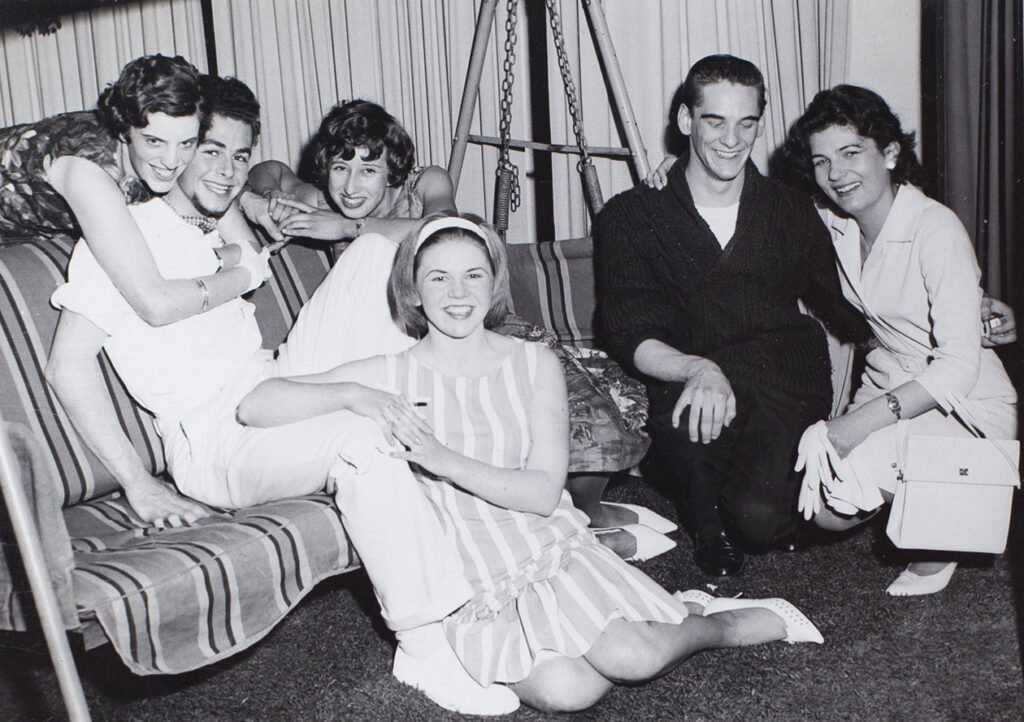
The Cast of the Players play ‘Ring o’ Roses’.
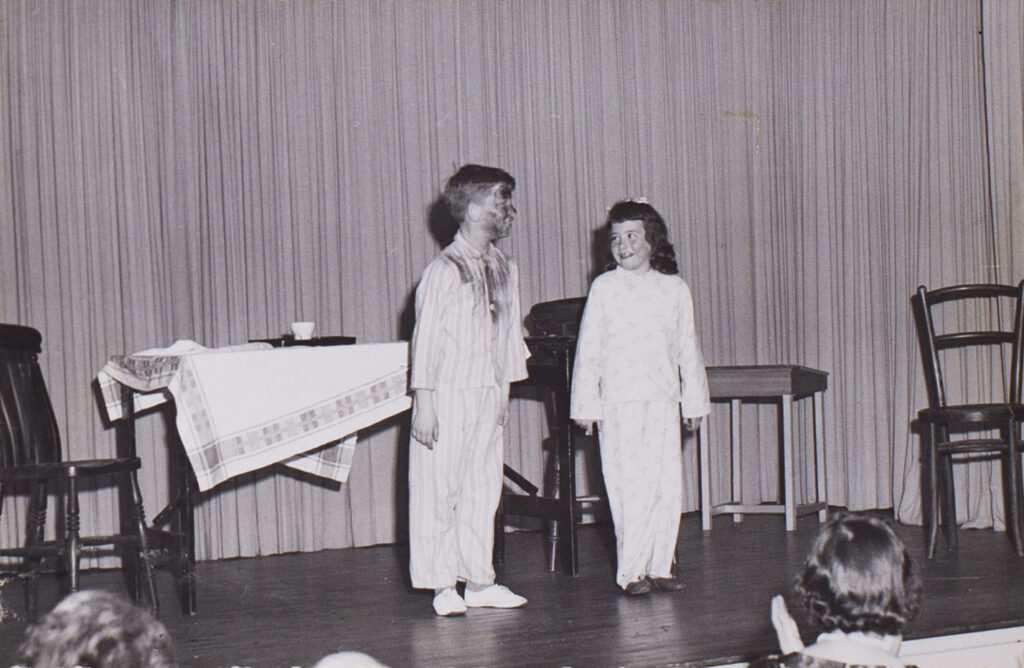
Albert Heal and Gaynor Robbins in the Players play ‘Ring O Roses’.
Photograph of Diana Maraga, Ray Watkinson, Wendy Cowling, Diana Beatty, Colin Back and Cynthia Hepworth in the play ‘Ring 0′ Roses’.
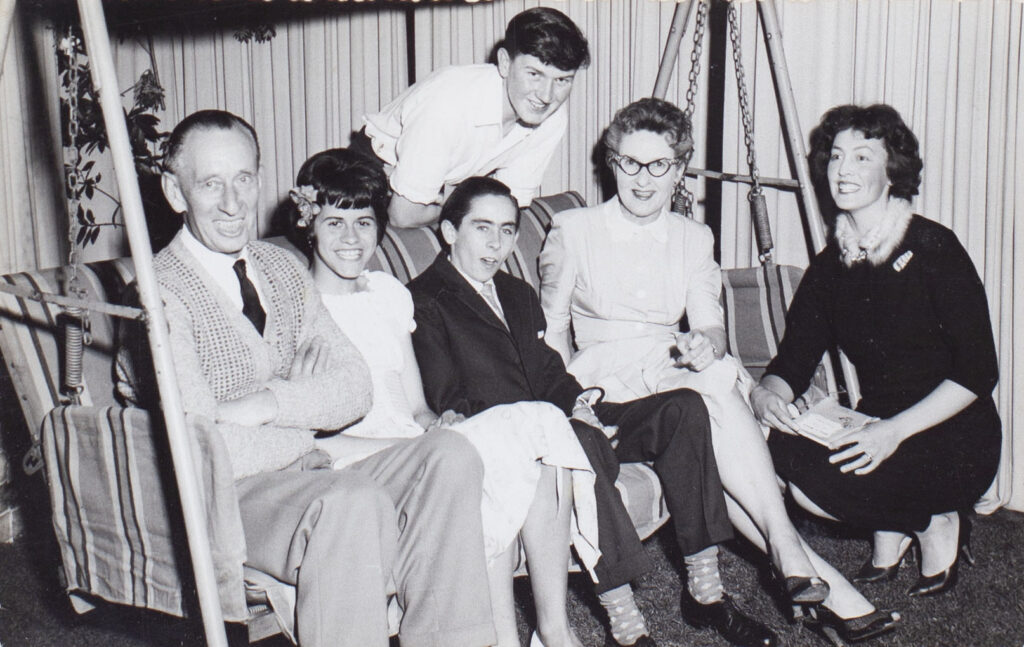
Backstage crew of ‘Ring o’ Roses’ 1962.
August 1962 saw the second performance by the Players of ‘Jane Steps Out’, whith a change in the character of Beatrice, now played by Joy Surcombe. The programme below also shows the members of the committee responsible for the performances.
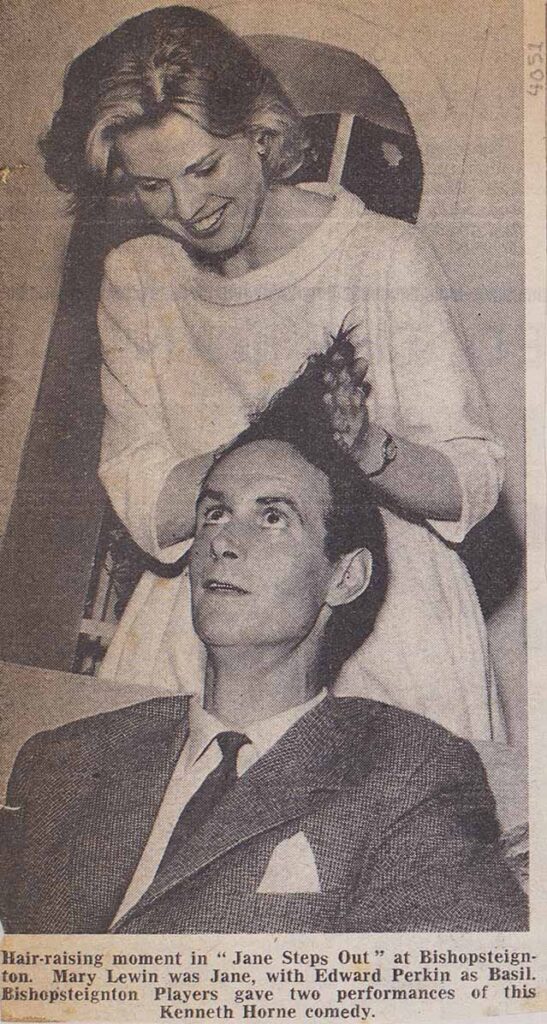
Newspaper cutting showing a picture of actors, Mary Lewin and Edward Perkin in a Hair-raising moment in the play ‘Jane Steps Out’ presented by Bishopsteignton Players.
Another newspaper article described this additional production of ‘Jane Steps Out’, again produced by Bob Caldwell, as ‘a performance that was difficult to praise too highly and great credit goes to the producer, cast and the backstage crew for this second successful production’. Joy Surcombe who joined the cast at short notice gave a realistic performance as Beatrice, the sister to Jane who again was played by Mary Lewin.
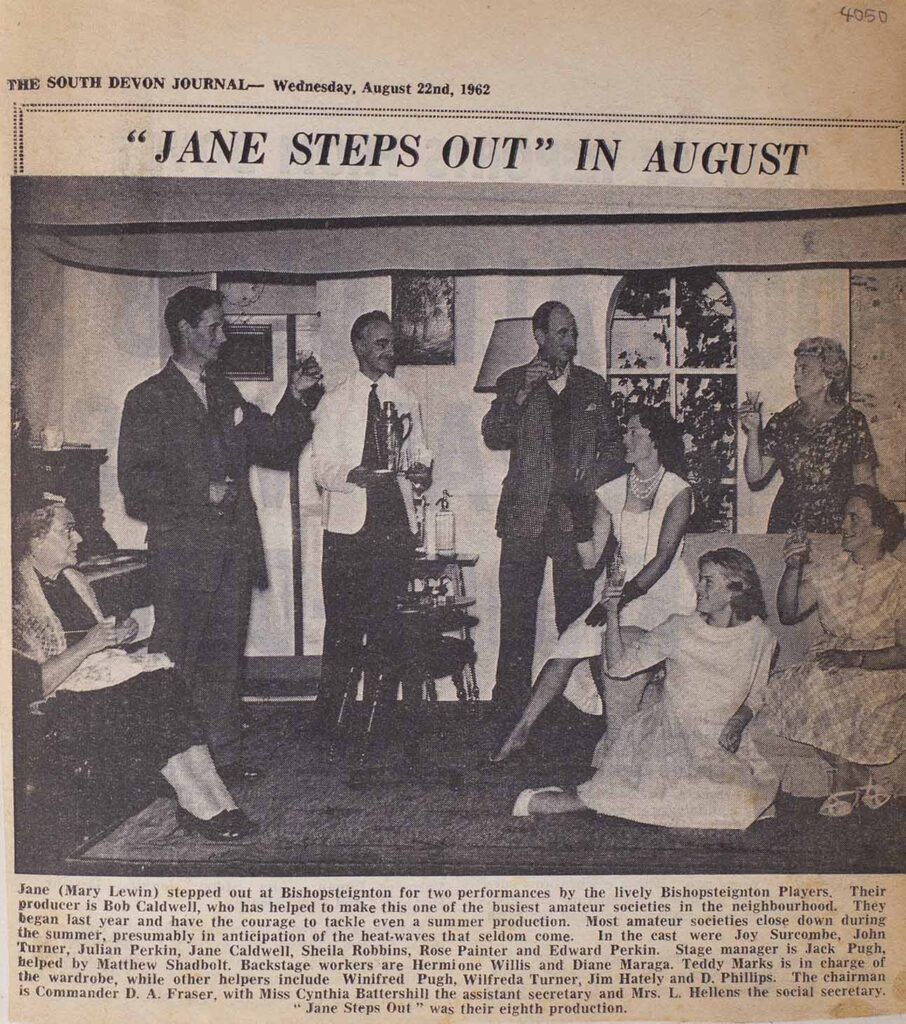
Newspaper article praising ‘Jane Steps Out’, August 1962.
To complete the year 1962, the Players performed a murder play named ‘The House by the Lake’ by Hugh Mills, in December.
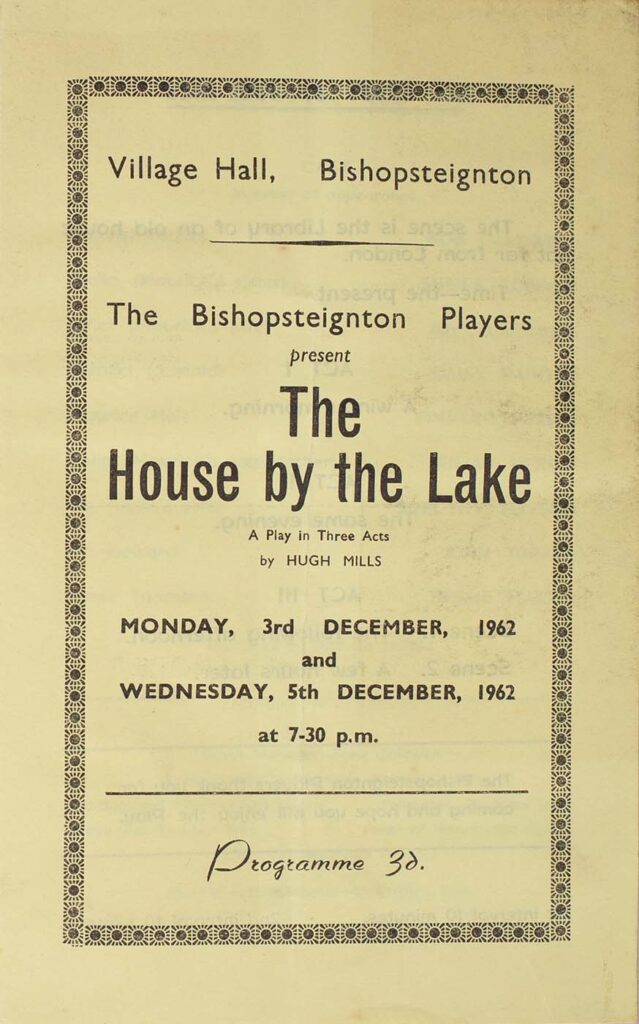
Programme for the play ‘The House by the Lake’ performed by Bishopsteignton Players.
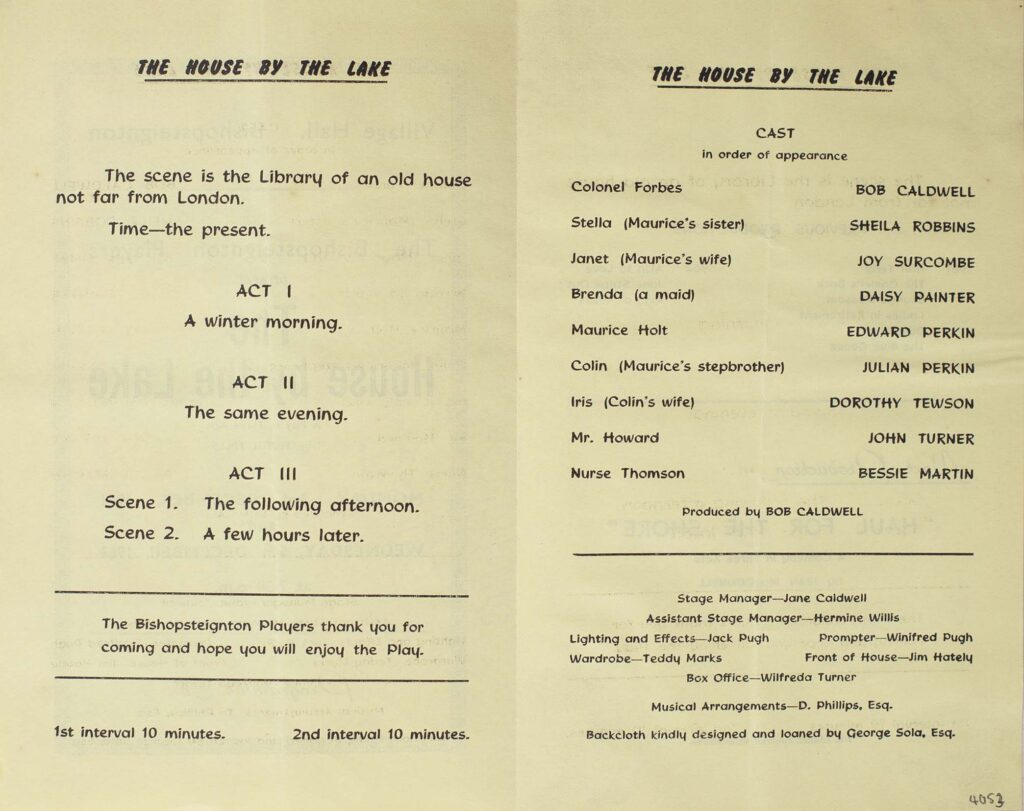
Programme for the play ‘The House by the Lake’ inside page.
This was a murder play with high drama that kept the audience gripping their seats. The play starts with the body of the victim, Colin Holt, played by Julian Perkin. being discovered in an unusual place on a frozen lake. This was not an easy play to perform as the scenes were dramatic with lines that were very important for the plot and clues to be understood by the audience.
Living in ‘The House By The Lake’ is Maurice Holt, played by Edward Perkin, who is a psychiatrist and who has been struck off the medical list due to legal action against him, his wife Janet, played by Joy Surcombe and his sister, Stella played by Sheila Robbins.
Living across the lake is Mr Holt’s step brother Colin, played by Julian Perkin, a financial rogue who was instrumental in getting Maurice struck off the medical list, and his wife Iris, played by Dorothy Tewson.
Both marriages are not happy ones. Due to Maurice’s financial difficulties and his refusal to be helped back into the medical profession he decides, with the help of his sister, to sell a saw-mill that he part owns with his stepbrother Colin. However, Colin does not agree with the sale and has no time for Maurice which leads Maurice and Stella deciding to ‘get rid’ of him by means of drugs and then dragging him to the frozen lake.
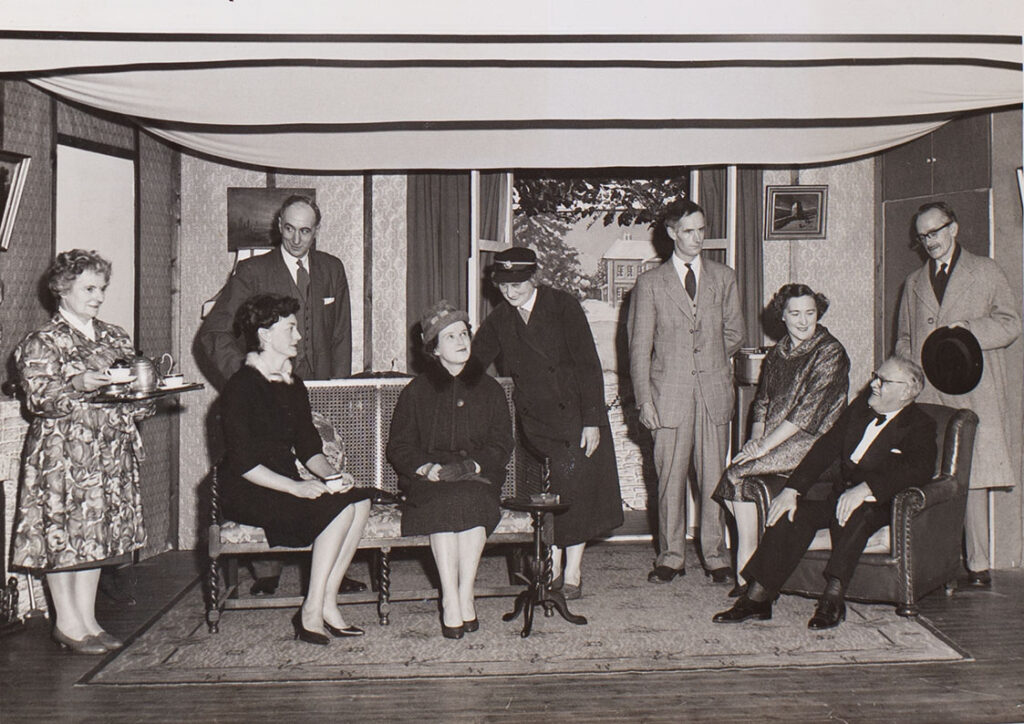
Cast in a scene from the Players play ‘The House by The Lake’.
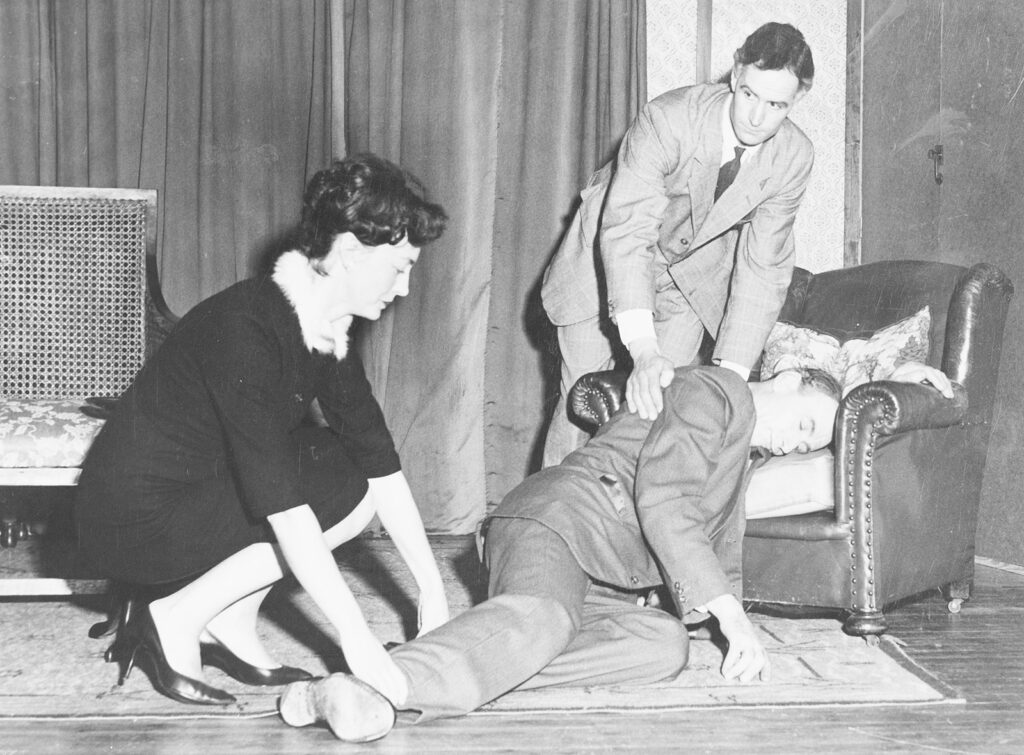
Play ‘House by the Lake’ performed by the Bishopsteignton Players 1960s.
The body is found by a visiting detective Mr Howard played by John Turner. Maurice and Stella are surprised when Iris confesses she is the murderer, however it becomes evident that Janet knows the true facts. With this knowledge Maurice hypnotises Janet and places a gun into her hands and tells her to take her own life. The Detective saves the day and all ends happily for Iris and Janet.
In a newspaper article it states that Sheila Robbins plays Stella with a coolness and composure, Dorothy Tewson and Julian Perkin play their roles with confidence, convincing and sincerely. Joy Surcombe plays the submissive wife with conviction, building her role up and in the final scenes portrays the distraught woman brilliantly. Edward Perkin is excellent as a psychiatrist and the grim faced embittered Maurice, being persuasive and carrying out the task convincingly, contributing to the success of the play.
Bob Caldwell who produced this play also played the role of Col Forbes, a family friend. Daisy Painter’s role was the maid and Bessie Martin the nurse. The play also had a strong crew including the Stage Manager Jane Caldwell, the Assistant Stage Manager Hermine Willis, lighting and effects Jack Pugh, prompter Winifred Pugh, wardrobe by Teddy Marks and musical arrangements by Mr D Phillips.
Sheila Robbins mentioned in an interview with Yvonne Hellin-Hobbs that during the dress rehearsal Julian Perkin who had to collapse in the play did so brilliantly and convincingly that he actually broke two ribs and couldn’t get off the floor!
At the end of this year membership of Bishopsteignton Players stood at 128 persons.
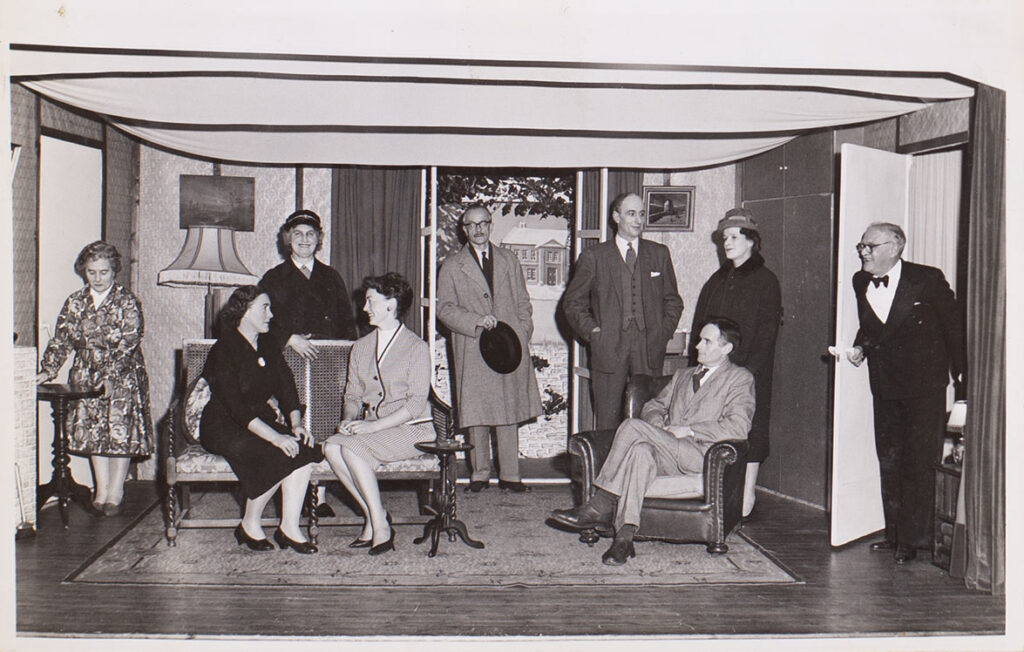
Cast in a scene from the Players play ‘The House by the Lake’.
1963
April 1963 saw the production of ‘Haul for the Shore’ by Jean McConnell.
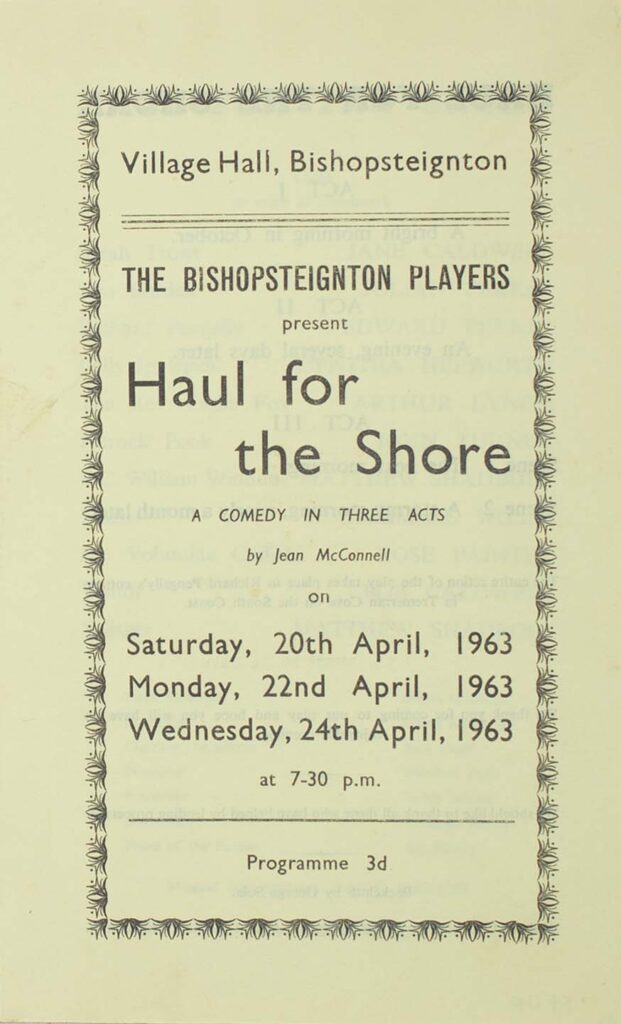
Programme for the play ‘Haul for the Shore’ presented by the Bishopsteignton Players 1963.
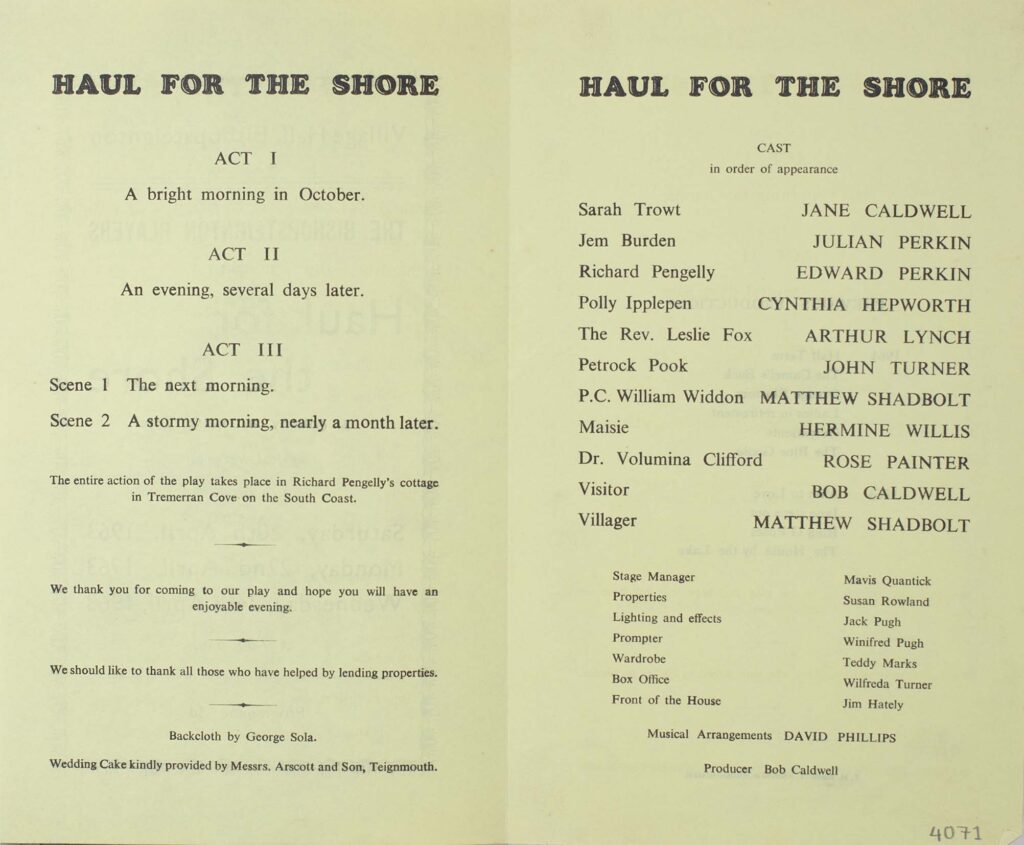
Programme for the play ‘Haul for the Shore’, (inside) presented by the Bishopsteignton Players 1963.
The Bishopsteignton Players broke with their normal practice for this play and offered three nights of performance instead of two. Their presentation of Jean McConnell’s play was described in the press as capturing ‘the salty tang and hearty humour of the West Country fisherfolk with startling reality’.
The play revolves around the residents of Tremerran Cove who traditionally keep for themselves any goods rescued from the wrecks along their shoreline. It also concerns a local couple who are living out of wedlock and the new vicar’s endeavours to reform both the smugglers and the errant couple. Julian Perkin came in for special mention playing Jem Burden, uncle to the would-be bridegroom, ‘a lazy, lovable old reprobate with an eye for the girls and a leaning toward ginger nuts’. His tremendous character acting matched by his rich West Country accent.
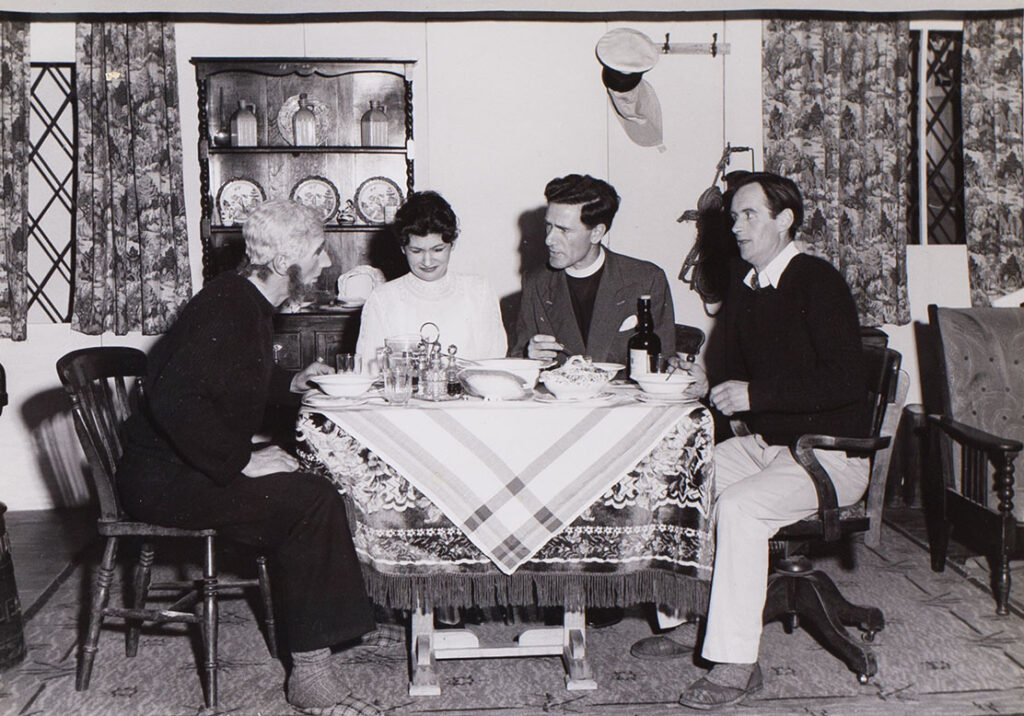
A scene from the play ‘Haul for the Shore’ presented by Bishopsteignton Players in 1963.
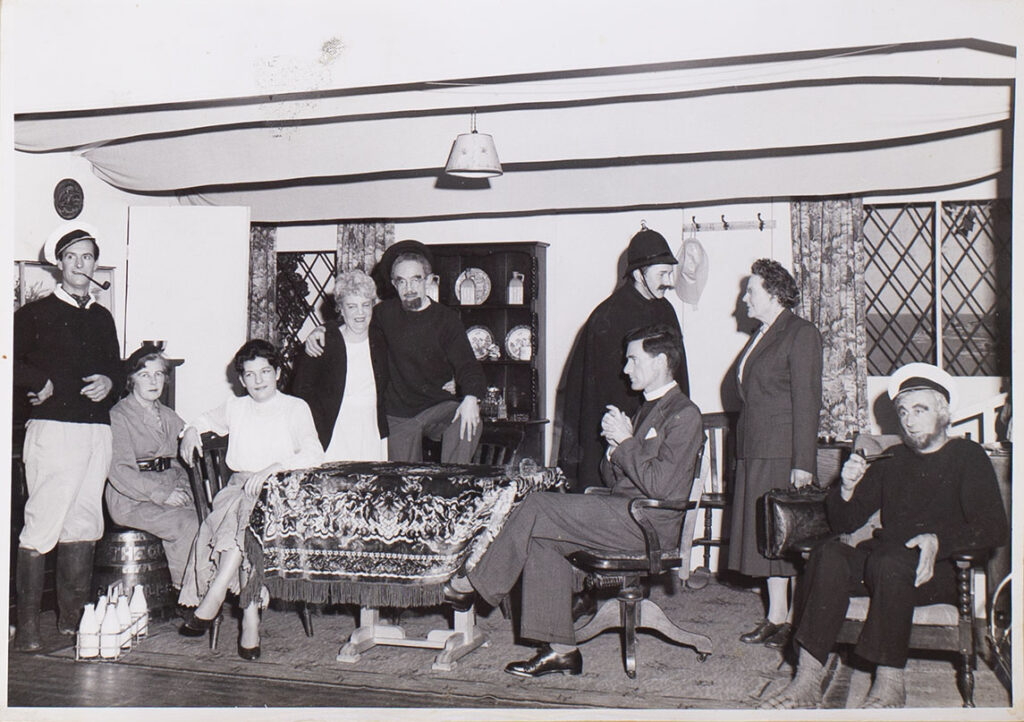
A scene from the play ‘Haul for the Shore’ presented by Bishopsteignton Players in 1963.
Arthur Lynch played the Rev. Leslie Fox, the rather bemused vicar. Edward Perkin and Cynthia Hepworth teamed up as the errant couple, Richard and Polly. Other cast included John Turner, Jane Caldwell, Hermine Willis, Mathew Shadbolt, Rose Painter and Bob Caldwell who also produced.
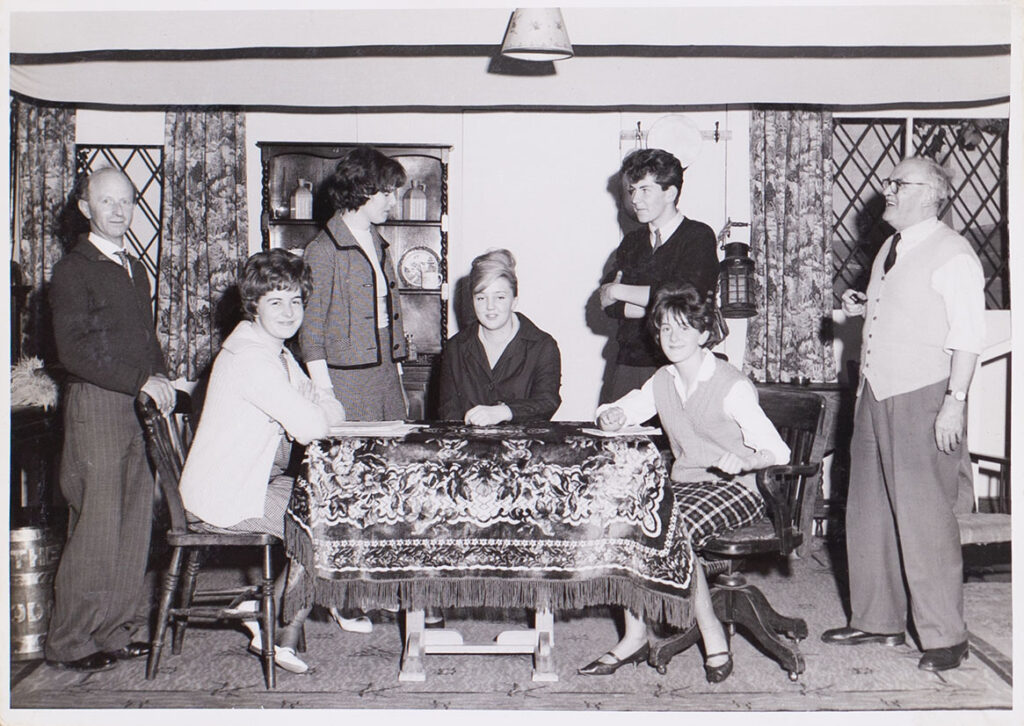
Backstage Crew from the play ‘Haul for the Shore’ presented by Bishopsteignton Players in 1963.
‘Mystery Cottage’ late 1963/earlier 1964
As we have no programme for this play, we know little about it; it is indeed a mystery. We feel it must have been performed at the end of 1963 or the beginning of 1964, judging by its position in the Players Scrapbook of the sixties put together by Sheila Robbins. https://www.bishopsteigntonheritage.co.uk/wp-content/uploads/2021/04/Players-Scrapbook-Full.pdf
The play was chosen specifically because it featured youngsters and there were quite a few who wanted to get involved in the players. The cast, from right to left were Wendy Cowling, Diana Maraga, Angela Osbourne, Bessie Martin, Dorothy Tewton, Jill Allsop and a Miss Sharland. Dorothy Tewton played a film star whom the girls find in the Mystery Cottage.
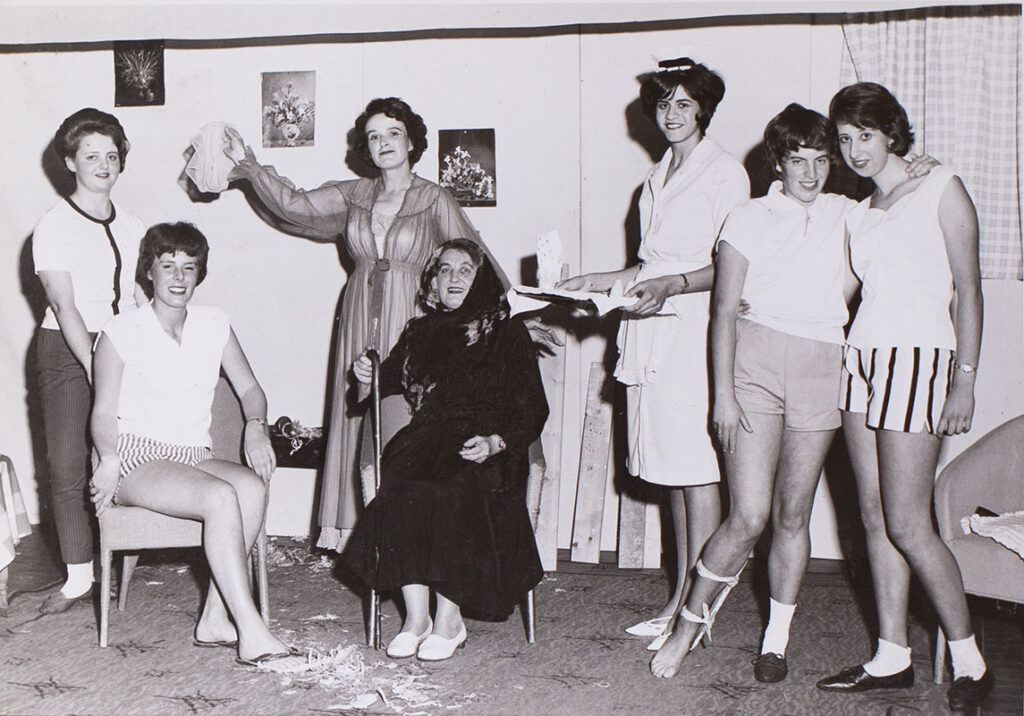
Bishopsteignton Players in a scene from the play ‘Mystery Cottage’.
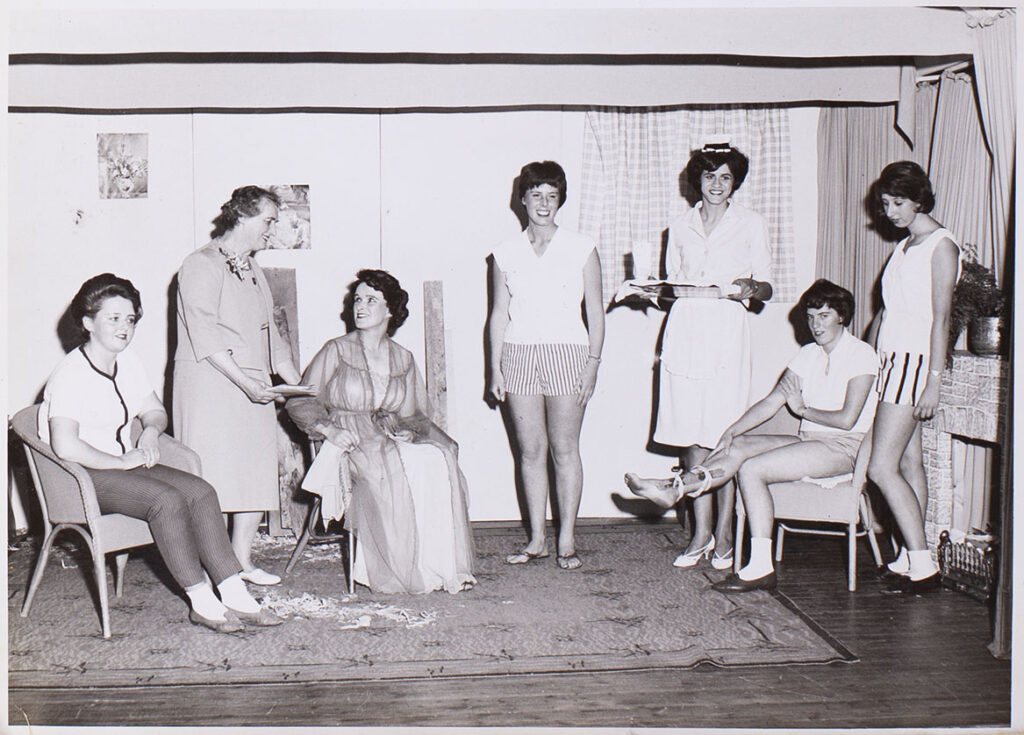
Photograph of a scene from the play ‘Mystery Cottage’ presented by Bishopsteignton Players
1964
In April 1964 the Players produced ‘Wolf’s Clothing’ by Kenneth Horne.
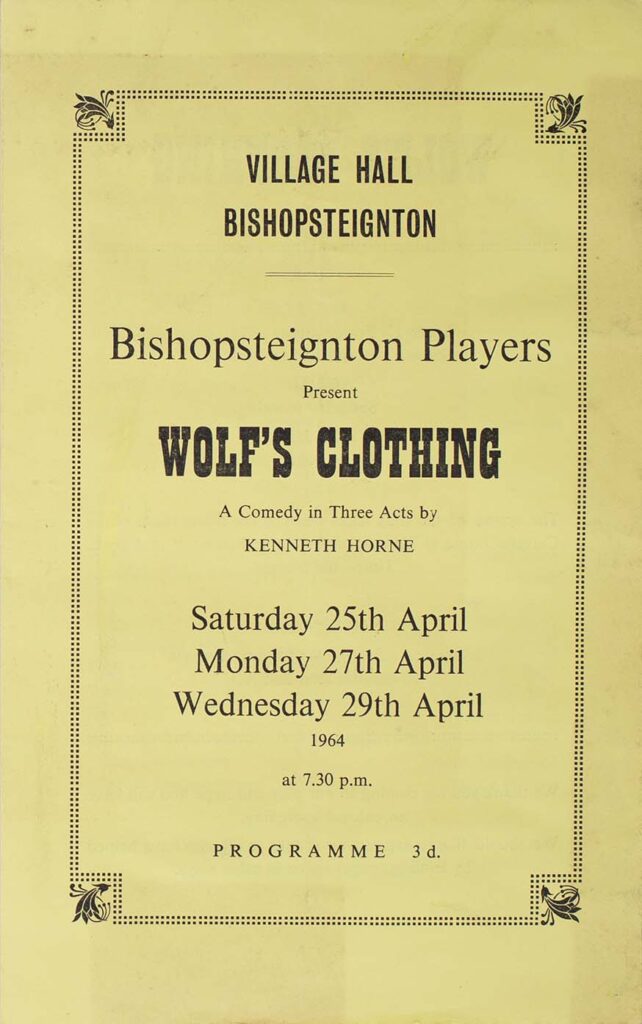
Programme for the play ‘Wolf’s Clothing’ presented by the Bishopsteignton Players.
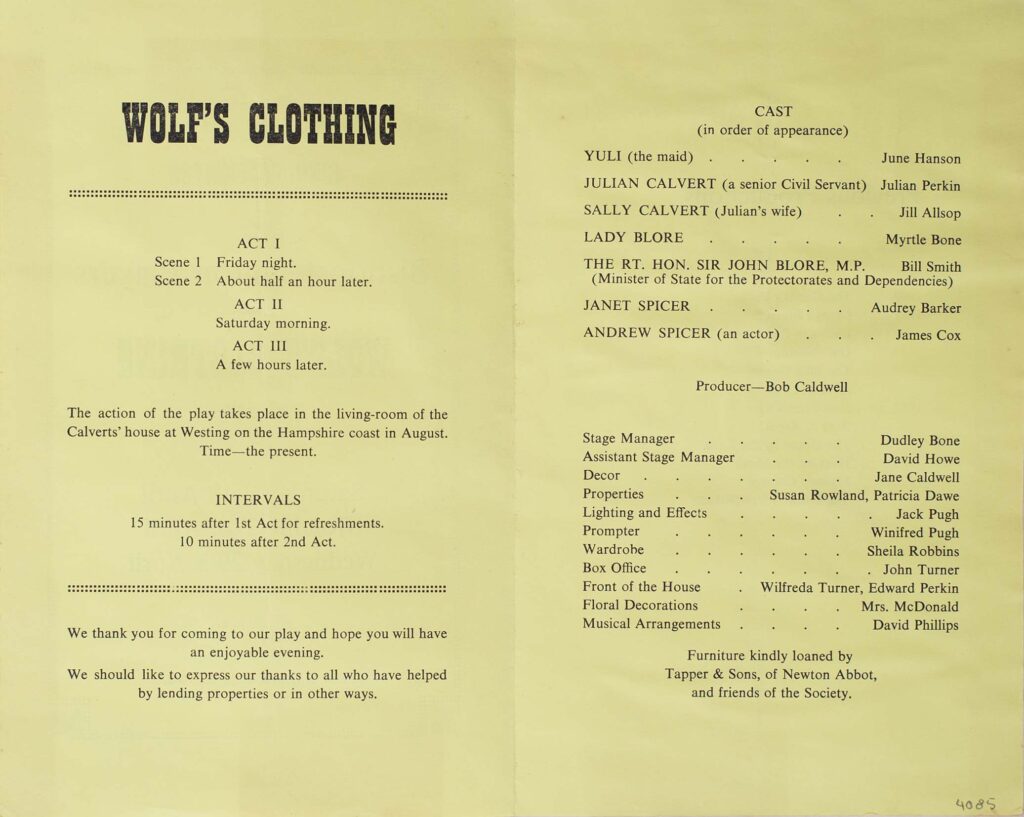
Programme (inside) for the play ‘Wolf’s Clothing’ presented by the Bishopsteignton Players.
The press review of this play, performed in April 1964, stated that the majority of the cast had little or no stage experience. Typically of its author, the play deals with the private lives of two couples in collision, with hilarious consequences. Julian Perkin was brilliantly cast as Julian Calvert, a serious senior civil servant, and his wife Sally, a super-efficient partner in a humdrum marriage was played by Jill Allsop in her first major role with the players.
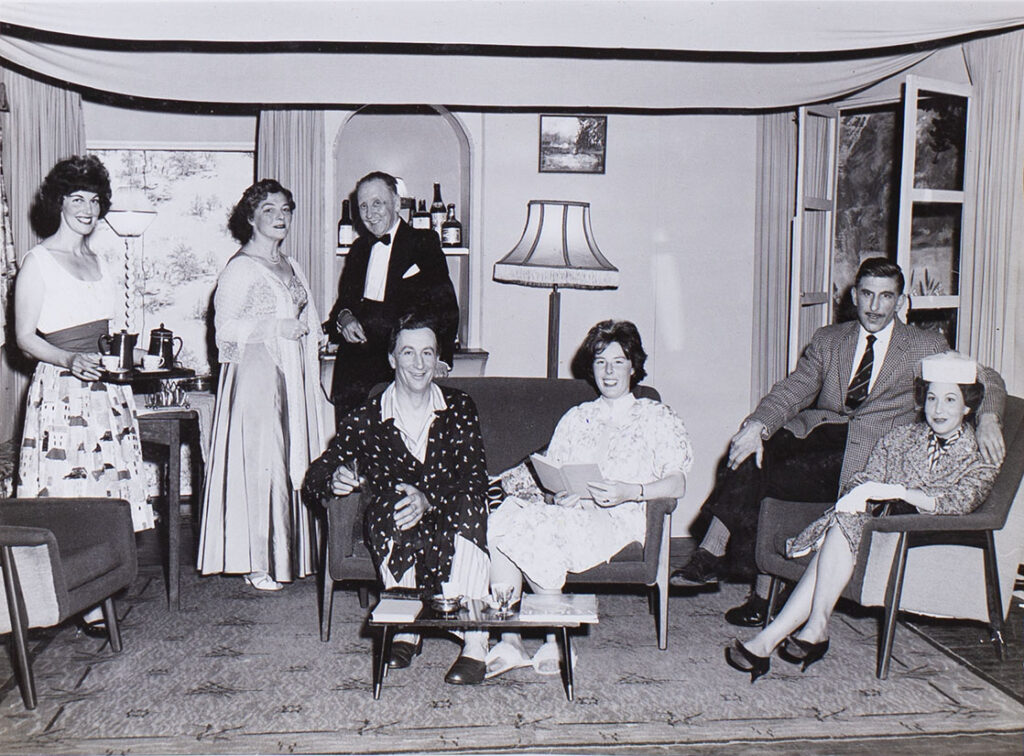
Cast in a scene from the play ‘Wolf’s Clothing’ presented by Bishopsteignton Players in 1964.
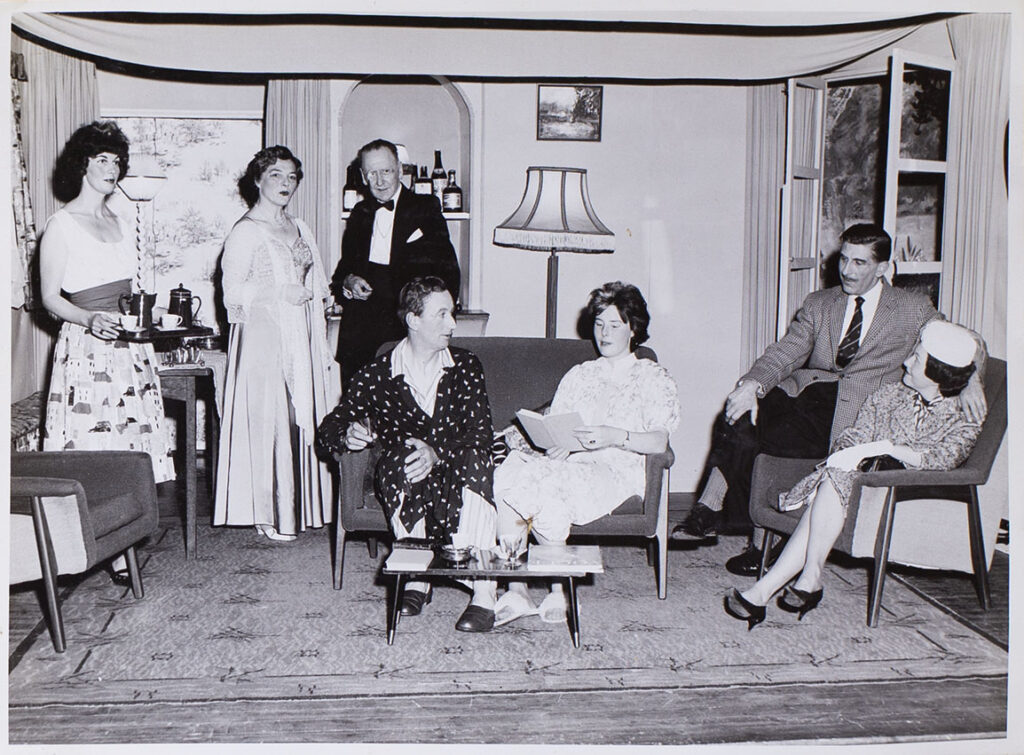
Photograph of the cast in a scene from the play ‘Wolf’s Clothing’ presented by Bishopsteignton Players in the Village Hall 1964.
The other couple, the Spicers, rather more disorderly with Andrew Spicer, an actor with a taste for extra marital affairs played by James Cox, and his wife Janet, volatile in the extreme played by Audrey Barker. The action takes place in the home of the Calverts when they inadvertently swap bedrooms and Julian is ‘egged on’ to make love to the attractive mid European maid Yuli, played by June Hanson.
Also in the cast were Bill Smith and Myrtle Bone playing Sir John and Lady Blore. The play was, once again, produced by Bob Caldwell.
In December 1964 the Players performed ‘Quiet Week-End’ by Esther McCraken.
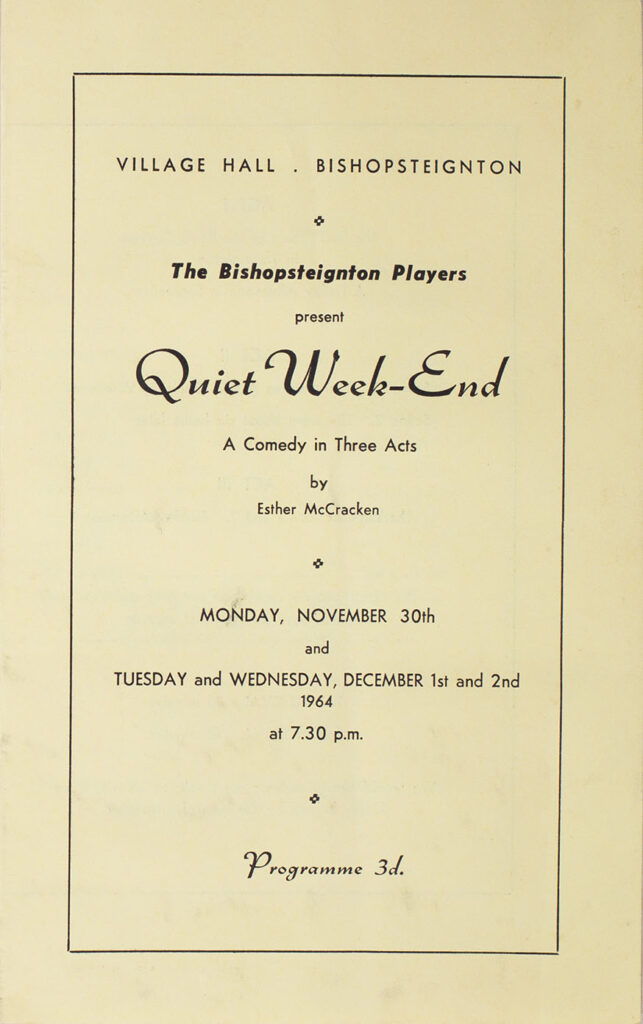
Front programme for the play ‘Quiet Week-End’ presented by Bishopsteignton Players.
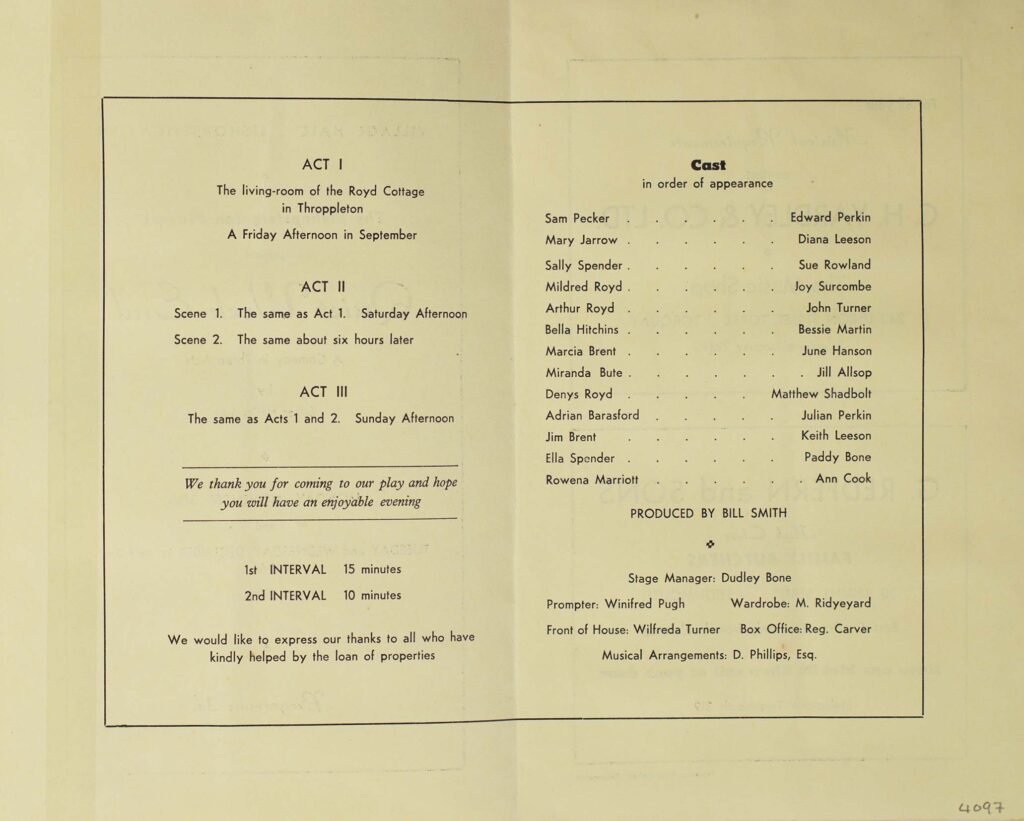
Programme (inside) for the play ‘Quiet Week-End’ presented by the Bishopsteignton Players in 1964.
Unusually the press review of this play was not as full of praise as was normal for the players, however it would appear that the comedy was an enjoyable experience for the audience. The action centred upon a house party at the cottage of Mildred and Arthur Royd, played by Joy Surcombe and John Turner. Their guests Diana Leeson as Mary Jarrow, Jill Allsop as the jealous Miranda Bute, Julian Perkin as amateur poacher and justice of the peace Adrian Barasford. Mathew Shadbolt played the blasé son Denys Royd, impervious to the amorous attentions of Miranda and the young American Rowena Marriott, played by Ann Cook.
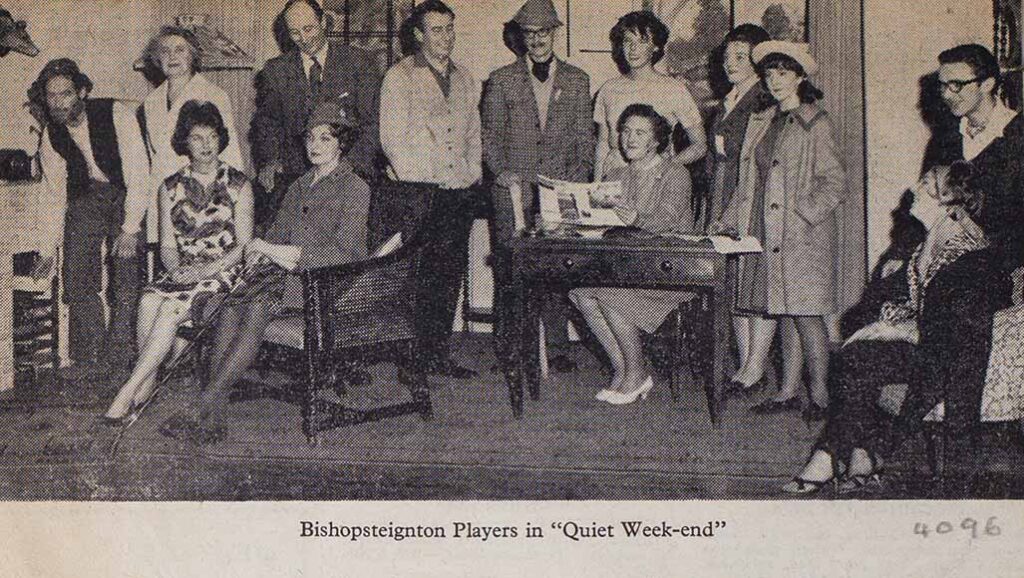
Newspaper article showing a scene from the play ‘Quiet Week-End’ presented by Bishopsteignton Players.
December 1964
During the four years that the Bishopsteignton Players had been in existence, several teenagers and quite a lot of children had shown an interest in participating. As the adults in the players were reluctant to have children in the company, Sheila Robbins and Jane and Bob Caldwell felt it would be a great idea to produce a pantomime and raise funds for the village, or some cause that was supported by the village. The cast list shows just how popular an idea this was. There was a great deal of participation by all age groups, from tiny tots to adults. Hence, ‘Dick Whittington’ became the first panto.
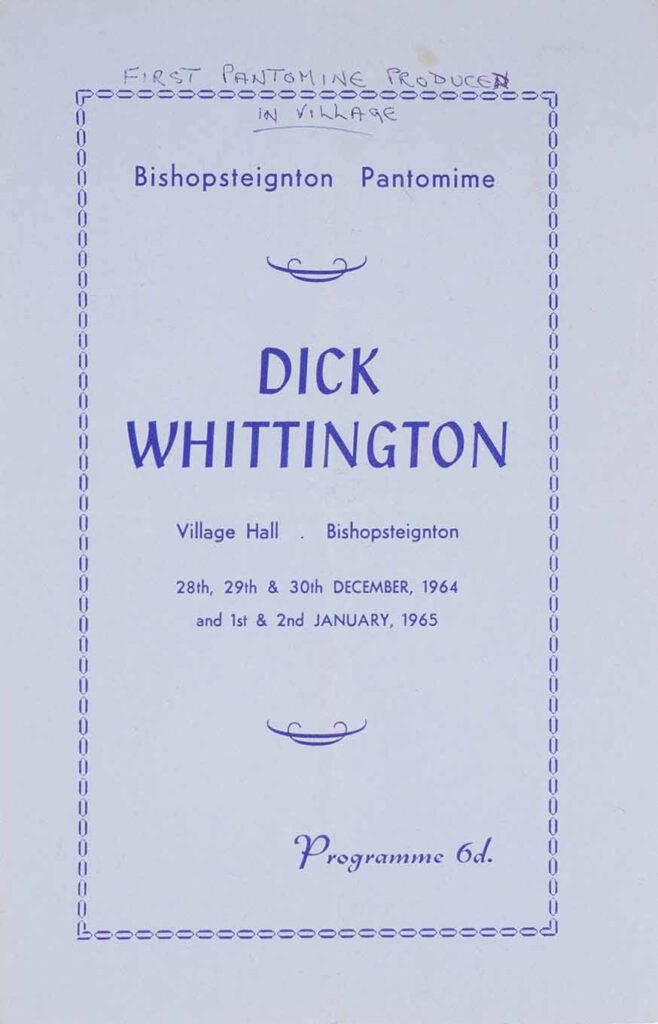
Programme for the Panto ‘Dick Whittington’ 1964.
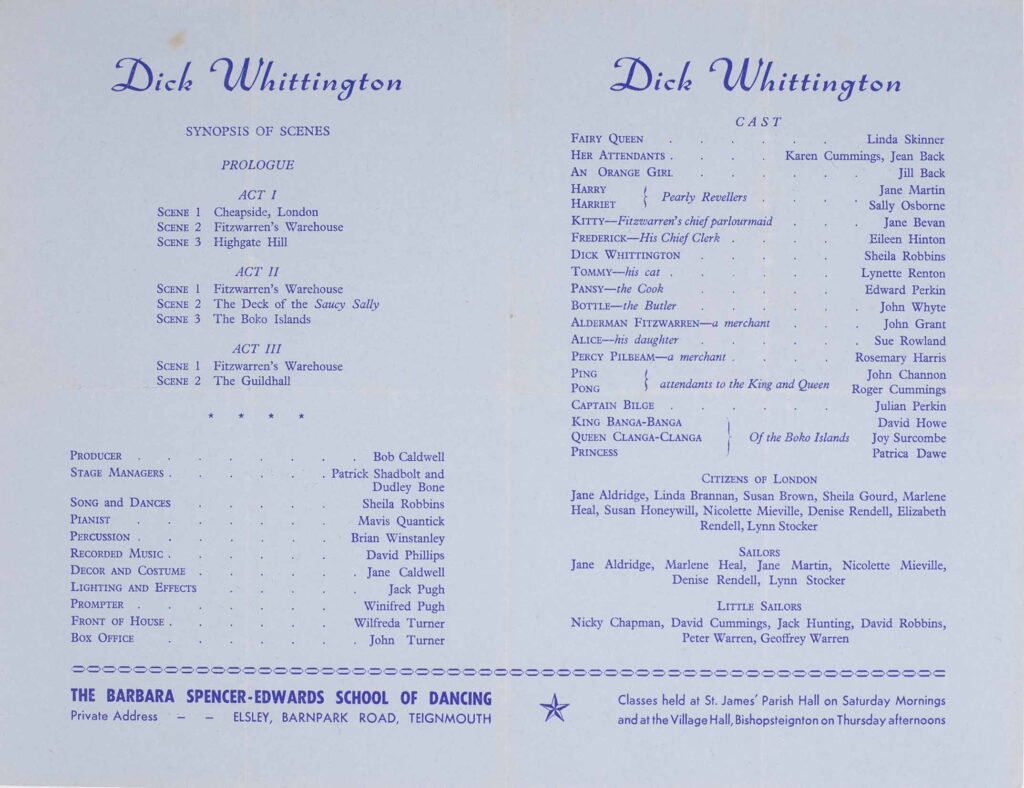
Programme (inside) for the Panto ‘Dick Whittington’ in 1964.
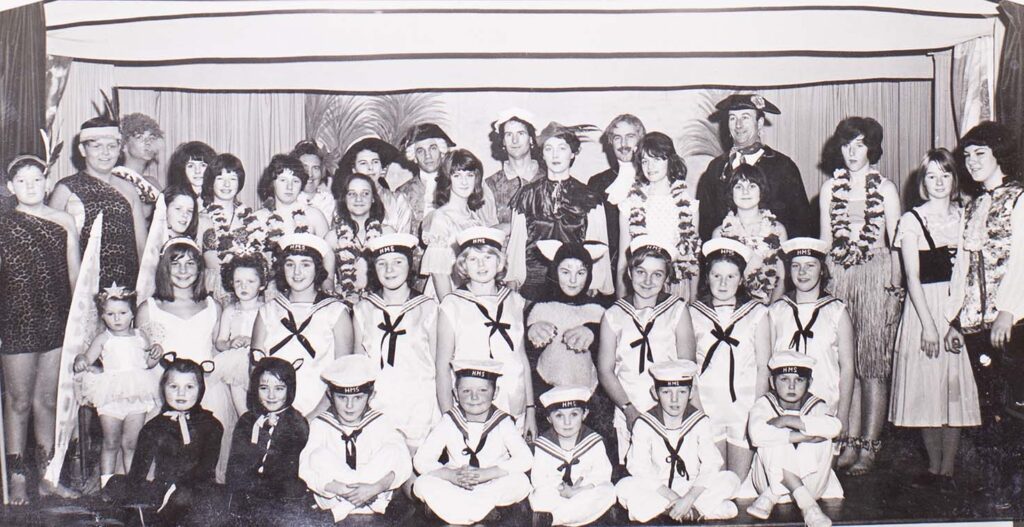
Cast of the first panto ‘Dick Whittington’ produced in 1964.
In order for this size of production to happen, many of the parents had to lend a hand with making costumes etc., and a great deal of patience was needed by the adults who coached the youngsters. The pantomimes were very popular and very well remembered in the village.
This photo shows little Karen Cummungs as a fairy in ‘Dick Whittington’, is testament to how even the youngest participants enjoyed their time in the spotlight, and the wings (made of coathangers) and the rest of the costume made by her mum.
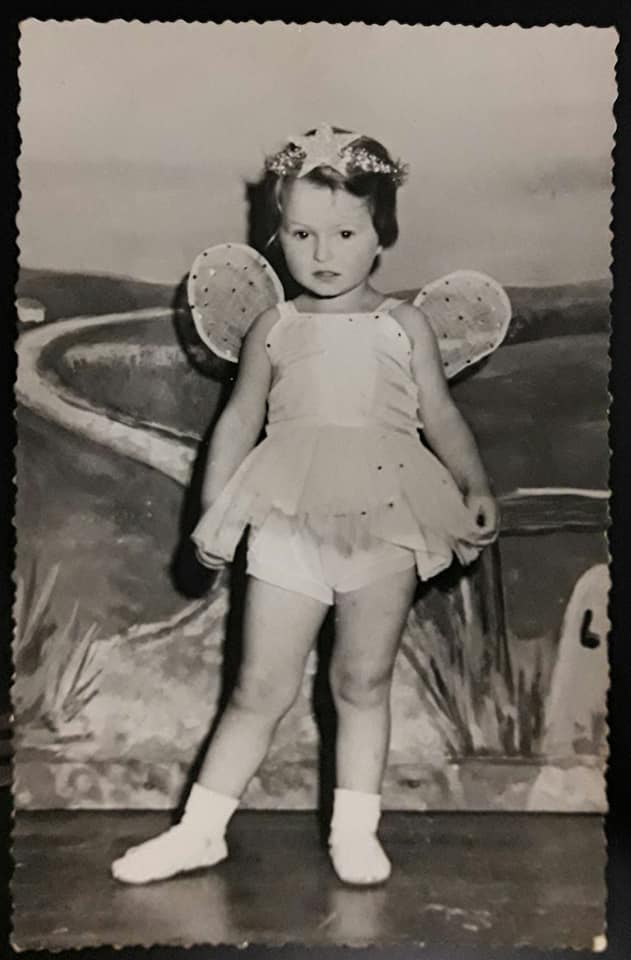
Karen Cummings in the Panto, ‘Dick Whittington’ 1964.
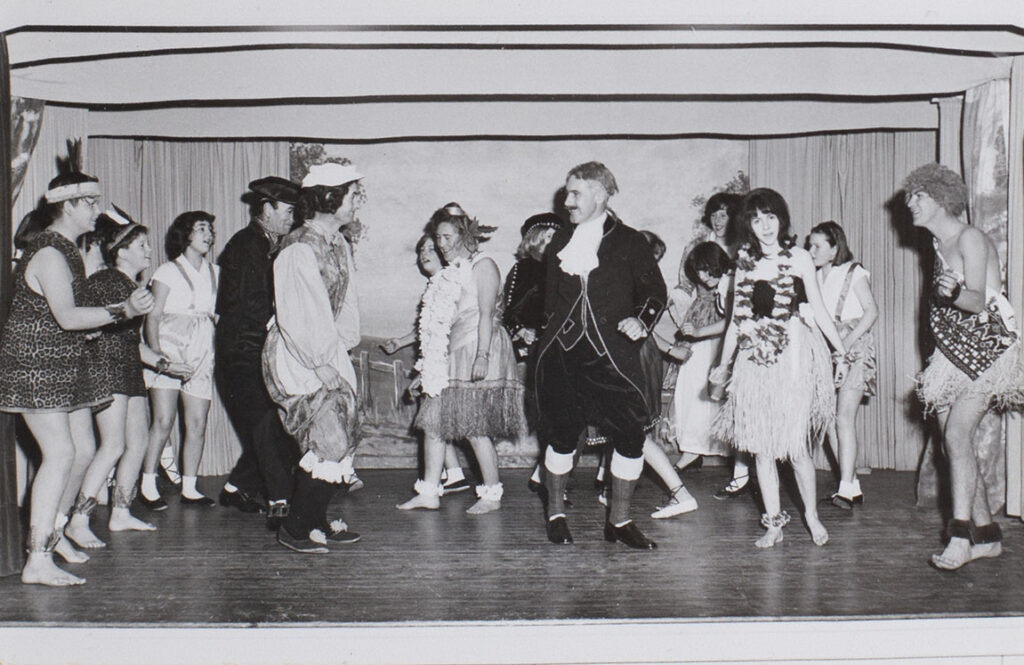
A scene from ‘Dick Whittington’ in 1964.
By 1970 Sheila Robbins had started the Bishopsteignton Children’s Theatre which accomodated the younger generation, and ran alongside the Bishopsteigntion Players for many years.
Read about the Children’s Theatre here; https://www.bishopsteigntonheritage.co.uk/people/organisations/bishopsteignton-childrens-theatre-interview-with-sheila-robbins/
1965
May 1965 saw the production of ‘Love from a Stranger’, a play in 3 acts by Frank Vosper,
which is based on a story by Agatha Christie and was produced by Bob Caldwell.
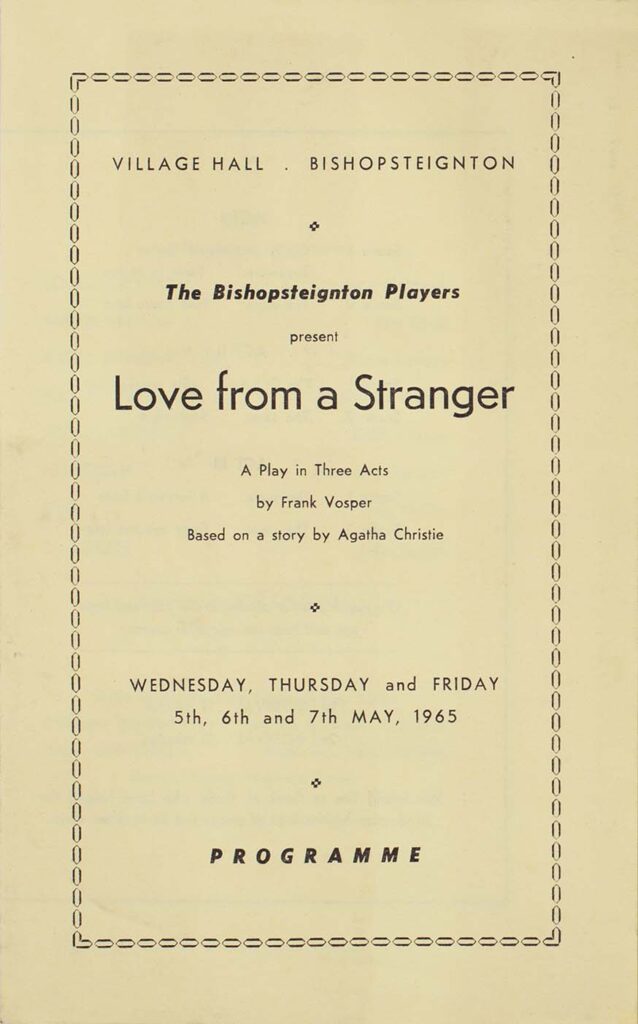
Programme (front) for the play ‘Love from a Stranger’ performed by Bishopsteignton Players 1965.
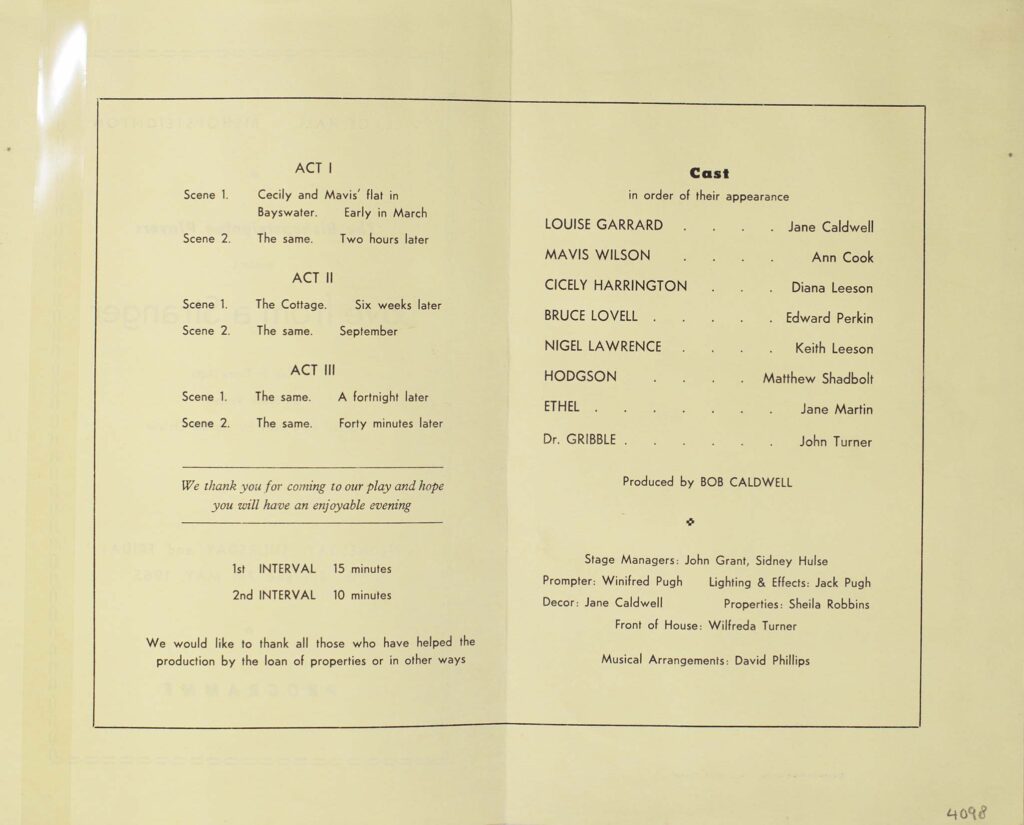
Programme (inside) for the play ‘Love from a Stranger’.
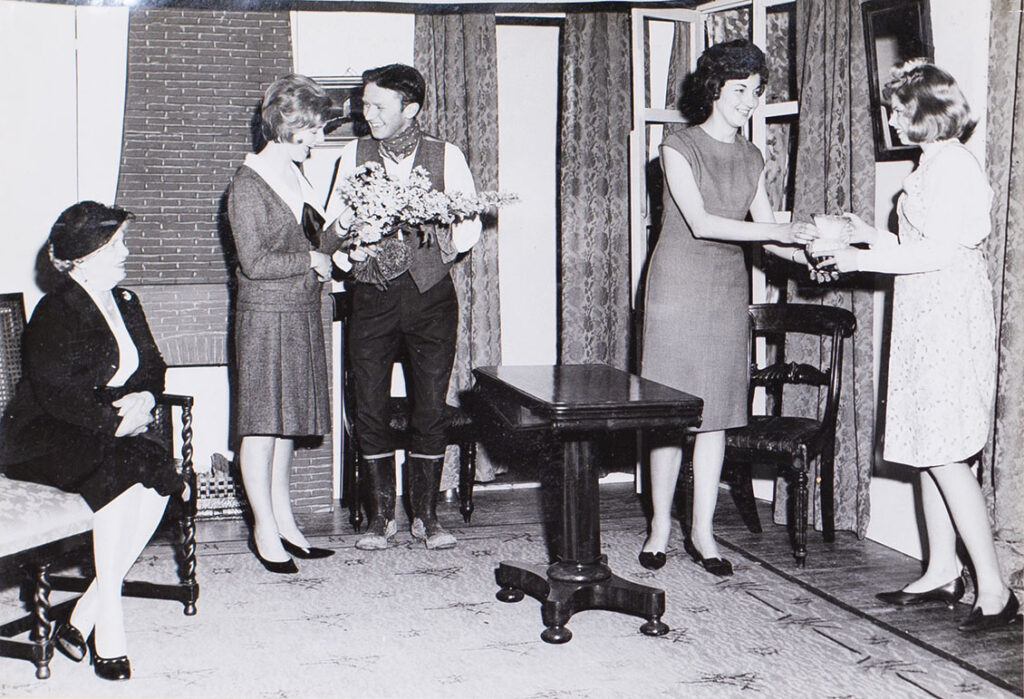
A scene from the play ‘Love from a Stranger’ presented by Bishopsteignton Players.
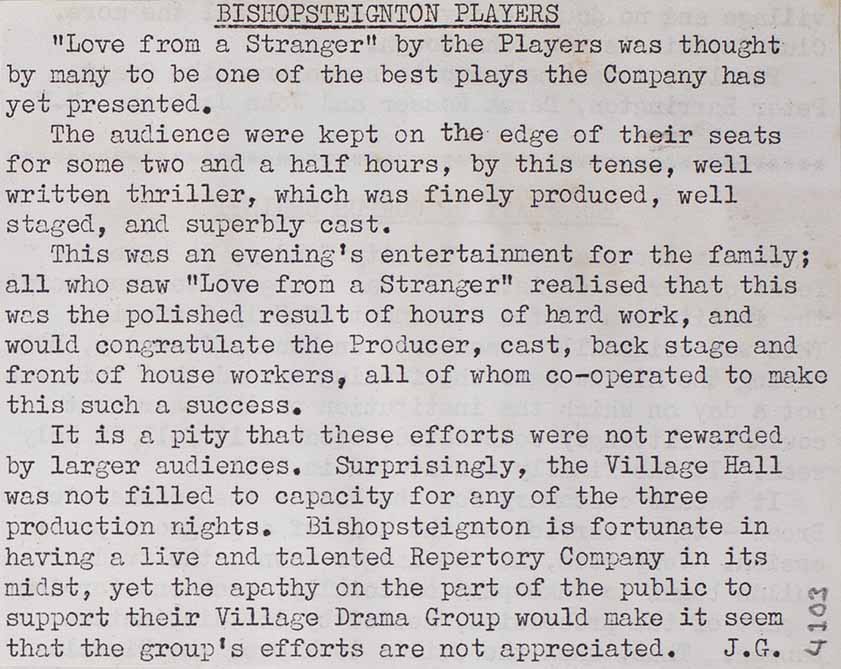
It was thought by JG that the play ‘Love from a Stranger’ was the best play the players had presented as the typed note below shows.
Typed note from JG commenting on the play ‘Love from a Stranger’:
A newspaper article stated that the Players triumphed with this production and that new members Ann Cook, Diane Leeson and Keith Leeson who had acted in only one previous play were more than capable to support their more experienced colleagues. Jane Martin who was only 14 at the time and had made her debut in the village panto earlier in the year, endeared herself to the audience as Ethel, the typical country girl, who was employed as the maid at the cottage.
The plot focuses on Bruce Lovell, played by Edward Perkin, who plays a mentally unstable murderer who attracts wealthy women into marriage by promising them travel and adventure and also Cicely Harrington, played by Diane Leeson, who jilts her finance, Nigel Lawrence played by Keith Leeson. Bruce and Cicely marry after a very quick liaison after she has won £10,000 in a sweepstake.
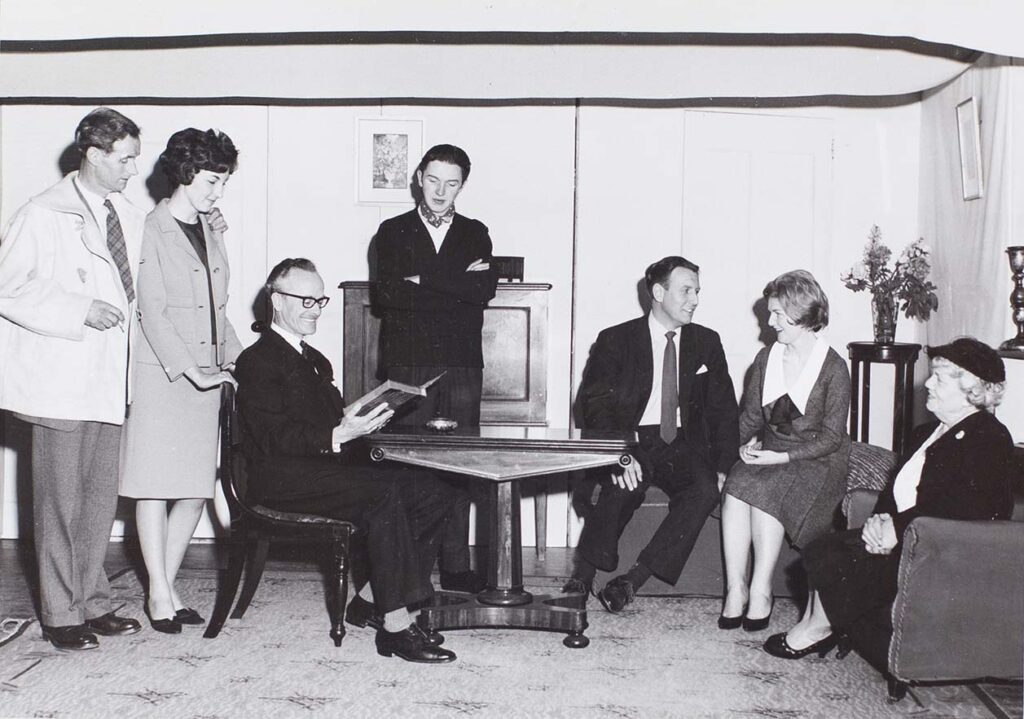
Cast in a scene from the play ‘Love from a Stranger’ in 1963.
Once married they move to an inaccessible cottage in the countryside, and as everything runs smoothly at first the young bride starts to become suspicious of her husband’s strange behaviour. As the mystery deepens she discovers that her husband is a murderer and that she is in line to become his next victim. The climax of the play sees Cicely pleading for her life while unknown to her husband, she slips poison into his coffee.
It is also documented in a newspaper article that both Diane Leeson and Edward Perkin gave compelling performances. Diane Leeson new to the players did not show any signs of stage fright and exhibited the emotions of happiness, uncertainty and stark terror within her role with conviction. Edward Perkin portrays an evil person who is planning a clever murder with a Canadian accent (that was exceptional) and also made the slow deterioration in his mental stability totally believable. Ann Cook was Mavis Wilson, the mutual friend, while Jane Caldwell played Louise Garrard the boring but charming elderly, hair-brained aunt of Cicely and Hodgson, the gardener, was performed by Matthew Shadbolt.
It was stated in two different newspapers articles that the play was performed with vivid realism by all the cast and that the producer Bob Caldwell managed to get the most from the cast’s characters with help from the lighting effects and sinister background music.
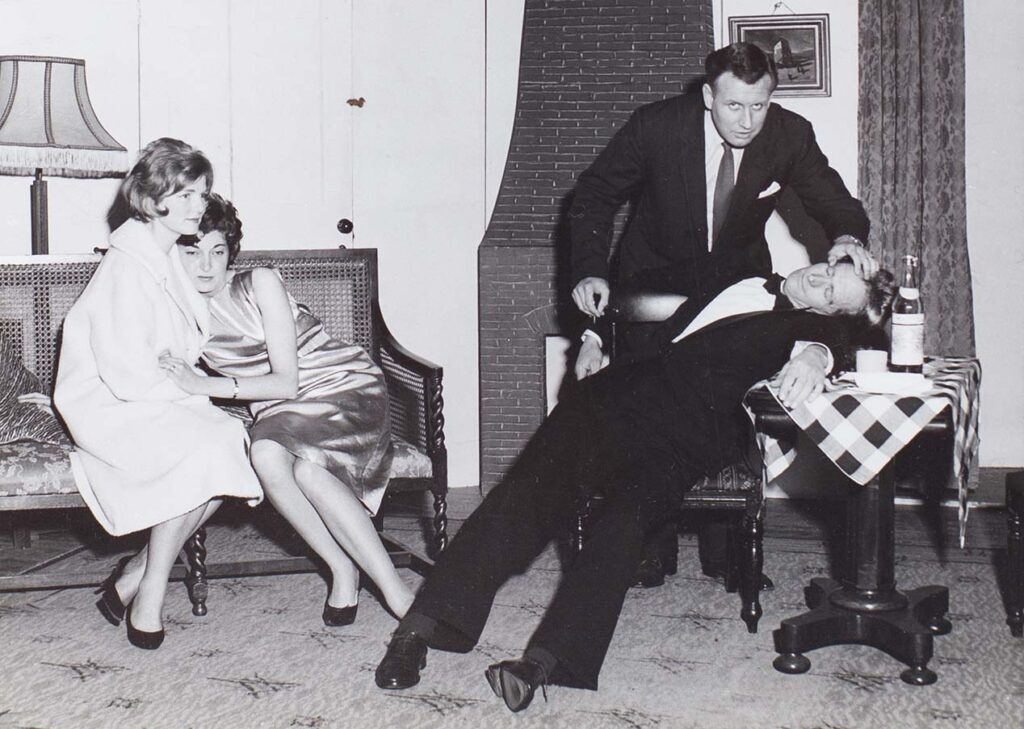
A scene from the play ‘Love from a Stranger’ performed by the Bishopsteignton Players.
It was documented on the minutes of the Bishopsteignton Players Committee dated 22/06/65 that takings from this production amounted to £43 -6s -3d whilst expenses were £45 -9s -5d.
It is also recorded in the Bishopsteignton Players accounts ledger that there was income and expenditure for the play Love in a Mist which was performed 27-29th Nov 1965.
To complete the year 1965 Bishopsteignton Players performed the pantomime ‘Robinson Crusoe’ by Conrad Carter and Trudy West at the end of December. This panto was directed by Bob Caldwell and it was the fifth year that a pantomimes had been performed in the village. Each year the productions got more ambitious and this year had a massive cast of sixty including a large number of children.
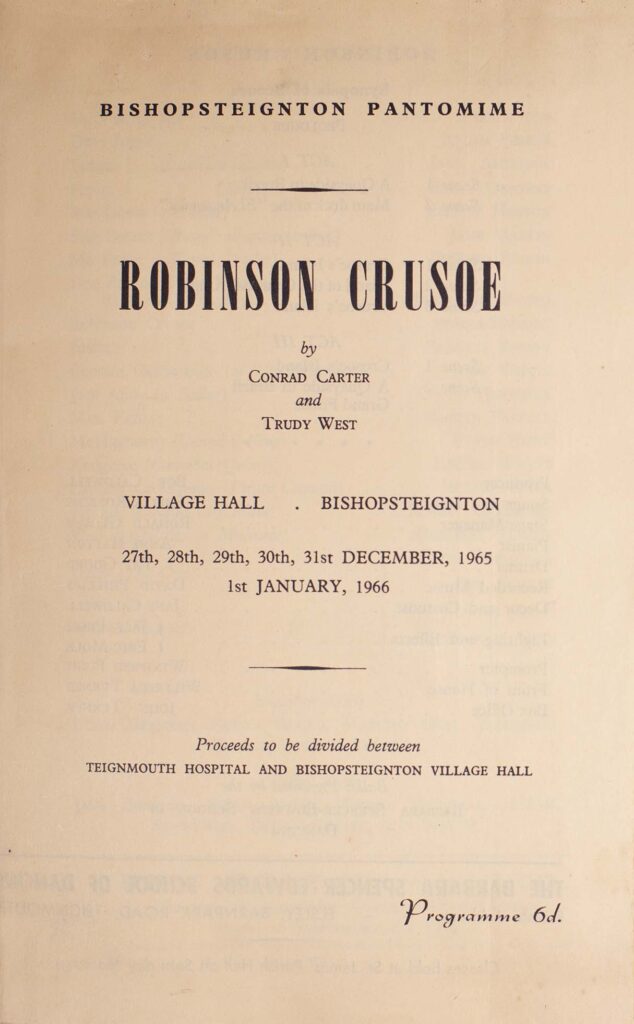
‘Robinson Crusoe’ 1965 Programme (front).
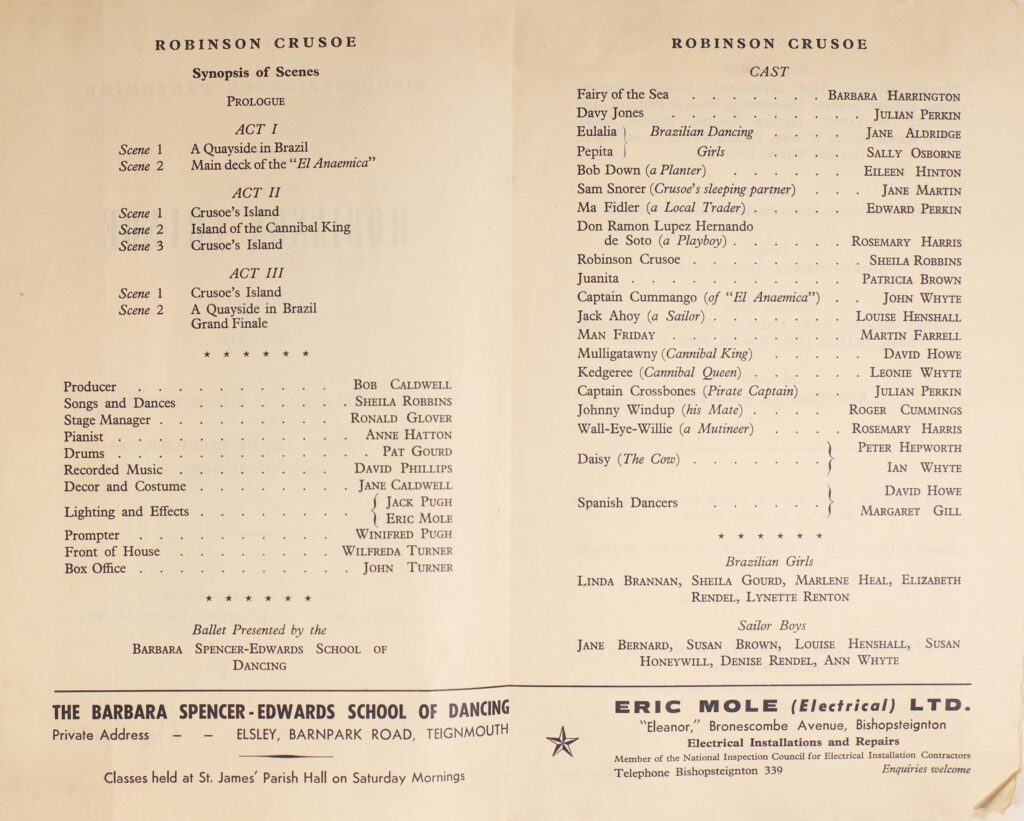
Programme (inside) for the panto ‘Robinson Crusoe’ 1965.
\
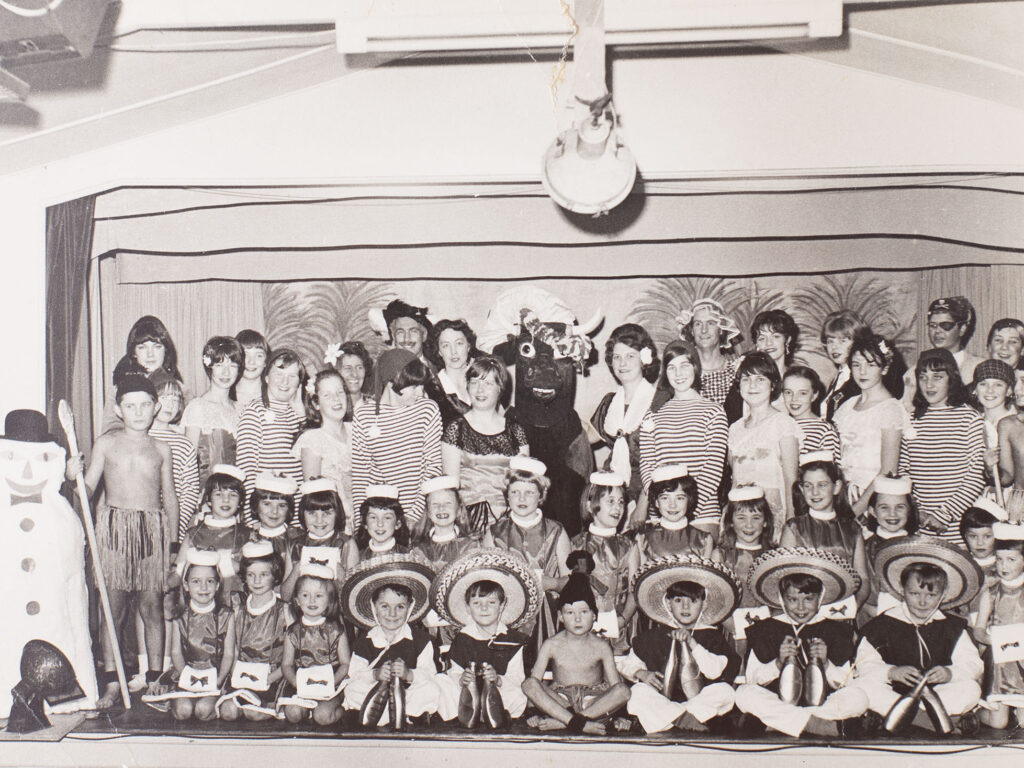
Cast in the Bishopsteignton Pantomime ‘Robinson Crusoe’ in 1965.
The 1965/1966 AGM saw changes on the Bishopsteignton Players committee. This AGM was opened by the president Mr T Turpin and was re-elected unanimously by everyone, all changes were documented in this newspaper article.
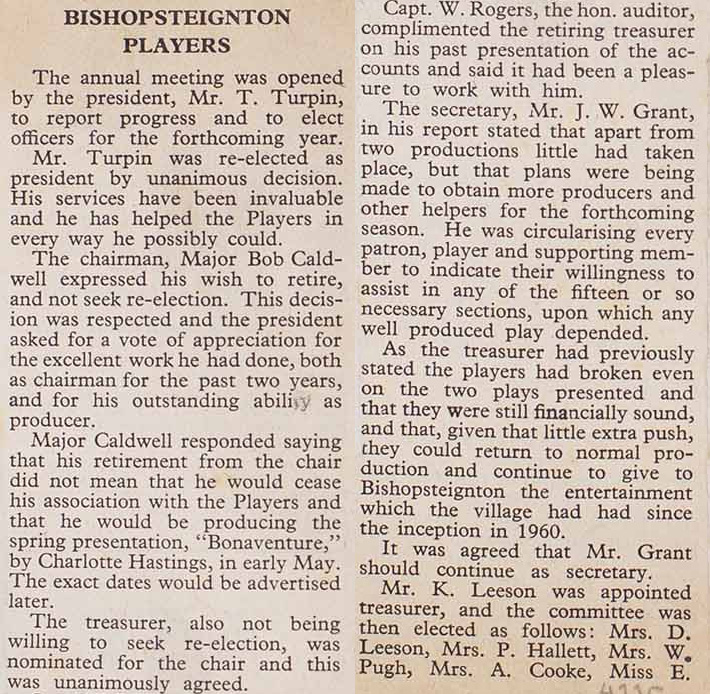
Newspaper cutting Bishopsteignton Players AGM 1966
1966
Early May 1966 Bishopsteignton Players performed Charlotte’s Hastings 3 Act Play, ‘Bonaventure’, a costume drama in which the entire action takes place in a convent of a nursing order near Norwich in 1947.
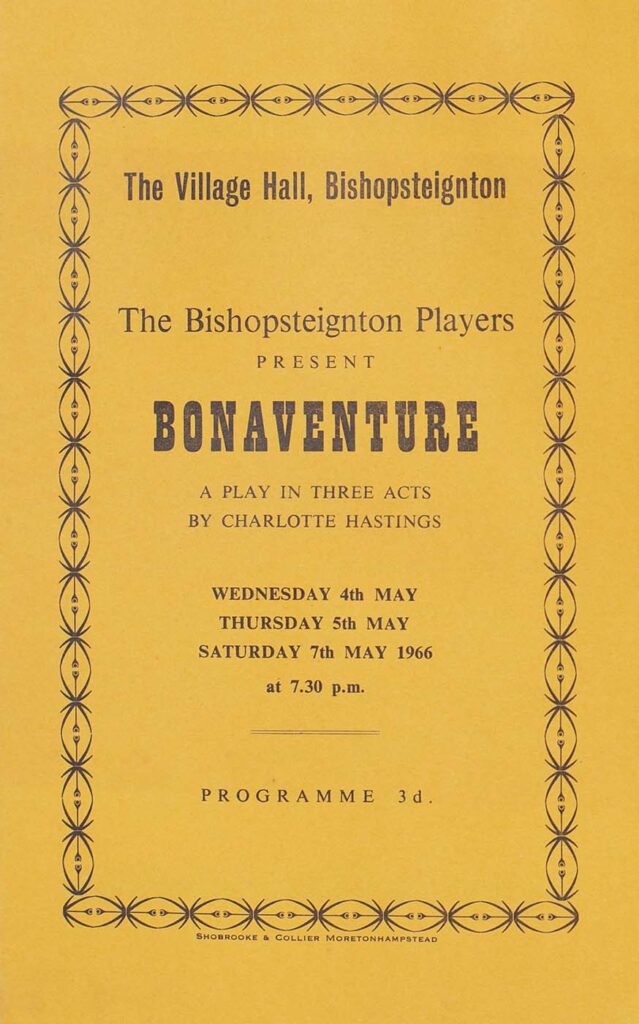
Programme (front) for the play ‘Bonaventure’ performed by Bishopsteignton Players 1966.
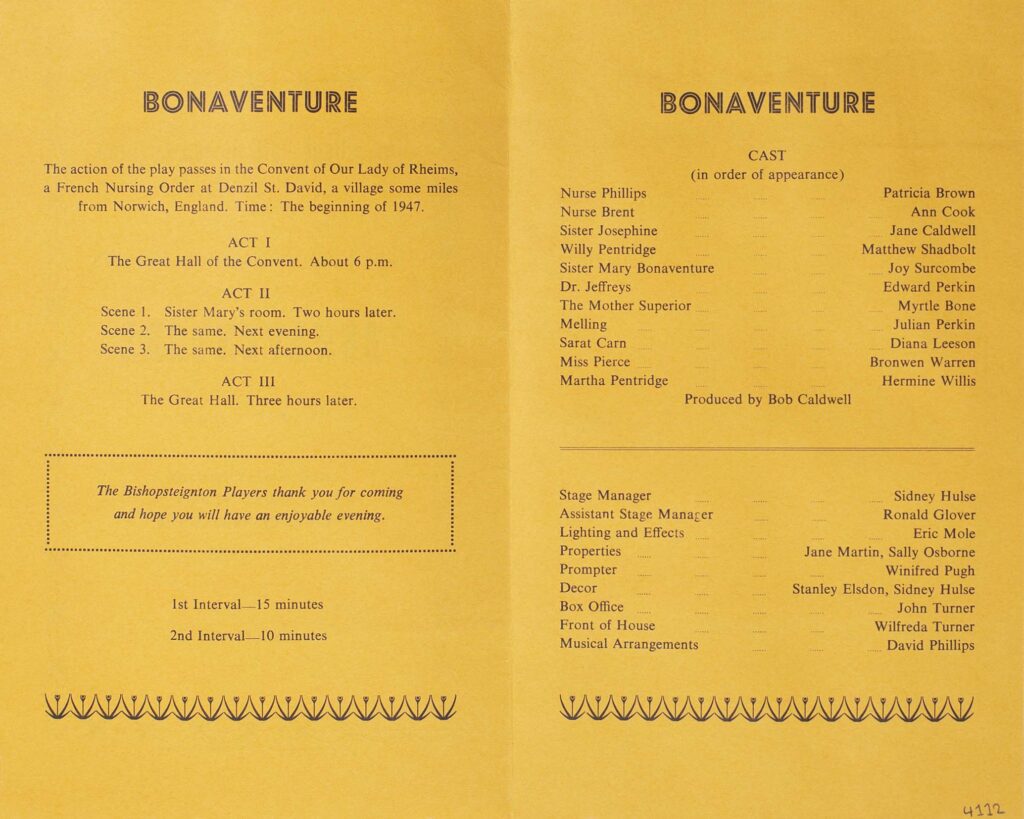
Programme (inside) for the play ‘Bonaventure’ performed by Bishopsteignton Players 1966.
The Mid Devon Advertiser dated Saturday 14/5/1966 mentioned that ‘Bonaventure’ enjoyed a successful run and was a complete sell out’. In another article it was also noted that the cast played their parts well and that the stage sets were excellent resulting in a realistic performance of a play that was very different to previous Players’ performances.
The story centres around an artist Sarat Carn who is being conveyed from the Appeal Court to prison under sentence of death for poisoning her invalid brother and involves a part of the life of Sister Mary Bonaventure, the matron of the convent hospital. Together with two prison wardens, she is stranded at the convent when the river bursts its banks and the villages in the valley are flooded.
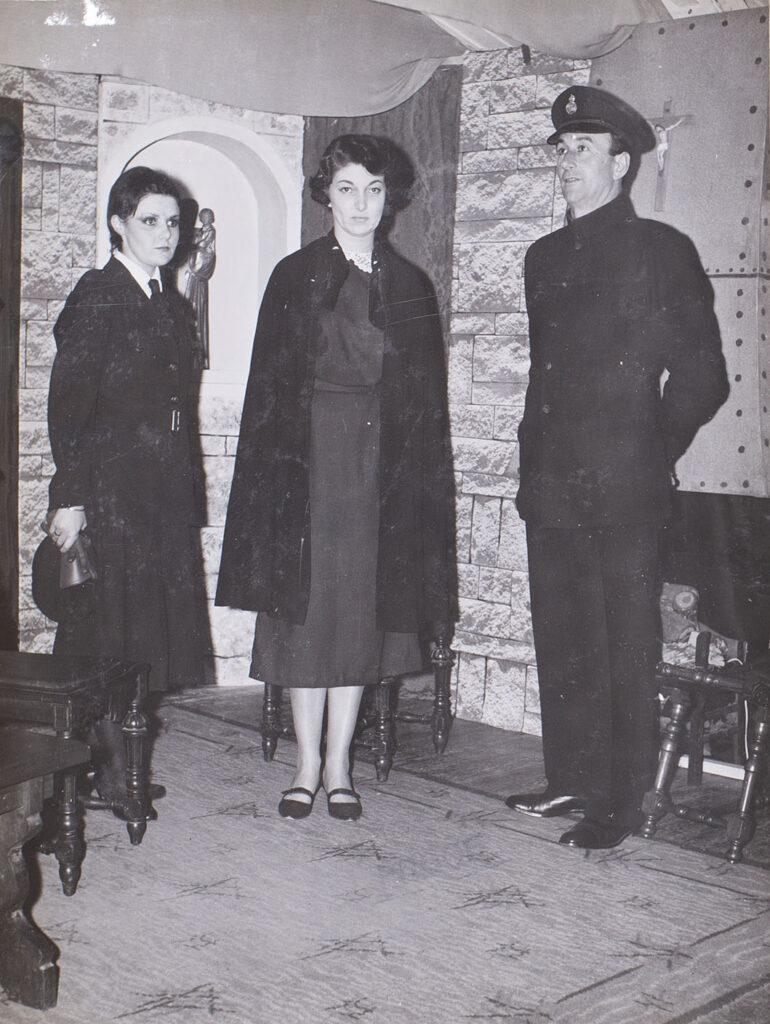
Cast in the play ‘Bonaventure’ performed by Bishopsteignton Players in 1966.
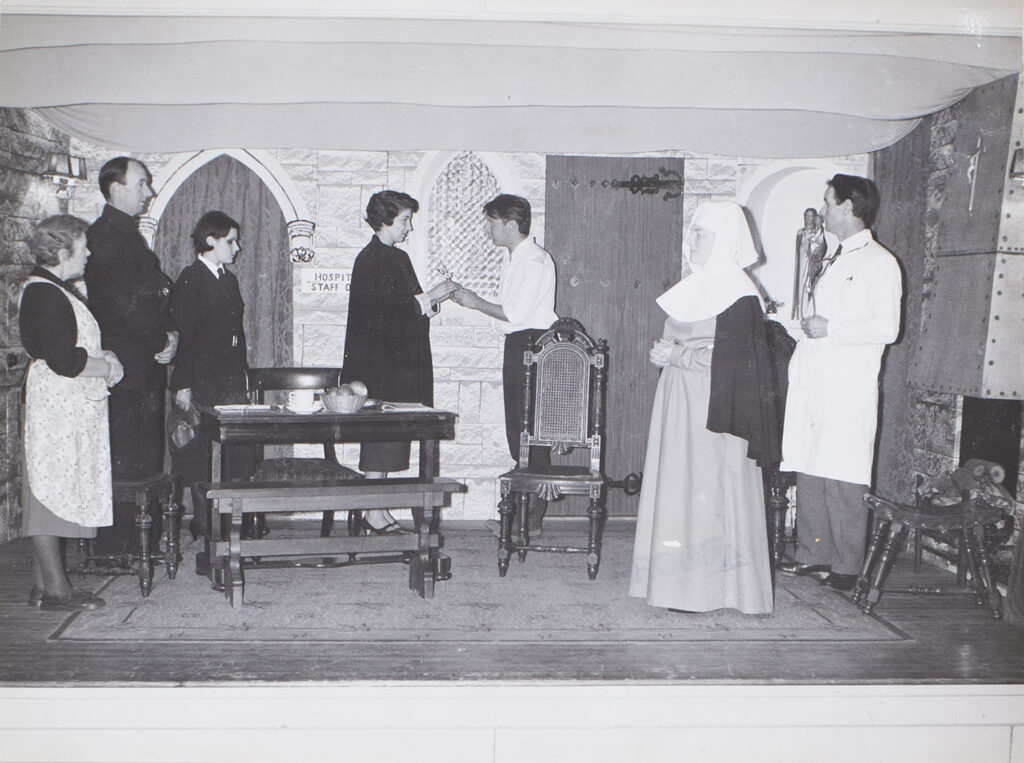
A scene from the play ‘Bonaventure’ performed by Bishopsteignton Players in 1966.
Marooned in the convent without any communication to the outside world Sarat wins the heart of all the inmates. Sister Mary Bonaventure combines human compassion, uncertain faith and a penetrating mind and within a few hours, helped by Sister Josephine, unravels the reports of the murder and reconstructs it to to find the truth and hence clears Sarat’s name of the crime while establishing the real identity of the murderer.
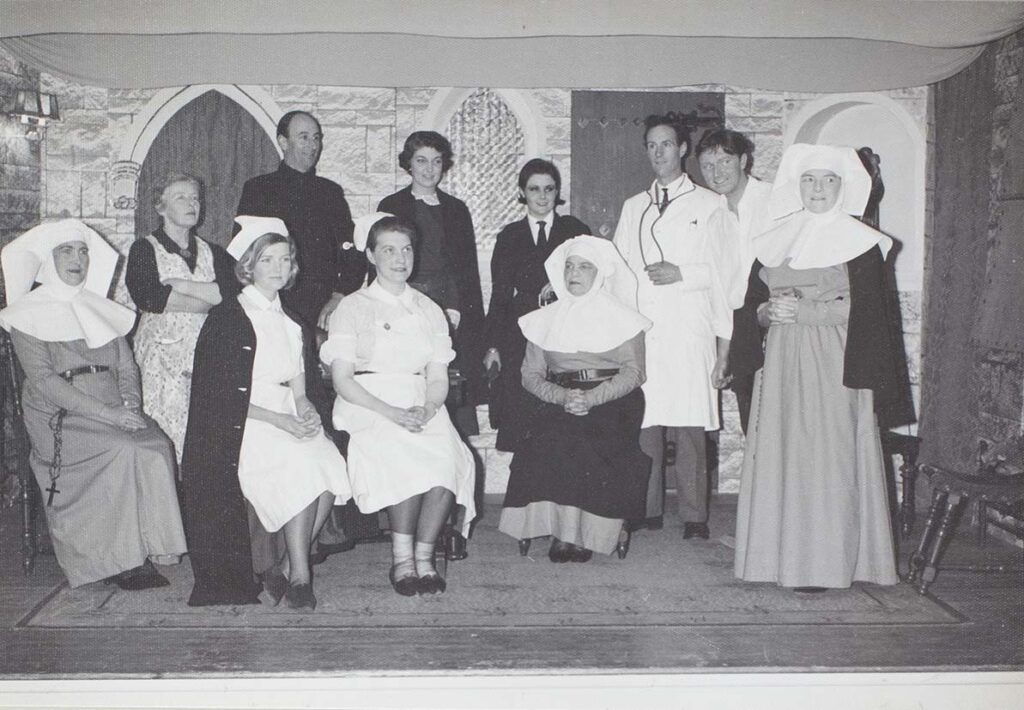
Cast of ‘Bonaventure’, performed by Bishopsteignton Players in 1966.
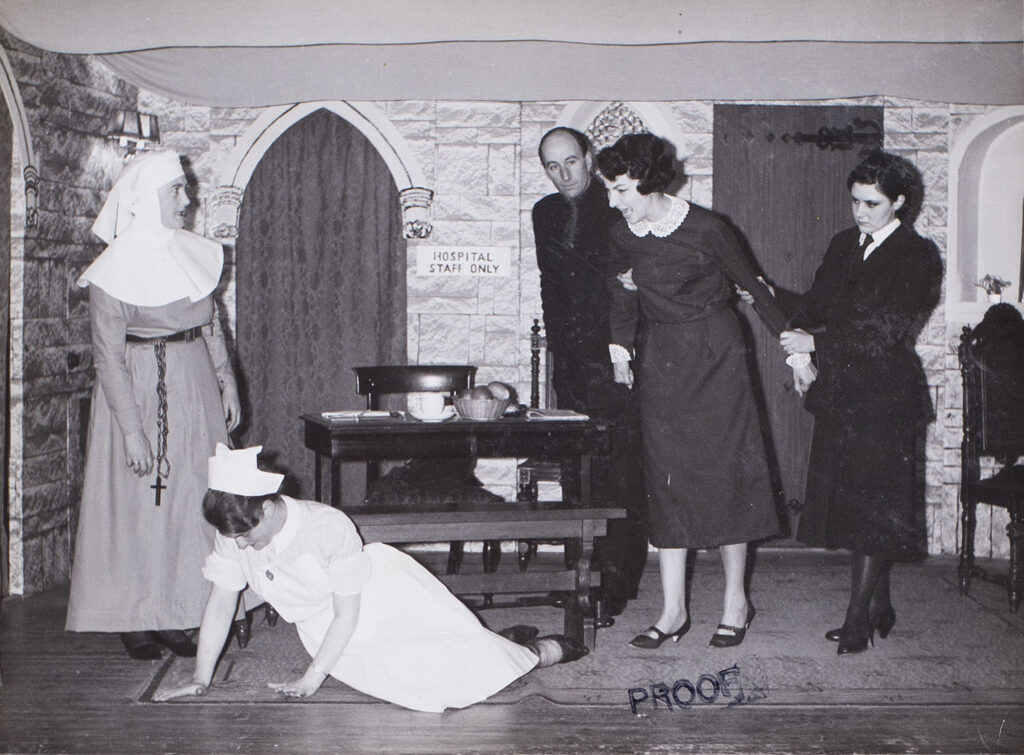
Cast in a scene from the play ‘Bonaventure’ in 1966.
Sarat Carn was played by Diana Leeson with Joy Surcombe playing Sister Mary Bonaventure, who finally proves Sarat’s innocence. Sister Josephine, the beloved cook and the gentle but firm Mother Superior were played beautifully by Jane Caldwell and Myrtle Bone. Julian Perkin and Bronwen Warren played the uncomfortable roles of the two prison officers. Matthew Shadbolt’s portrayal of Willy Pentridge, the simple handy lad was excellent while Edward Perkin’s role as Dr Jeffreys, was the villain who finally commits suicide. Hermine Willis was Martha Pentridge, Willy’s mum who was previously Sarat’s housekeeper and also the chief witness at Sarat’s trail. The newspaper article reviewing this play mentioned that Bob Caldwell and all his assistants behind the scenes were to be congratulated on a very successful and entertaining evening in the village hall.
Again looking through the Players’ accounts ledger it documents the expenditure and income from an evening of Two One Act Plays named Ladies Bar and All My Juliets that were performed on 22 Oct 1966.
This year’s annual pantomime performed by the Players was ‘Babes in the Wood’ and was produced by both Jane and Bob Caldwell. Proceeds from this panto were divided between Teignmouth Hospital and Bishopsteignton Village Hall.
Sheila Robbins was Robin Hood, with Pat Brown playing the role of Maid Marion. There were a large number of children in this panto with the total number of cast reaching 70.
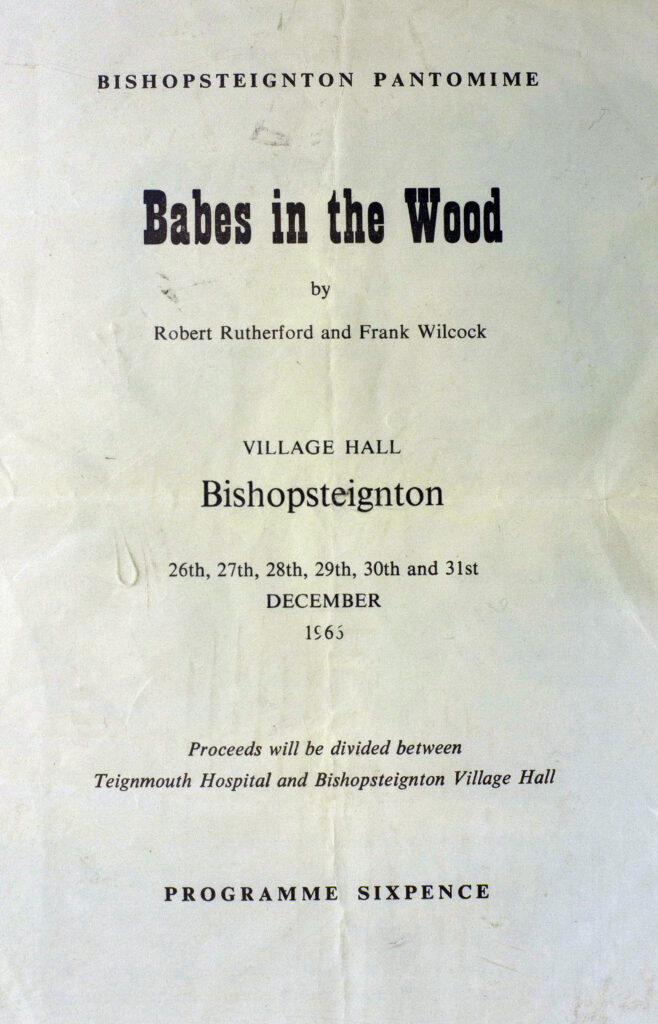
‘Babes in the Wood’ Programme front.
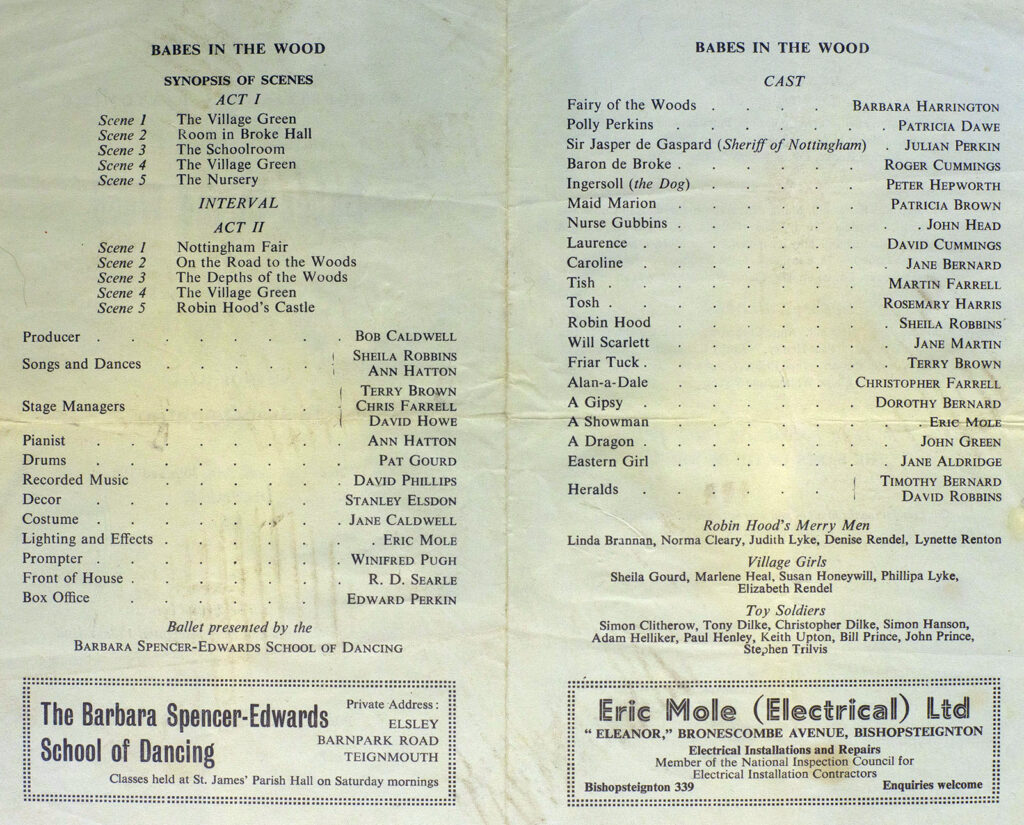
Programme for Babes in the Wood
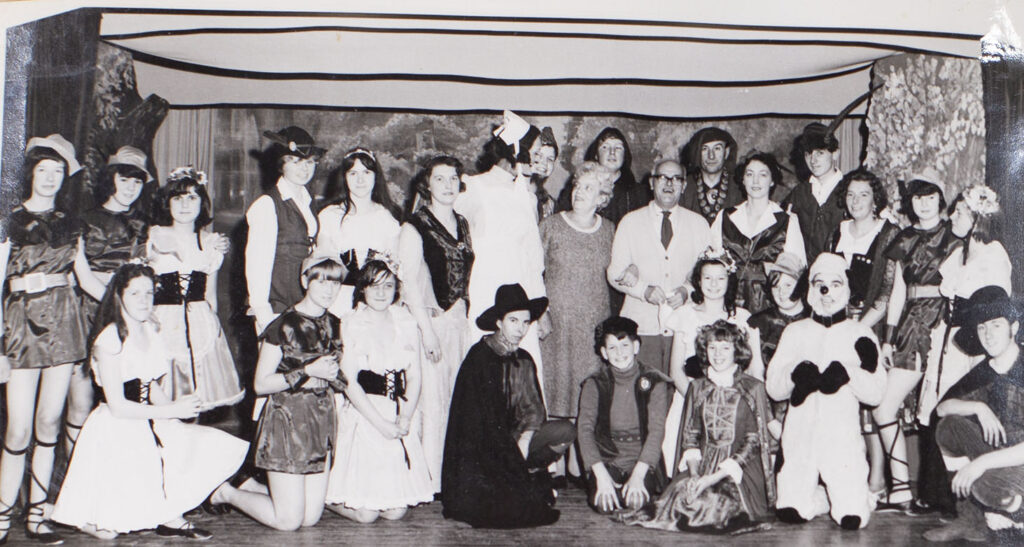
Programme (front) for the panto ‘Babes in the Wood’ 1966.
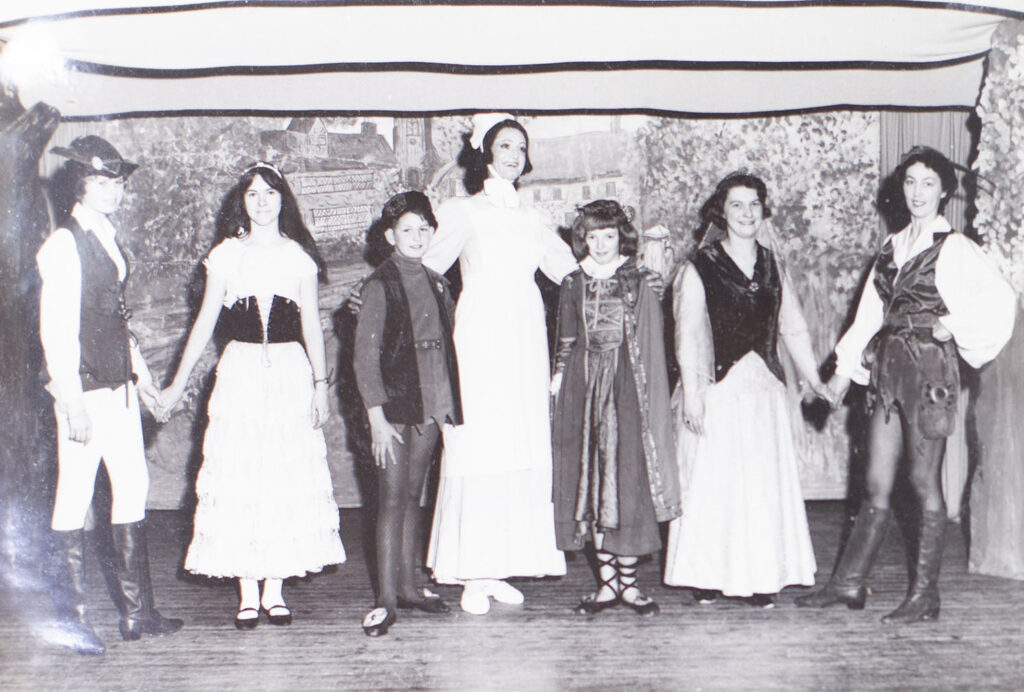
Cast in a scene from the panto ‘Babes in the Wood’, 1966.
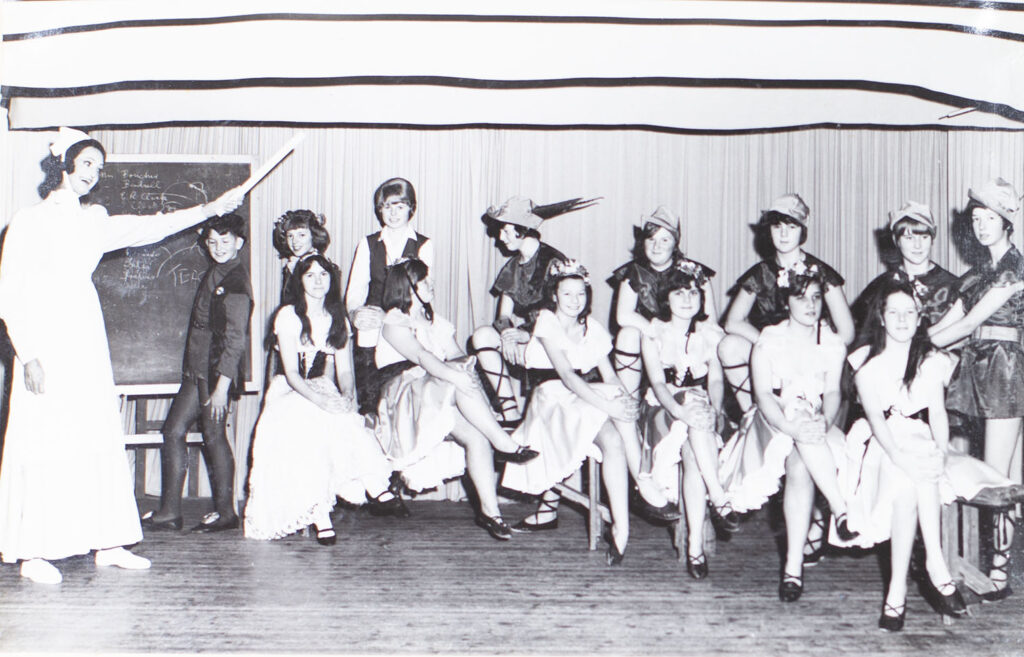
Scene from the panto ‘Babes in the Wood’, 1966.
1967
April 1967 ‘Here we come Gathering’ by Philip King and Anthony Armstrong, was performed.
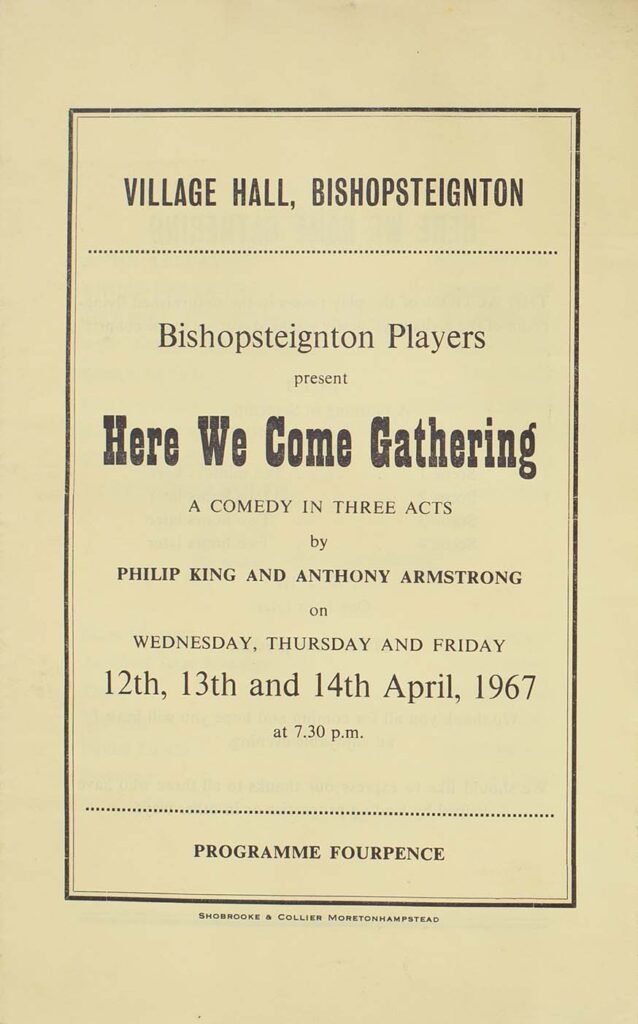
Front Programme for the play ‘Here we come Gathering’ in 1967.
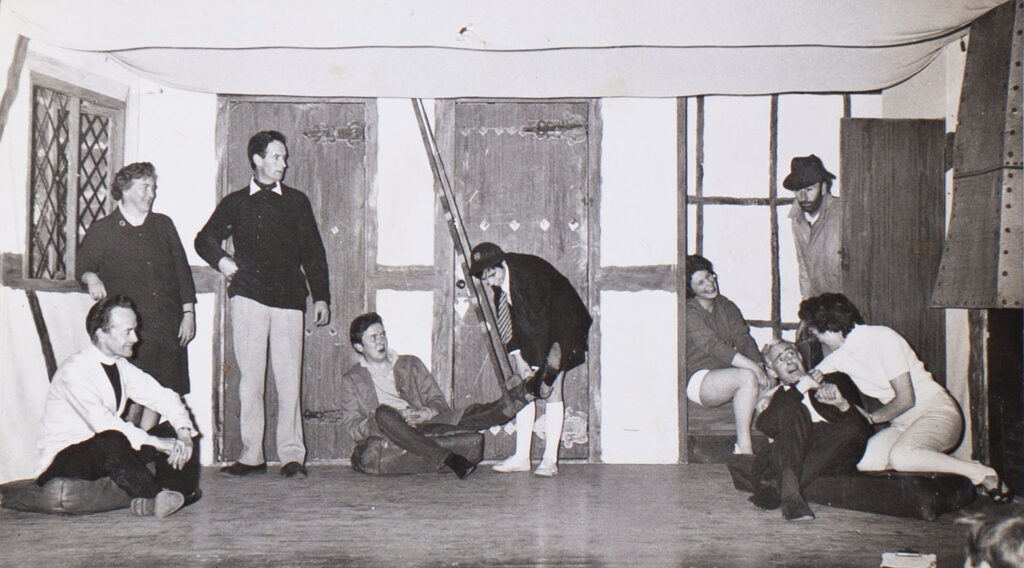
A scene from the play ‘Here We Come Gathering’ in 1967.
This play, described as an ‘hilarious comedy’ in its press review, was not the easiest to act out on the stage. Set in an empty house, the stage was devoid of furnishings which could have proved problematical, but the cast dealt with it well. The story of Here we Come Gathering centres on a newly acquired cottage in the country and the Kellaways, the couple who are trying to move into it. Played admirably by Sheila Robbins and Edward Perkin, Anne, an actress and Philip, a would-be author, have to negotiate the break-down of the van delivering their furniture, mother-in-law problems, jealousy that is causing a rift and the collapse of the rickety bridge that connects the cottage with the outside world. Joy Surcombe played Harriet, Philip’s mother, a ‘veritable she dragon’ and Dick Searle played Gray Meredith, Anne’s leading man and the object of Philip’s jealousy.
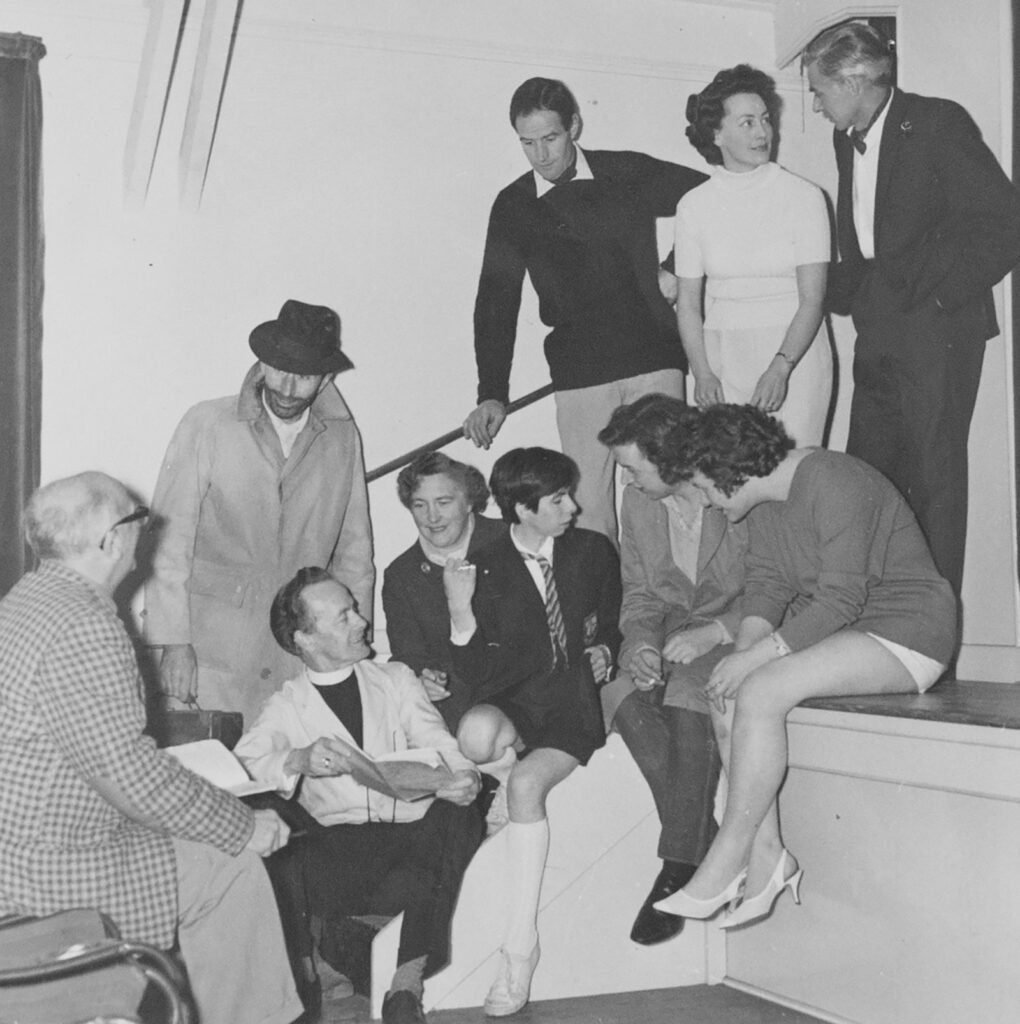
Bishopsteignton Players in ‘Here We Come Gathering’.
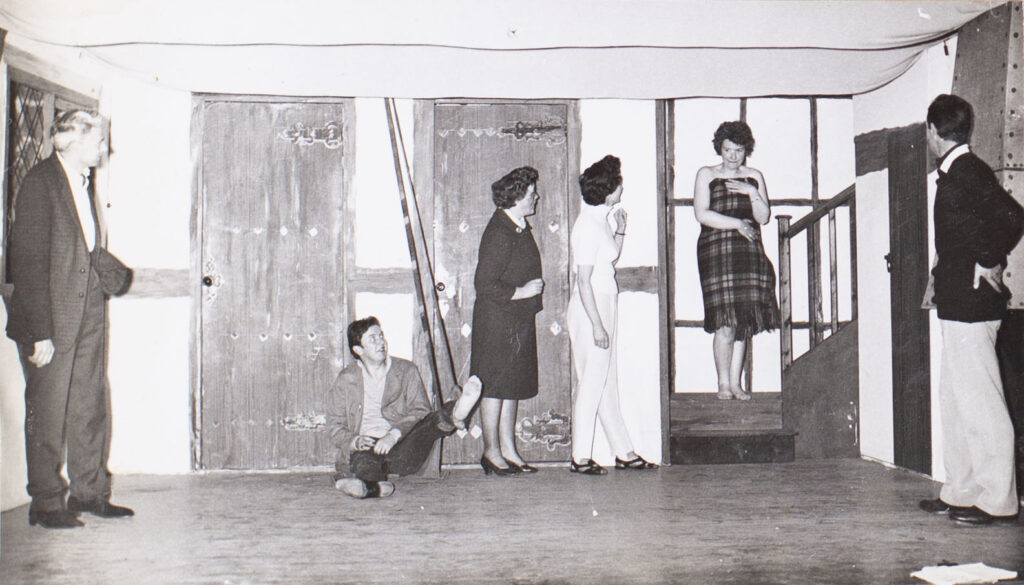
The cast in a scene from ‘Here we Come Gathering’ 1967.
The parts described as the ‘nuts’ of the play were the driver of the furniture van, played by Mathew Shadbolt and Evadne Potter a precocious schoolgirl and girl guide, played by Rosemary Harris, both great comic performances.
Other cast members included John Turner, Patricia Brown, Luke Betterworth and Julian Perkin. The play was produced by Bob Caldwell.
Described as a ‘play of suspense’, ‘The Secret Tent’ by Elizabeth Addyman was the second Bishopsteignton Players’ offering for 1967. This praiseworthy production was the story of a young wife who disappears and is wrongly identified as having been murdered. She returns from the dead to face her husband who, in the meantime, has discovered details of her past that seem she is not what he thought. It appears that she was a victim of terrible circumstances in her childhood who ran away from home and ended up in the care of a criminal gang. She was arrested at a burglary and spent time in an approved school at 14 and was pregnant at the time. Meaty stuff indeed!
The husband, Christopher Martyn, was ably played by Richard Searle and his wife Ruth by Sylvia Coyle, in her debut performance for the Bishopsteignton Players. Ruth only appeared in the first scene and the final act of the play and achieved an incredibly emotional performance without which the play could have been ruined.
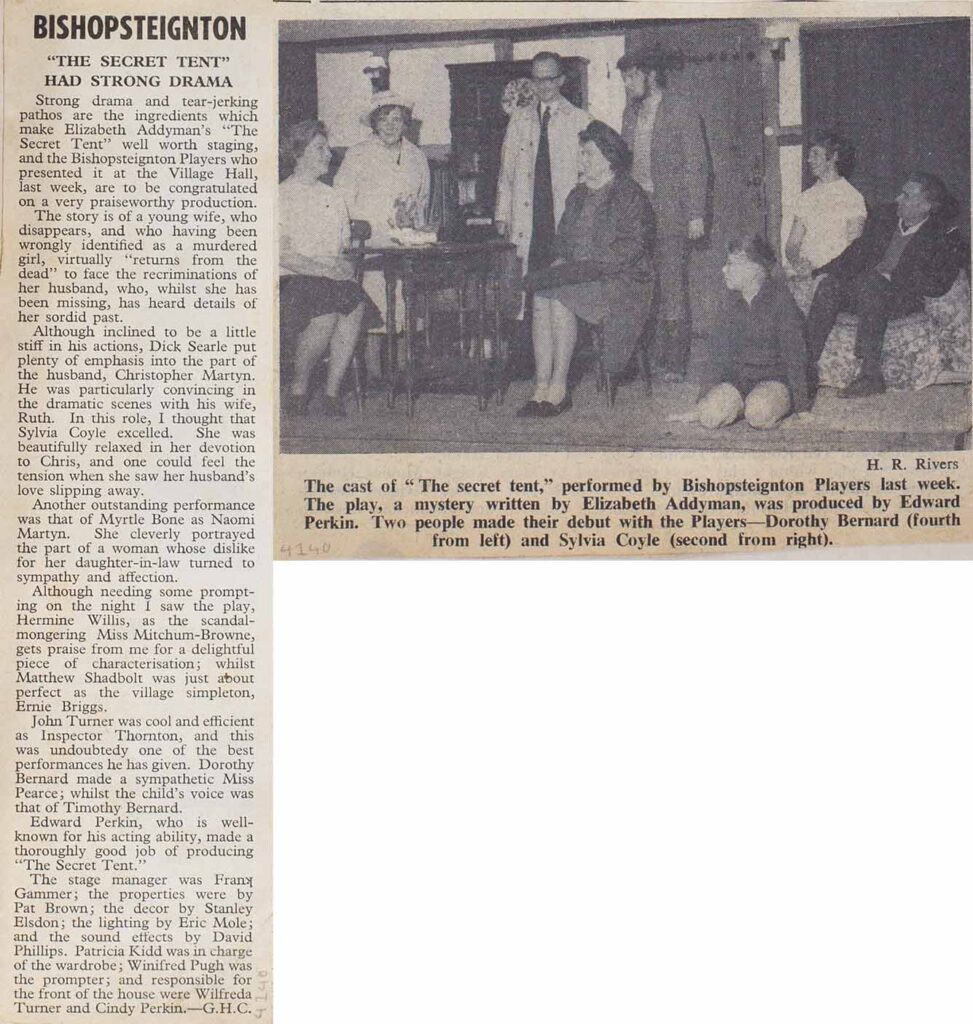
A scene in the play ‘The Secret Tent’ produced by Edward Perkin of Bishopsteignton Players.
This play was also Edward Perkin’s debut as producer after many acting roles with the players. Other parts, most of them quite small, were played by Myrtle Bone as Christopher’s mother, Hermine Willis, Mathew Shadbolt, Dorothy Bernard and John Turner.
1968
In 1968 the Players performed two plays ‘Intent to Murder’ and ‘The Jilted Ghost’.
The beginning of May saw the performance of Intent to Murder by Leslie Sands and directed by Keith Leeson, his first production. The play was a spine-tingling thriller and the parts were played competently and powerfully by the cast.
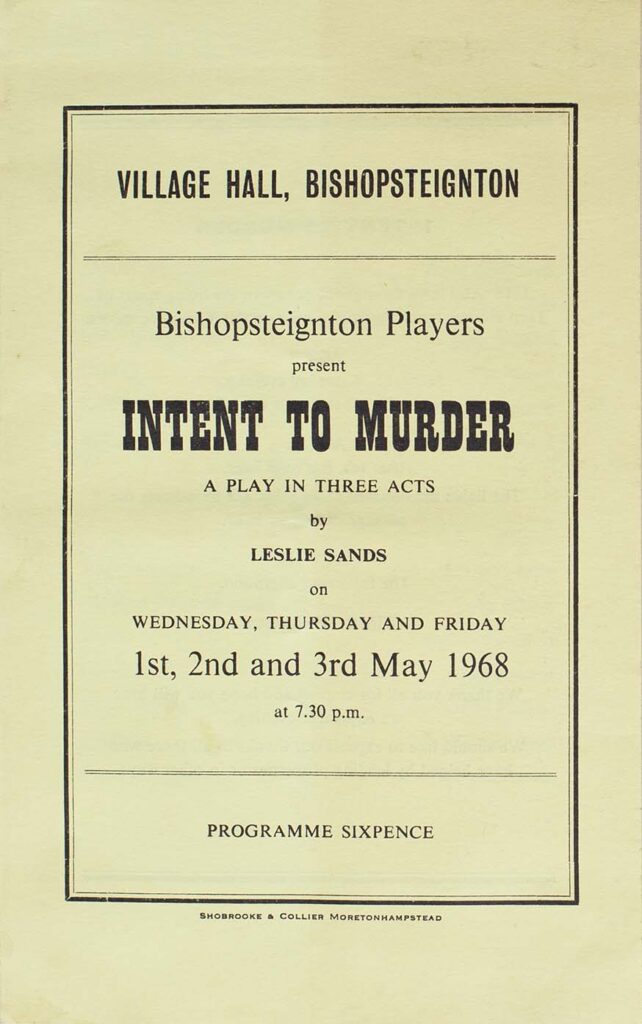
Programme for the Play ‘Intent to Murder’ 1968.
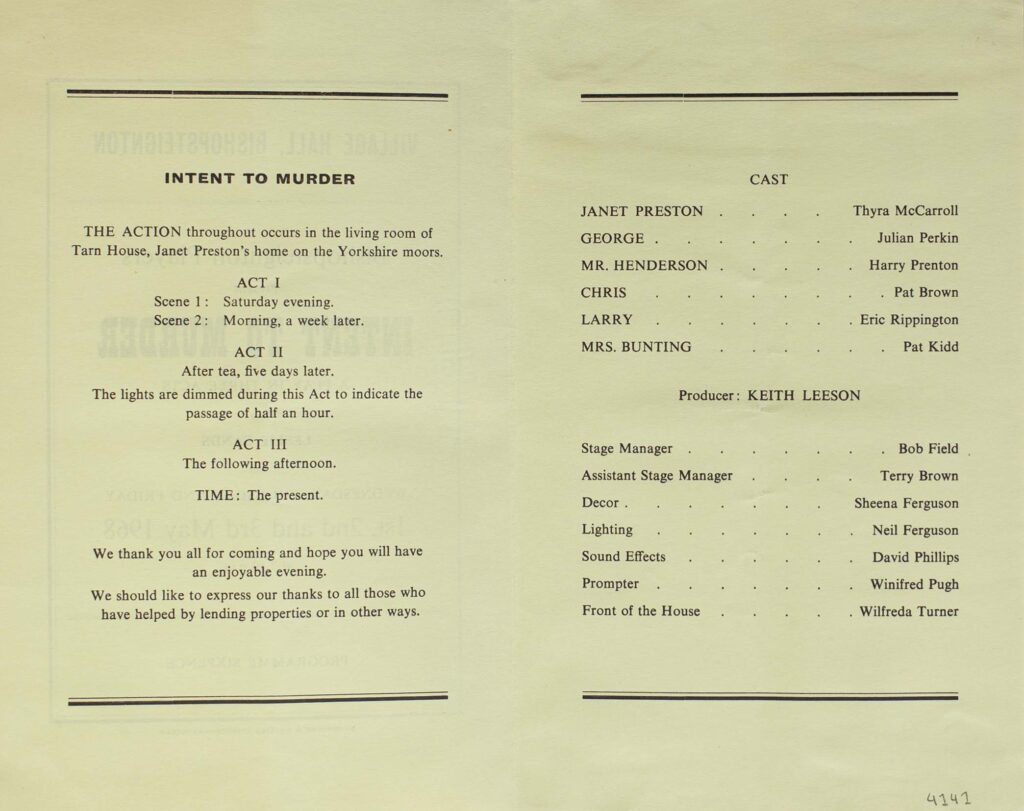
Programme for the play ‘Intent to Murder’ 1968.
The story starts with a man rising up from an arm chair in a darkened living room in a house on the Yorkshire moors which is owned by Janet Preston played by Thyra McCarroll. When Janet returns to the house this mysterious stranger called George, played by Julian Perkin, is looking for her husband, but she denies any knowledge of his whereabouts. Janet is unsure whether George is telling the truth until he claims that he was her husband’s partner in a bank raid in which a policeman was shot. Janet is then forced to tell George that she has murdered her husband by poisoning him and was about to dispose of the body when he appeared. After both revelations they themselves become partners in crime.
More trouble is ‘in tow’ when Janet’s secretary Chris, acted by Pat Brown, and her fiancé Larry, played by Eric Rippington arrives two days earlier than expected at the house for three weeks.
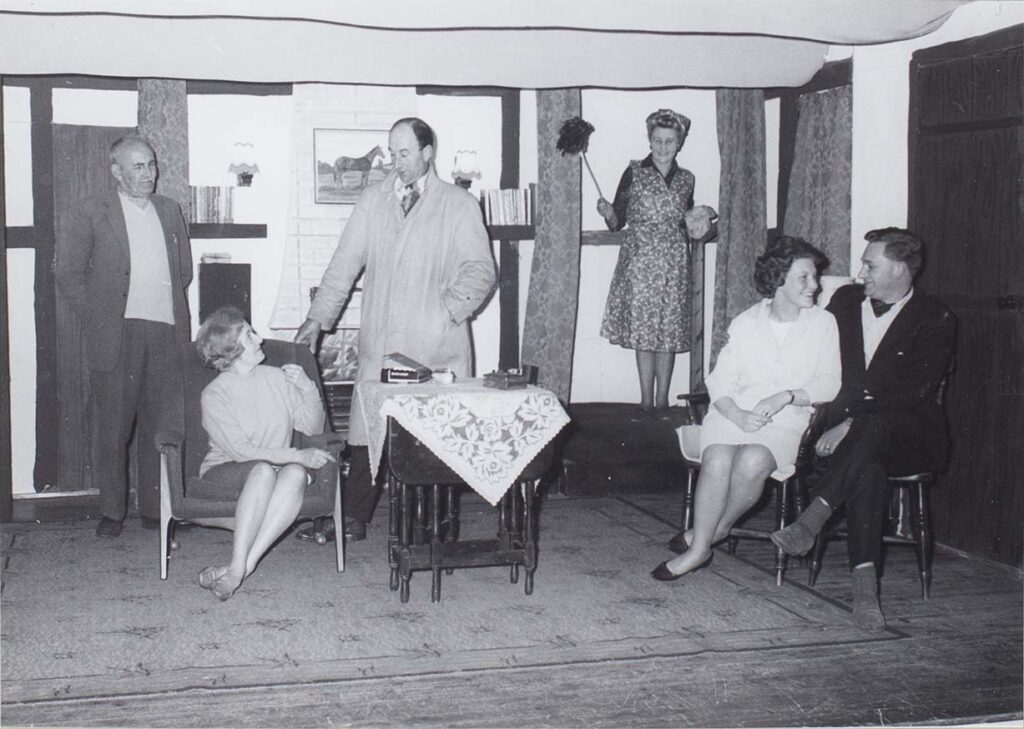
Scene from the play ‘Intent to Murder’ 1968.
The relationship between Janet and George starts to deteriorate which results in Janet trying to attempt to kill George by urging him to drive an unsafe car. This doesn’t go to plan and George escapes with only cuts and bruises but believing George is dead Janet explains the whole story to a friend Mr Henderson, the local vet surgeon played by Harry Prenton. After finding George alive Janet contacts the police, informing them that he is at the house; however, Mr Henderson has already unravelled her role in the murder plot to the police as well. Realising all is lost Janet leaves for the police station with Mr Henderson hiding a bottle of poison in her hand providing her with her only means of escape.
Sam Bate’s, The Jilted Ghost directed by Bob Caldwell, was a comedy which provided the audience with many laughing moments.
[
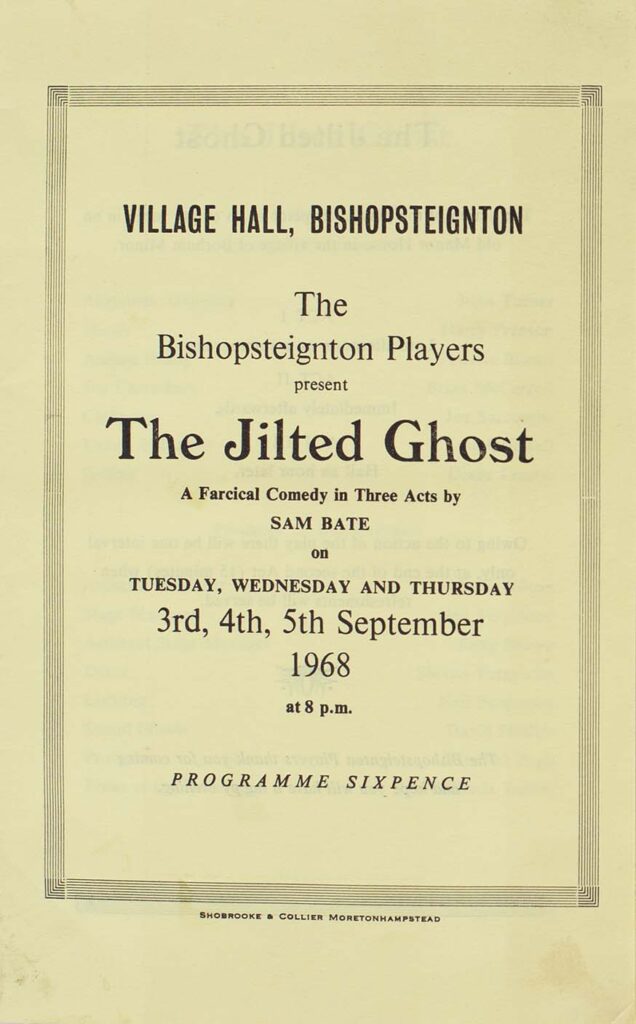
Programme (front) for the play ‘The Jilted Ghost’ performed by the Players in 1968.
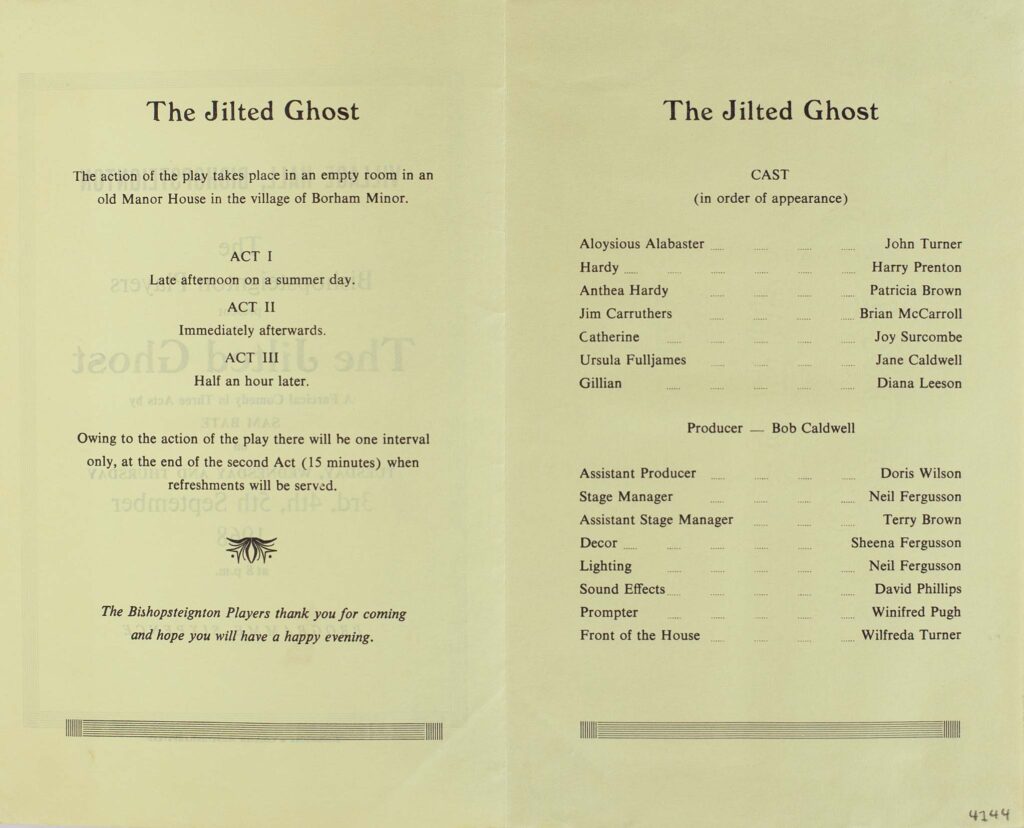
Programme (inside) of the play ‘The Jilted Ghost’ performed by the Players.
In the Bishopsteignton Heritage archives there are several newspaper articles commenting on this play and one of them is titled ‘The ghost walks at Bishopsteignton’.
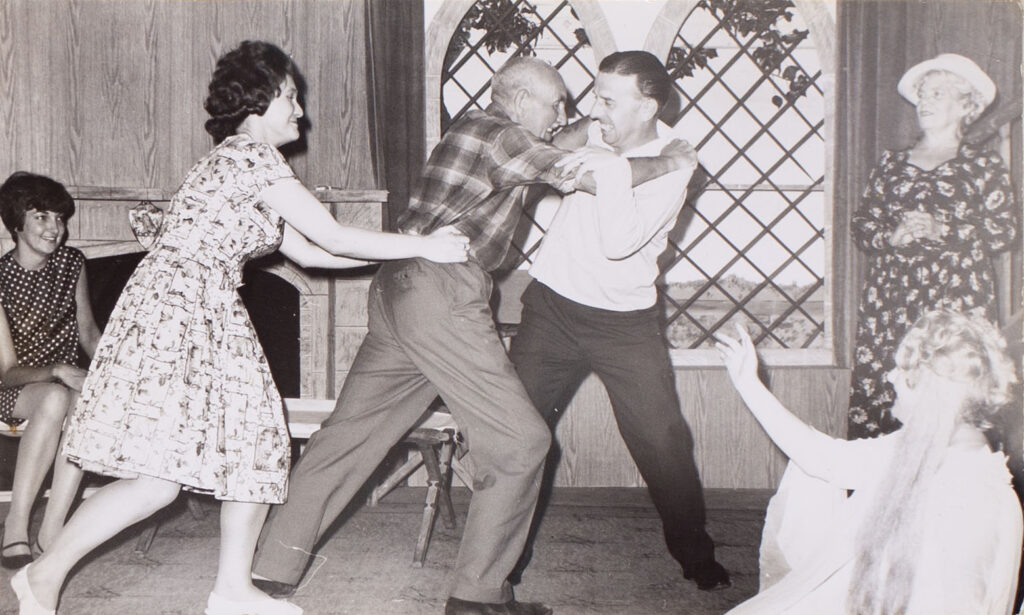
Cast of ‘The Jilted Ghost’, Bishopsteignton Players 1968.
The story centres around Jim Carruthers, played by Brian McCarroll, who is a pop star and very tired of his publicity and screaming fans; so he escapes to an old manor house which is haunted, in Burham Minor with the help of his solicitor, Aloysious Alabaster, played by John Turner.
When Jim arrives all is well but the peace and quiet does not last long when he meets Catherine, the jilted ghost. Catherine who is played by Joy Surcombe, recalls how she was jilted at the alter after the battle of Waterloo and Jim soon realizes it is him she believes jilted her and who has come back to life, but in fact it was his ancestor Red Carruthers. No one else can see the ghost apart from Jim and so its very difficult to prove her existence.
One day Jim goes into the village under the name of Brown to prevent him from being recognised by anyone. However, teenager Anthea Hardy, played by Patricia Brown, recognises Mr Brown, follows him home and introduces herself to him, then faints as she flings kisses and cuddles on him. Ursula Fulljames, the vicar’s wife played by Jane Caldwell, also comes to the house and recognises the star and also flings herself on Jim and also faints.
Jim not only has the ghost to worry about, but also Anthea’s father, Hardy, the local blacksmith, played by Harry Prenton who wants to give Jim a beating for stealing his daughter’s and wife’s affections. Jim’s secretary Gillian, played by Diana Leeson, does not like Jim and when she arrives is pleased that Hardy has given him a black eye. However, to prevent Jim from being further hurt Catherine puts Gillian in a trance and hence agrees to marry Jim (who has always liked Gillian), resulting in the daughter and wife running off crying at the prospect of Jim getting married. To prevent Jim and Gillian from leaving the manor after the marriage Catherine also puts Jim in a trance.
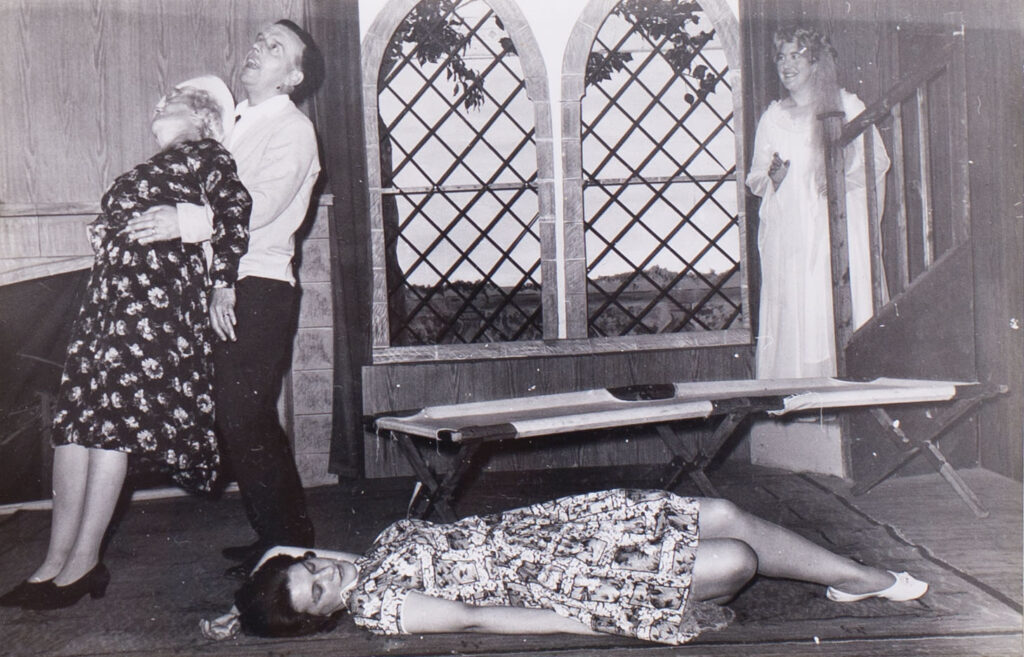
Scene from ‘The Jilted Ghost’ 1968.
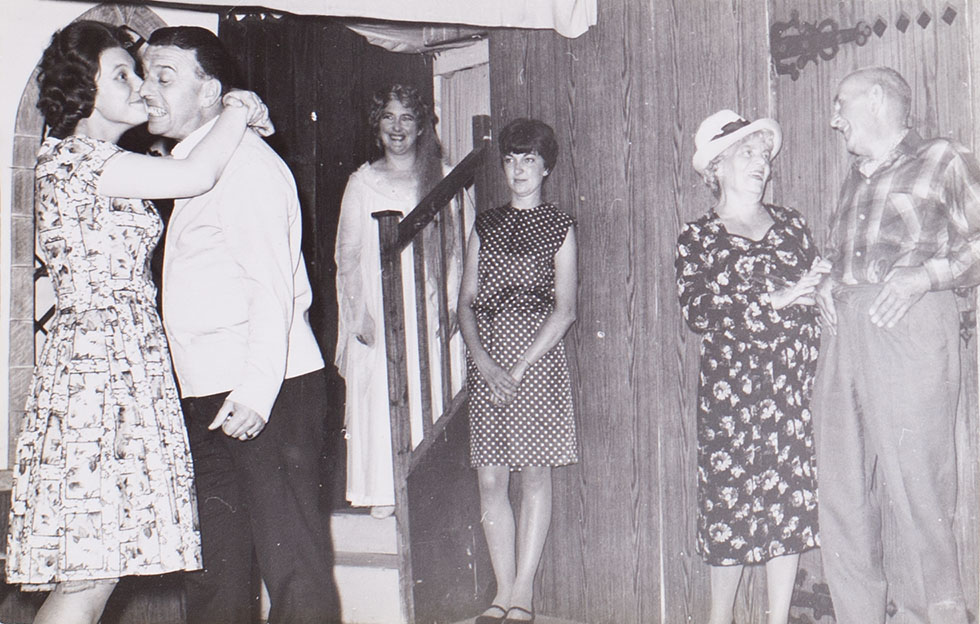
Cast in the play ‘The Jilted Ghost’, 1968.
It was documented in a newspaper article that the performance was well acted with the cast confidently playing their roles faultlessly and was well publicised, however the opening night saw a small audience. It had increased to full capacity for the second and third performances.
A short excerpt of this play was re-enacted during one of the Players social evening, the ‘Ploughboy Supper’ which was held for their friends and family. David Phillips provided the music for dancing on his record player with Brian McCarrol playing the piano for the sing song. Prizes were given for the best dressed plough boy and milkmaid and also spot prizes for the dancers. A good evening was had by all.
1969
1969 started with the production of ‘The Haxtons’
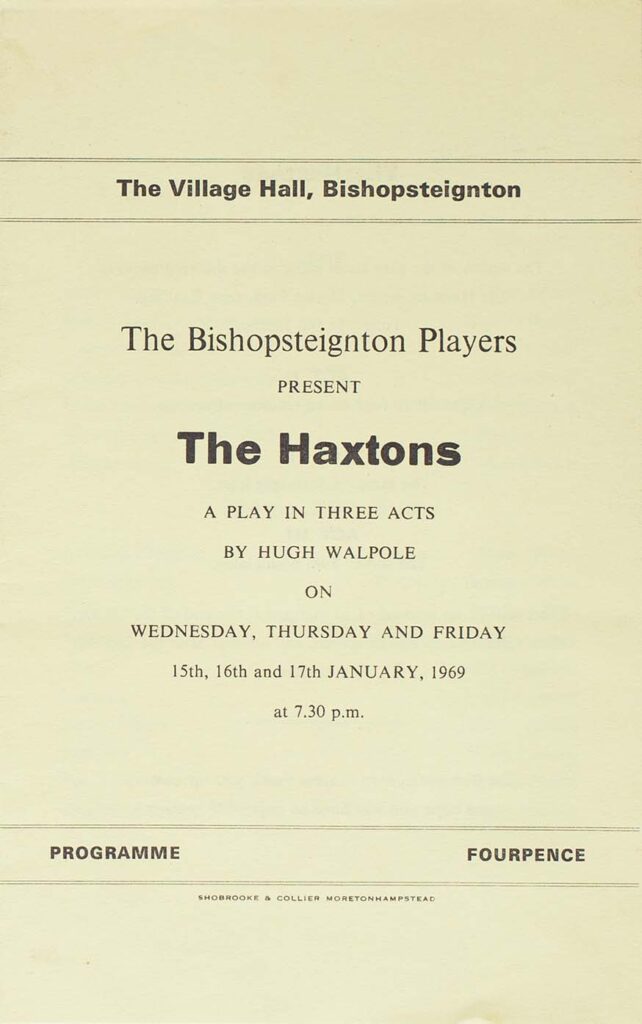
Programme for ‘The Haxtons’ in Jan 1969.
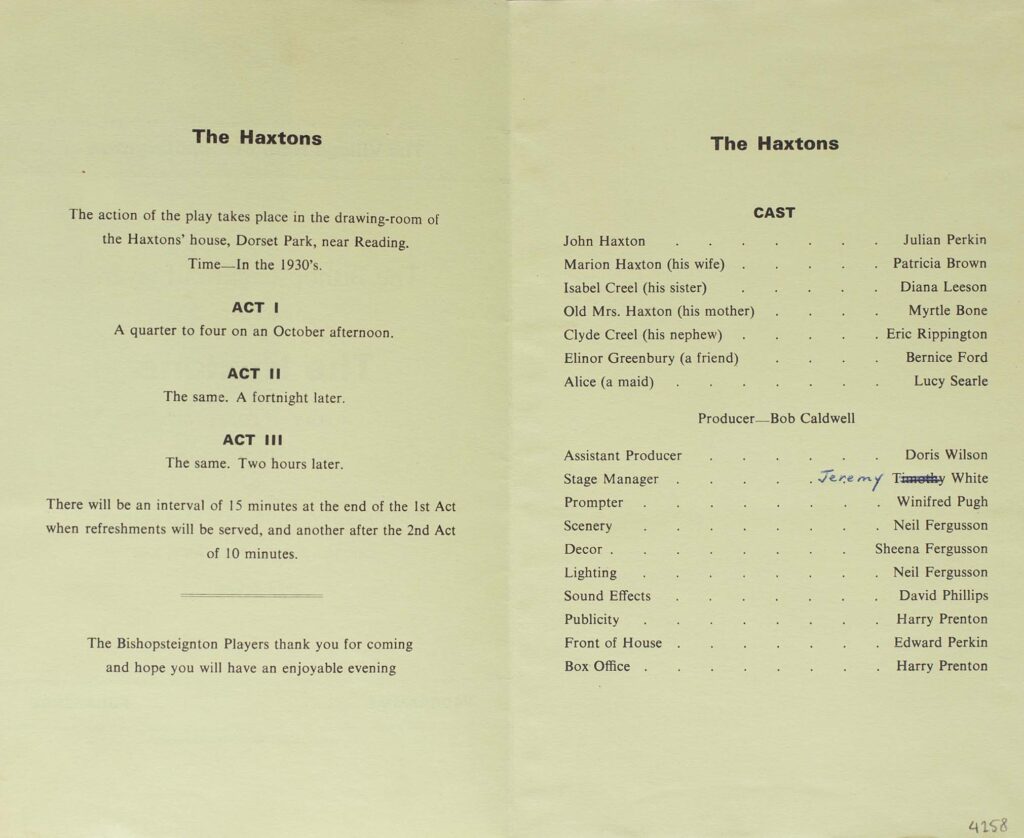
Programme for The Haxtons, Jan 1969.
The Haxtons, a three act play by Hugh Walpole, was described as a ‘play of emotions’, by the local press. Set in the 1930s, the play revolves around a proud, traditional English family whose world is turned upside down when Marion Haxton, the lady of the house, is convicted of stealing a pair of baby shoes. The family turn against her and she fights to win back their friendship but finds herself in a struggle for her husband’s affection with his sister Isabel. The play needed great characterisation, and the producer, Bob Caldwell successfully chose his cast well. Patricia Brown was thoroughly convincing as Marion Haxton and her husband John was played to perfection by Julian Perkin. Diana Leeson took on the rather cold character of Isabel, John’s sister, who works to turn the family against Marion. Other characters were played by Eric Rippington as Isabel’s son Clyde, Bernice Ford, Myrtle Bone and Lucy Searle.
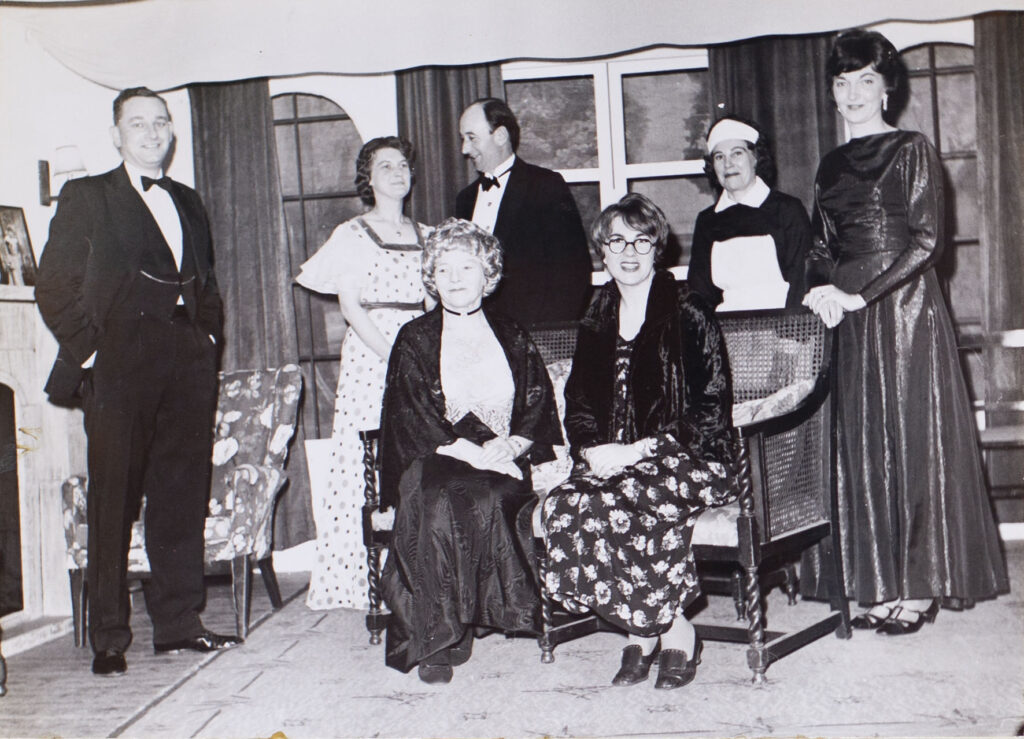
The cast of ‘The Haxtons’, Bishopsteignton Players Jan 1969.
In May of 1969 the Players performed ‘Poet and Pheasant’, a comedy in three acts by Willis Hall and Lewis Jones.
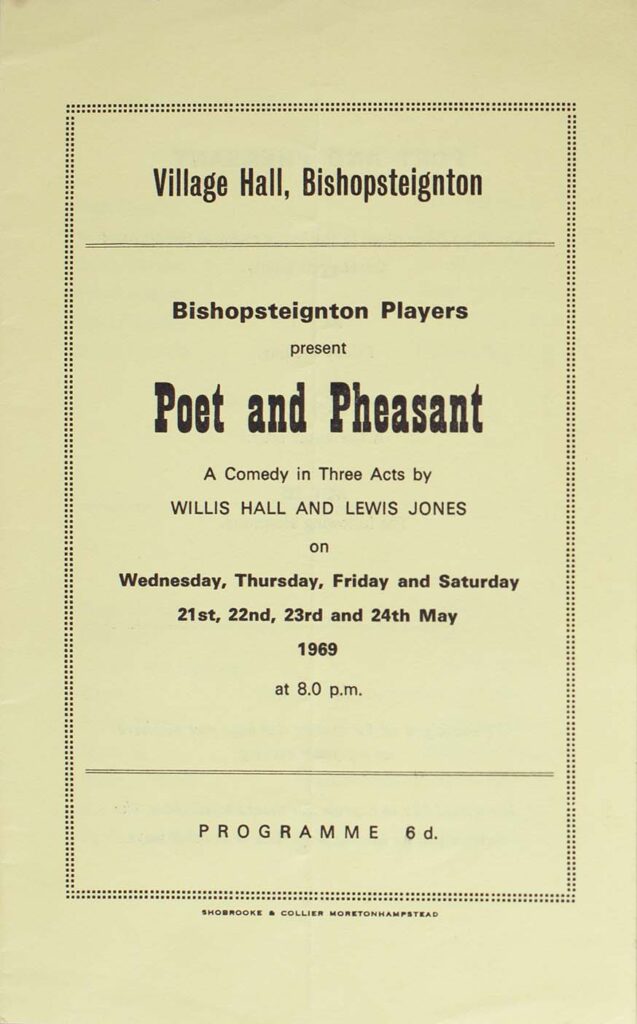
Programme for ‘Poet and Pheasant’, May 1969.
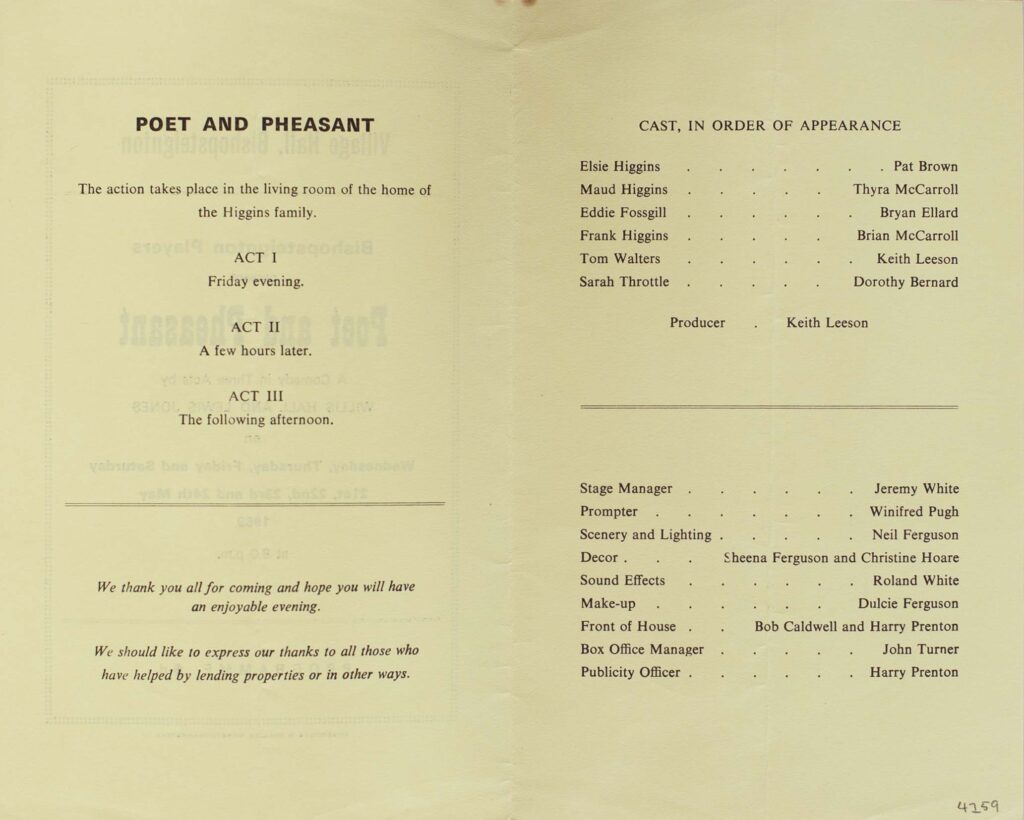
Programme for the play ‘Poet and Pheasant’, May 1969.
We know little about this production, so if you have any information please let us know.
In Decemner 1969 the Players presented an entertainment entitled ‘The Bishop’s Candlestick’, based on a story within a story.
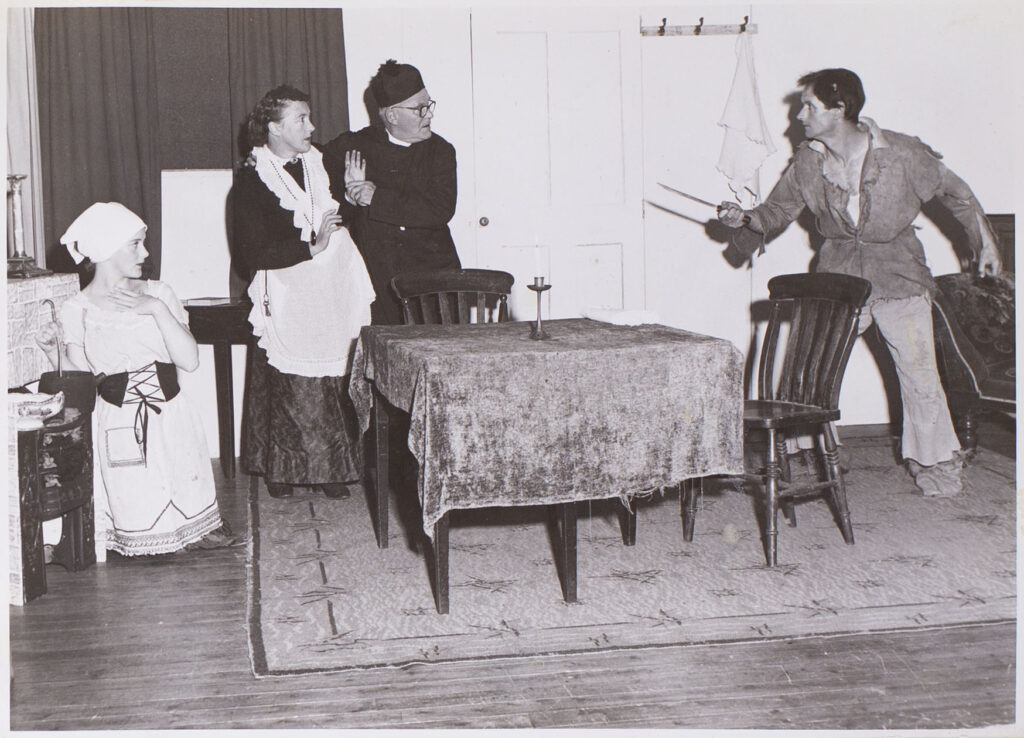
A scene from ‘The Bishop’s Candlesticks’, Dec 1969.
Again we have little information about this production, so any further information would be very welcome.
COMING SOON. Look out for our next publication about Bishopsteignton Players, providing an insight to the
Bishopsteignton Players through the 2000’s productions written by Pat Yesin, and titled Bishopsteignton Players Memoir.
.
